Throughout this project my intention is to explore the materiality of clay sourced from deep under the ground- to gather it, experiment with it and process it both in the cave and in the workshop. I aim to test myself and the material; to push myself out of my comfort zone, to connect with an environment that is unfamiliar to me whilst at the same time questioning the qualities of cave clay.
Beta project summer 2024
I come from a family of outdoor enthusiasts having grown up in Holmfirth on the edge of The Peak District. From an early age I was dragged around the moors, hills and dales of Derbyshire, climbing on rocks, walking up hills and exploring natural landscapes.
One thing I always manage to evade was going underground, believing this was too frightening and difficult for me, and something to be left to my dad, uncle and brother. It wasn’t until this summer that I began to feel that it was accessible for me when my dad invited me on one of his caving trips and I realised another world existed under our feet.
As I descended nervously into my first cave, my eyes were opened to the possibilities of an environment so solid yet fragile, so cavernous yet claustrophobic, surrounded by thousands of years of evolution. Being deep underground is a unique experience. Caves can be hostile places to explore: wet, slippery, cold and dark where sounds carry, bouncing off the rocks, but when silence descends, it feels like you are enveloped in a comfort blanket. Caving is a sport few people experience, it is mentally emotionally and physically challenging, however the rewards are beautiful.
My uncle has worked in cave exploration for over forty years, discovering and mapping cave systems all over the world. One of his recent projects has been to assess a new cave system previously unexplored in the Peak District. His team has spent months trying to open up new passageways by digging through small openings in the rocks.
This results in large amounts of debris which has to be removed. It is essentially waste clay, full of stones, mud, tiny animal bones and silt. It gets bagged up, hauled out of the cave and dumped by the entrance.
I decided to focus my summer project on this waste clay. I wanted to investigate the qualities of the material and discover whether it was possible to work with it.
Cave Exploration
The landscape down in the cave is very unique, and unlike any landscape I have seen before. Caving is a way of exploring land below surface level, to discover raw earth and to learn new ways of moving within the rock and land.
Around 1.8 million to 10,000 years ago, there was lots of glacial activity in Britain. This caused rivers, made from the melt-water (from the melted ice and snow) to carve out and deepen the valleys in the Peak District. This erosion exposed the limestone, which is where the caves form. There is evidence that the caves in the Peak District were formed over at least four time periods and each time a new cave would be created deeper into the limestone.
The beginning stages
I removed as many of the large stones/rocks that I could at home, and with the help of my dad, we began soaking the clay and sieving it. However, as I was just working at home with limited materials, I wasn't able to do this properly, so many small stones were still in the clay.
I made a number of small, same size and thickness tiles that I would begin to test the firing qualities with.
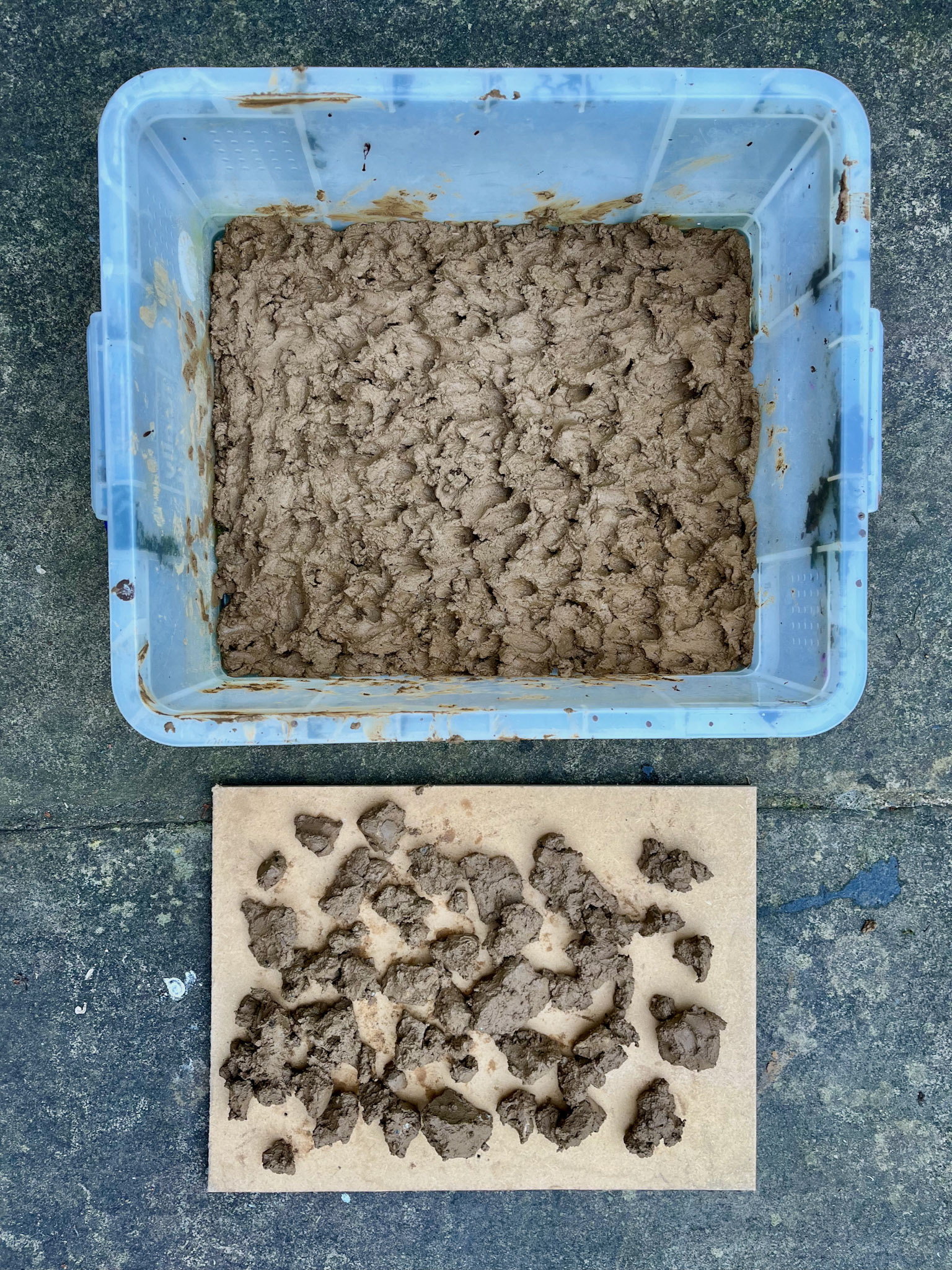
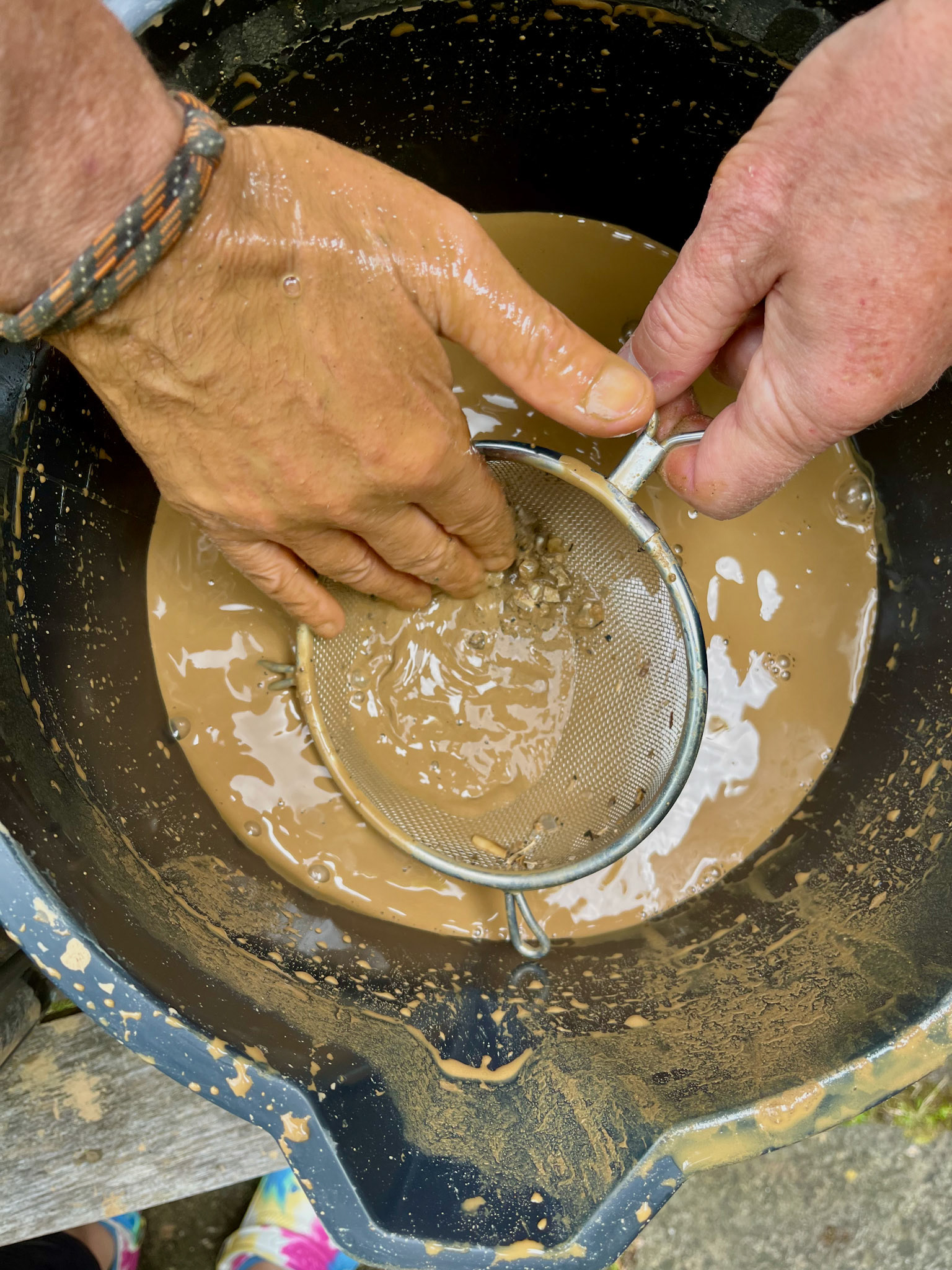
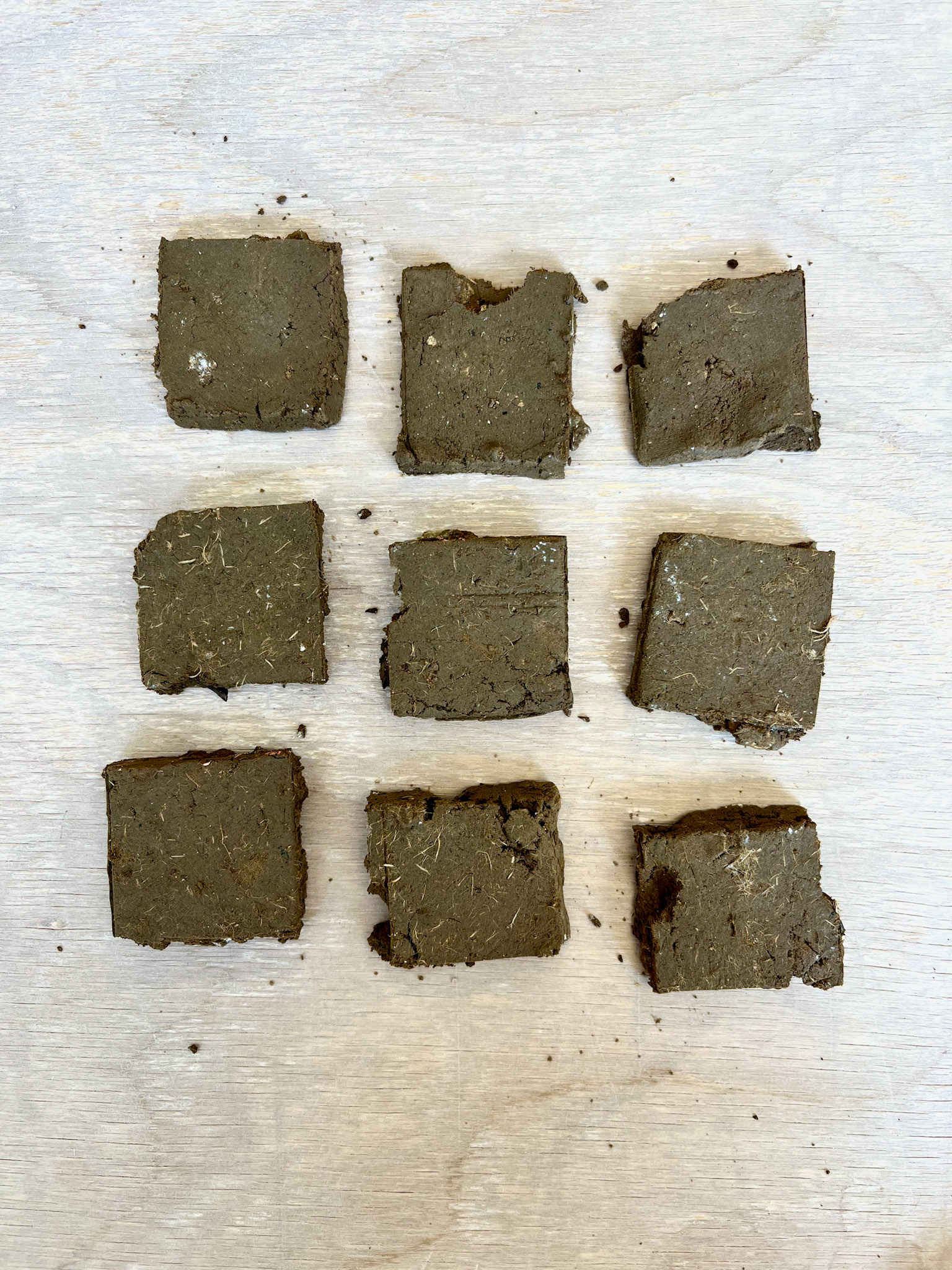
Email conversation with the ceramics technicians
I emailed Rudi in June to ask whether it would be possible to come into ceramics in order to test the clay that I had got from the caves. He emailed back to say that he would generously be able to do some firing tests of the clay samples that I had. They did multiple firings of small test tiles that I had made, at bisque, earthenware and stoneware, and were able to observe the clay over the summer, examining its process. Thanks Rudi!
From the results, we came to the conclusion that this clay would begin to crack and disintegrate, no matter the temperature. This was mainly because this clay had not been processed and had a high content of stones in it. It was recommended that in order to be able to use this wild clay, I would have to fully process it, and fire at below 1200 degrees.

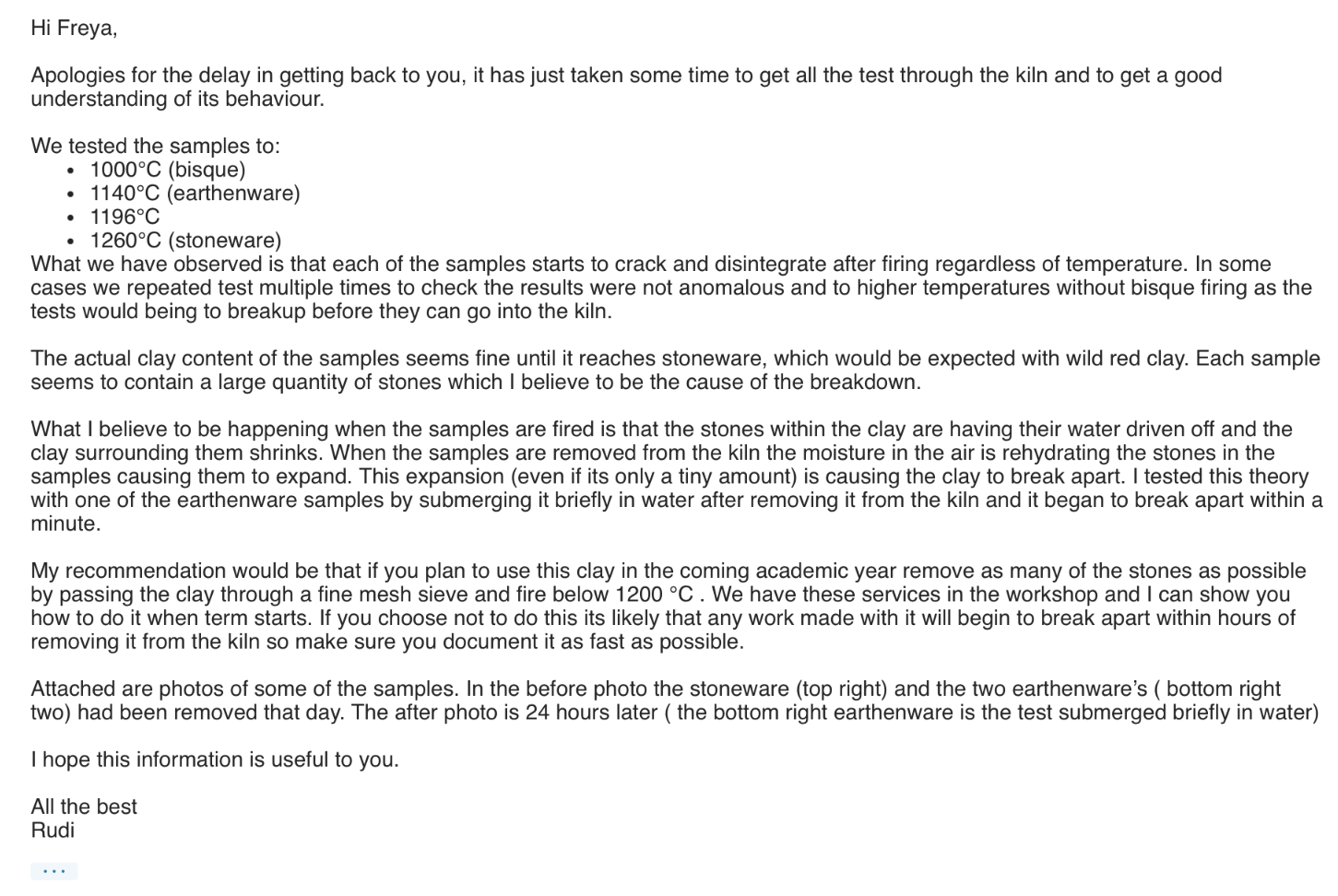
The clay samples which Rudi fired for me over the summer. The after photo is of the clay that had been submerged briefly in water. This is making the samples get rehydrated since being out of the kiln, meaning that they are expanding at a quicker rate and breaking apart almost instantly. To solve this, I am going to process the clay and make sure I am firing the clay with little to no stones in it.
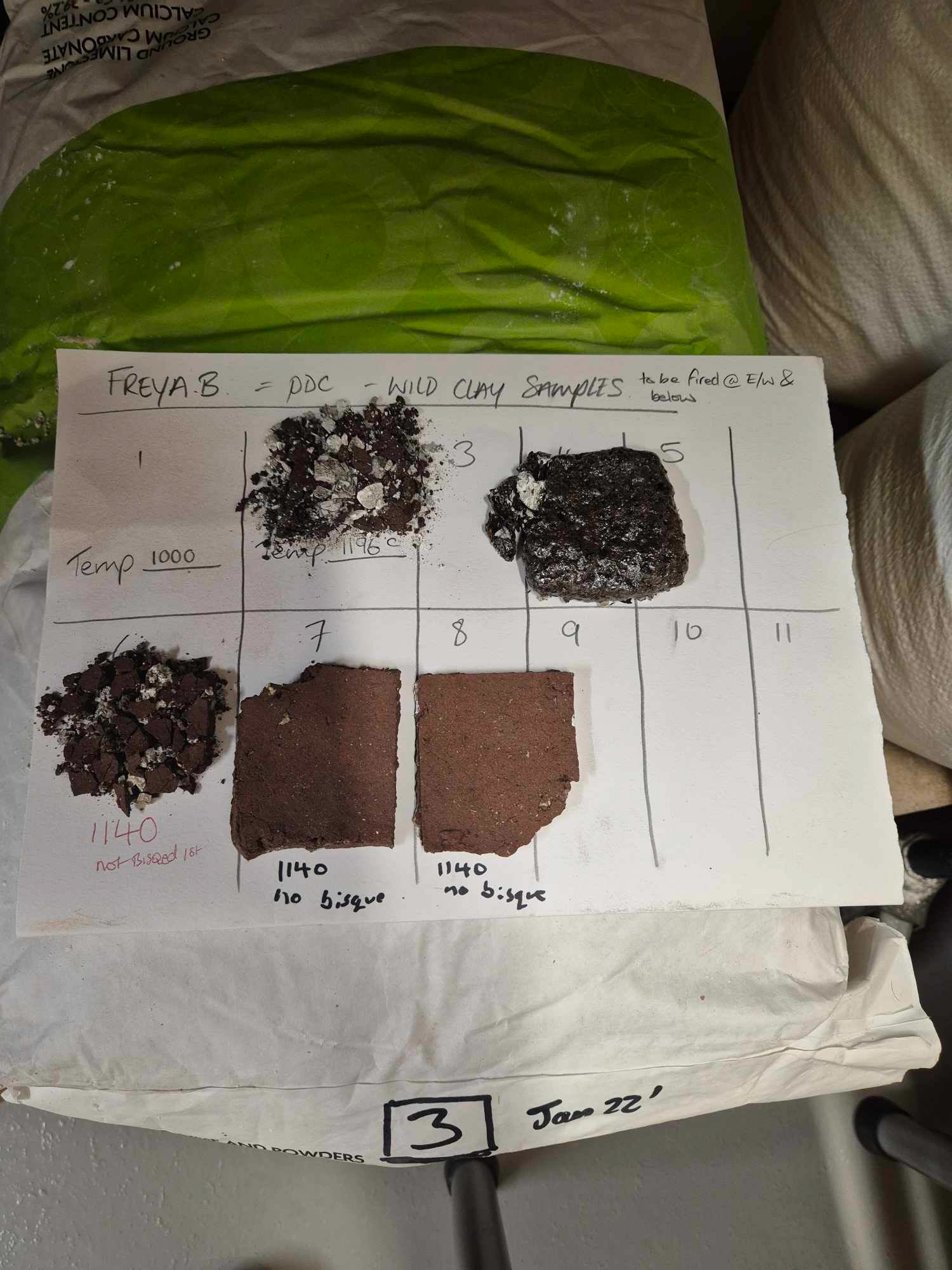
Before
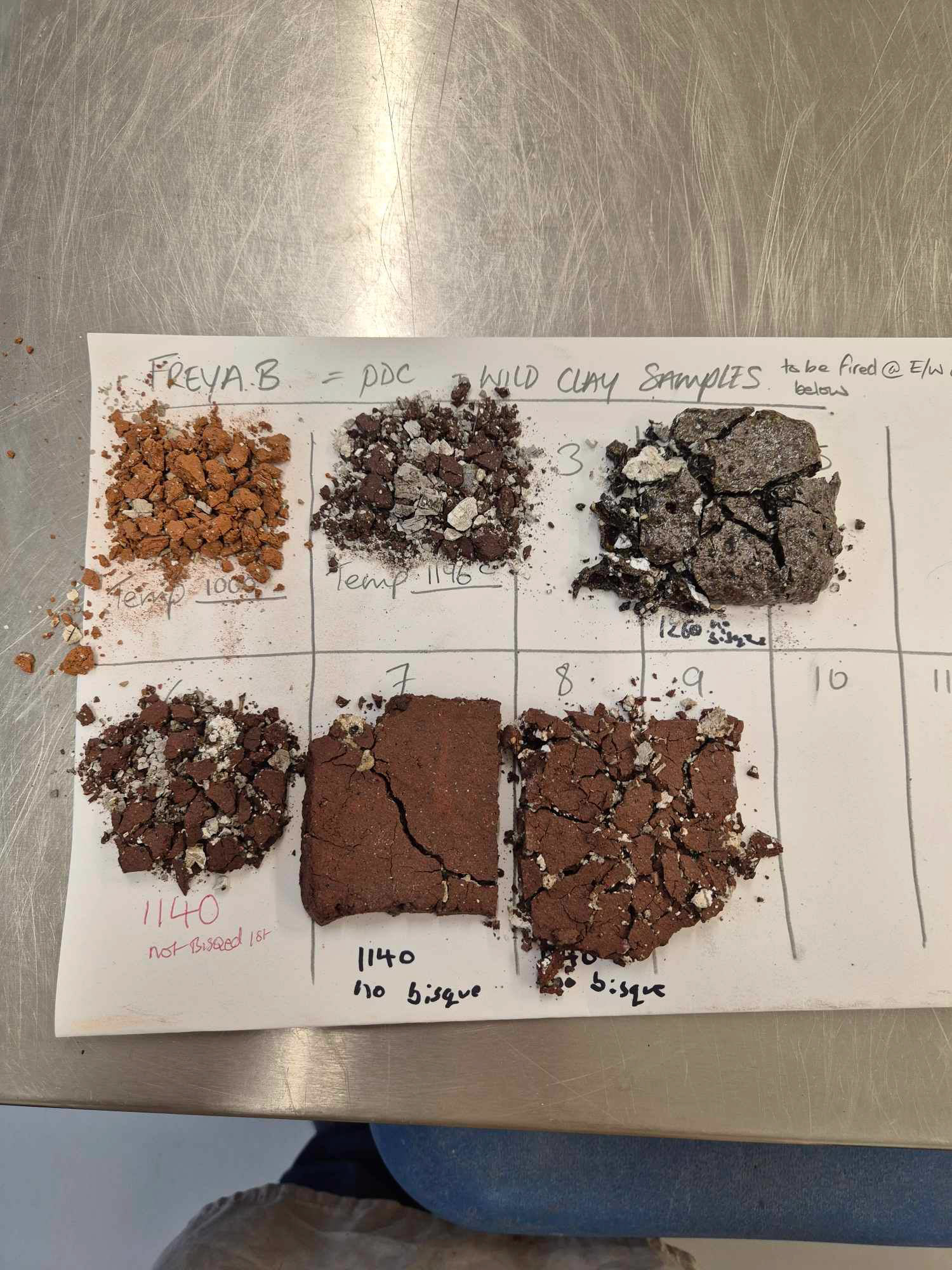
After 24 hours
Journey of ceramic throughout one week
Processing the qualities of a sample cave clay tile throughout the week, documenting its qualities and changes. With the smaller piece, I dunked it in cold water as soon as it came out of the kiln. By doing this, I noticed it started to disintrigate quicker then the tile that I did nothing with.

Monday
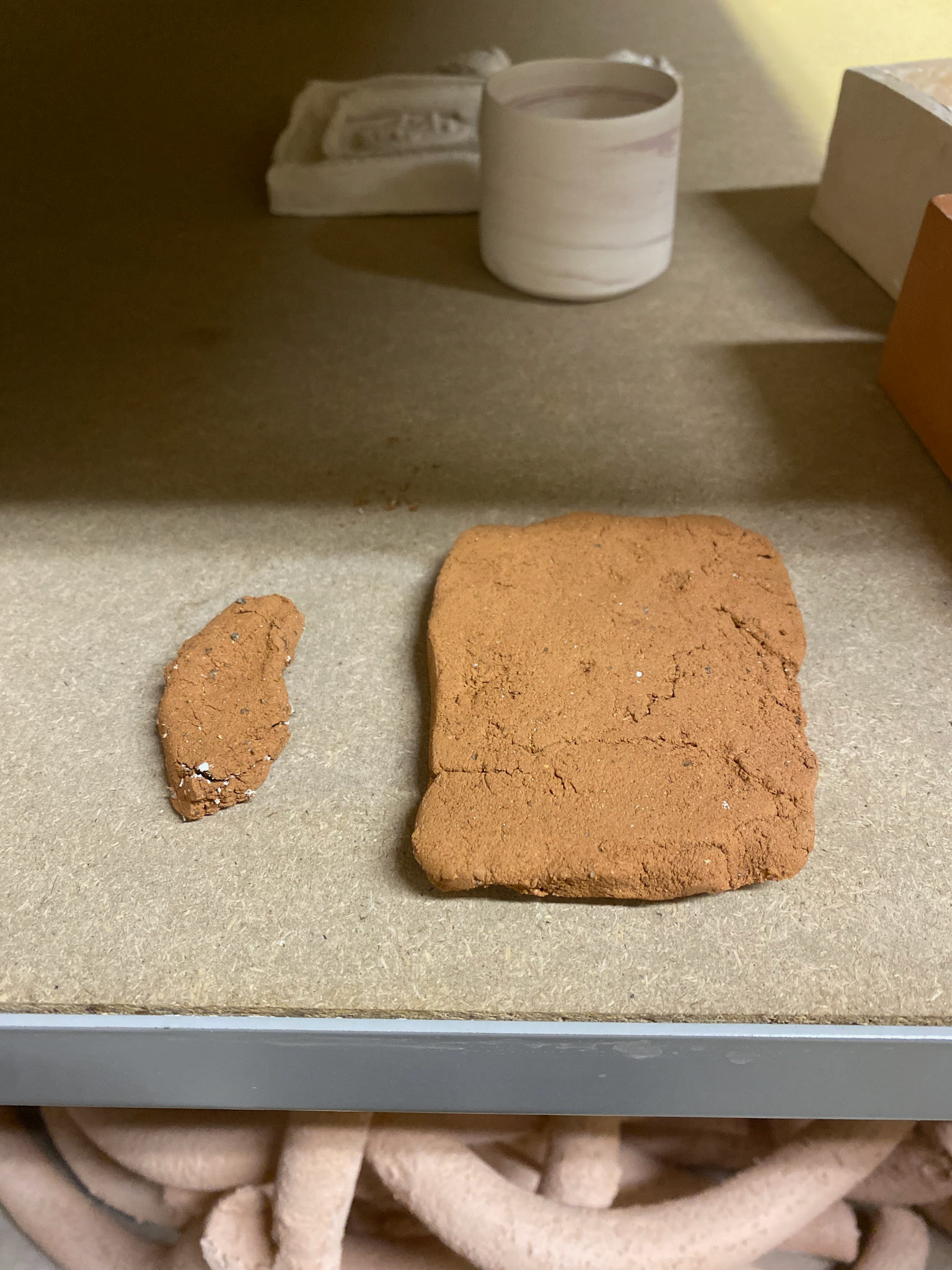
Tuesday
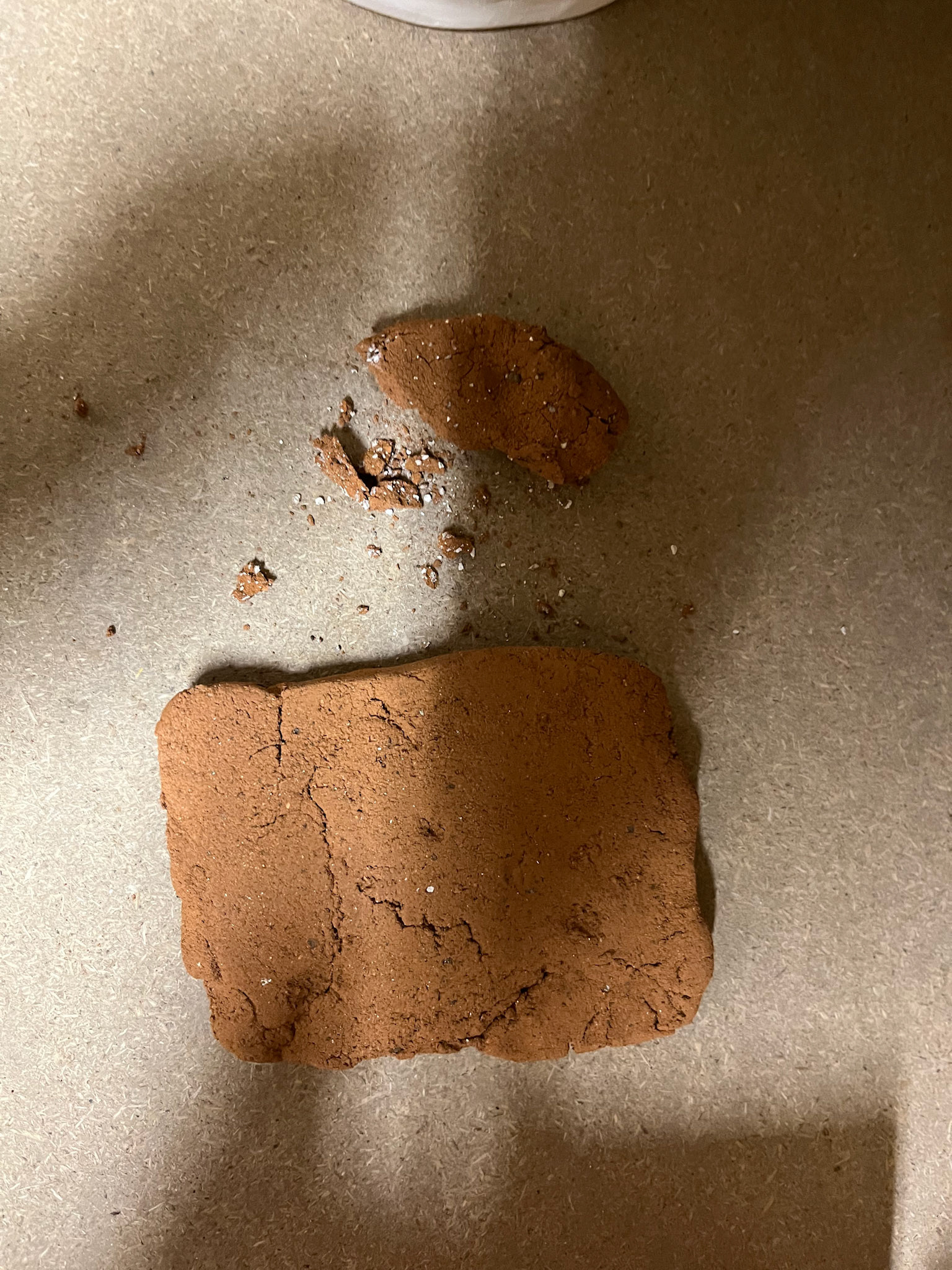
Wednesday
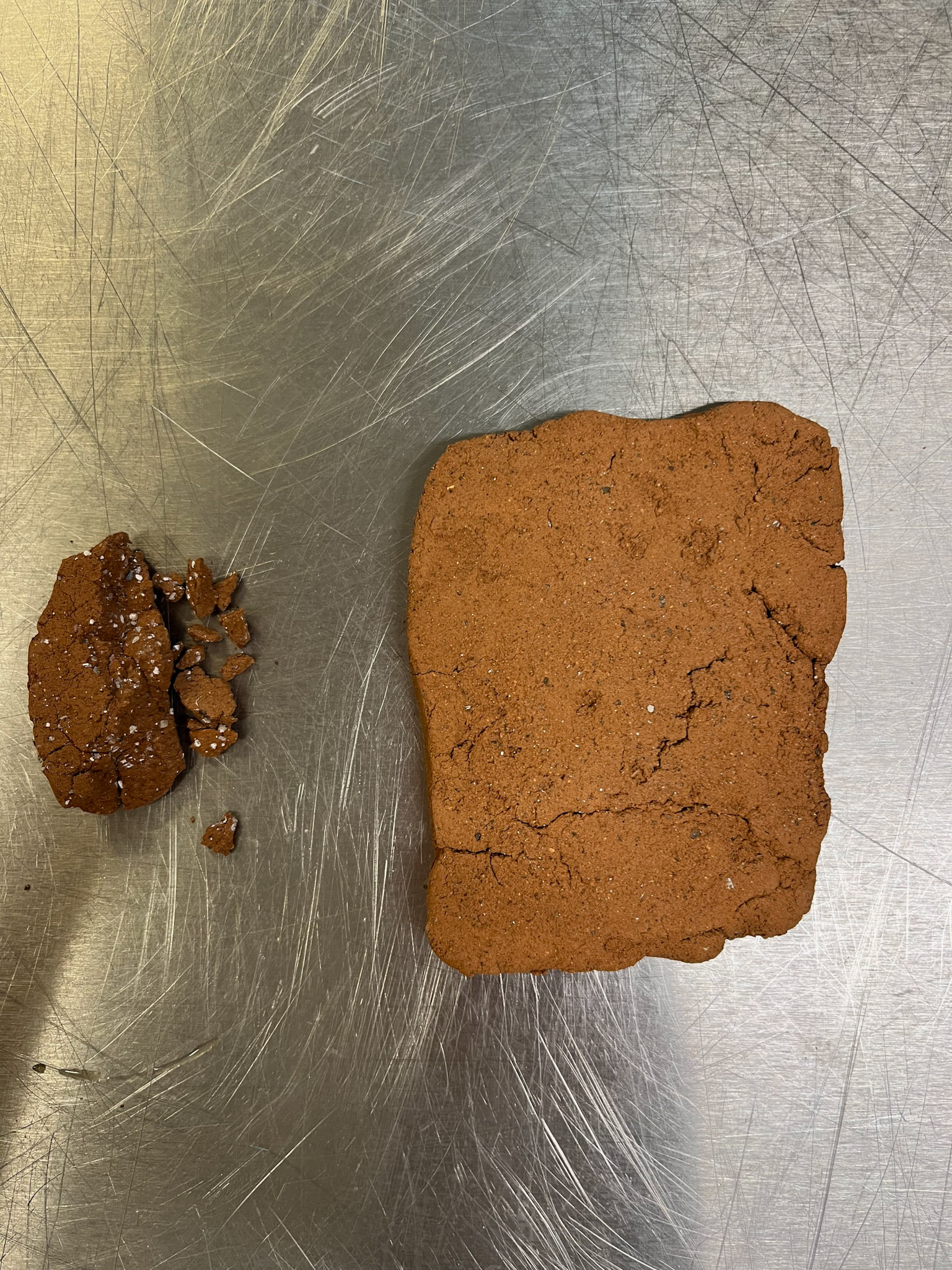
Thursday
New Cave clay
I was able to go down to a different cave in the Peak District than the one that my previous clay was from, to gather some clay myself. My dad, who has been caving in that cave many times, had said that the clay that was here seemed to be a lot smoother than the previous lot, and there was loads of it which were taking up space at the sides of the caves.
At the start of October, me and my dad went on a cave expedition in search of the clay. We were able to find loads of clay, however we were aware of not wanting to disrupt the environment of the cave in any way, so were mindful with the clay that we were sourcing. I was amazed at just how smooth this clay was, and also how much there was of it!
On this first dig, we had forgot to put the trowel in our bag to dig up the clay with, so I was digging the clay up and putting it in the bags with my hands. This was a cathartic experience as it made me connect more with the clay, and really get a feel for the material.
First trip down Cave 01/10/24
Stony Middleton, The Peak District
The sensations during this initial trip caving to find clay were unique; I was following the direction of my dad, who is a very experienced caver. He knows the cave we were in very well, as he has been caving in the Peak District and Yorkshire for over 40 years. I was following his lead to find the best areas in the cave to dig for clay. Before this cave trip, I had only been to show caves before, so these experiences were very new. I had expected to feel more claustrophobic, however I was very curious to explore the cave and move within the rock.
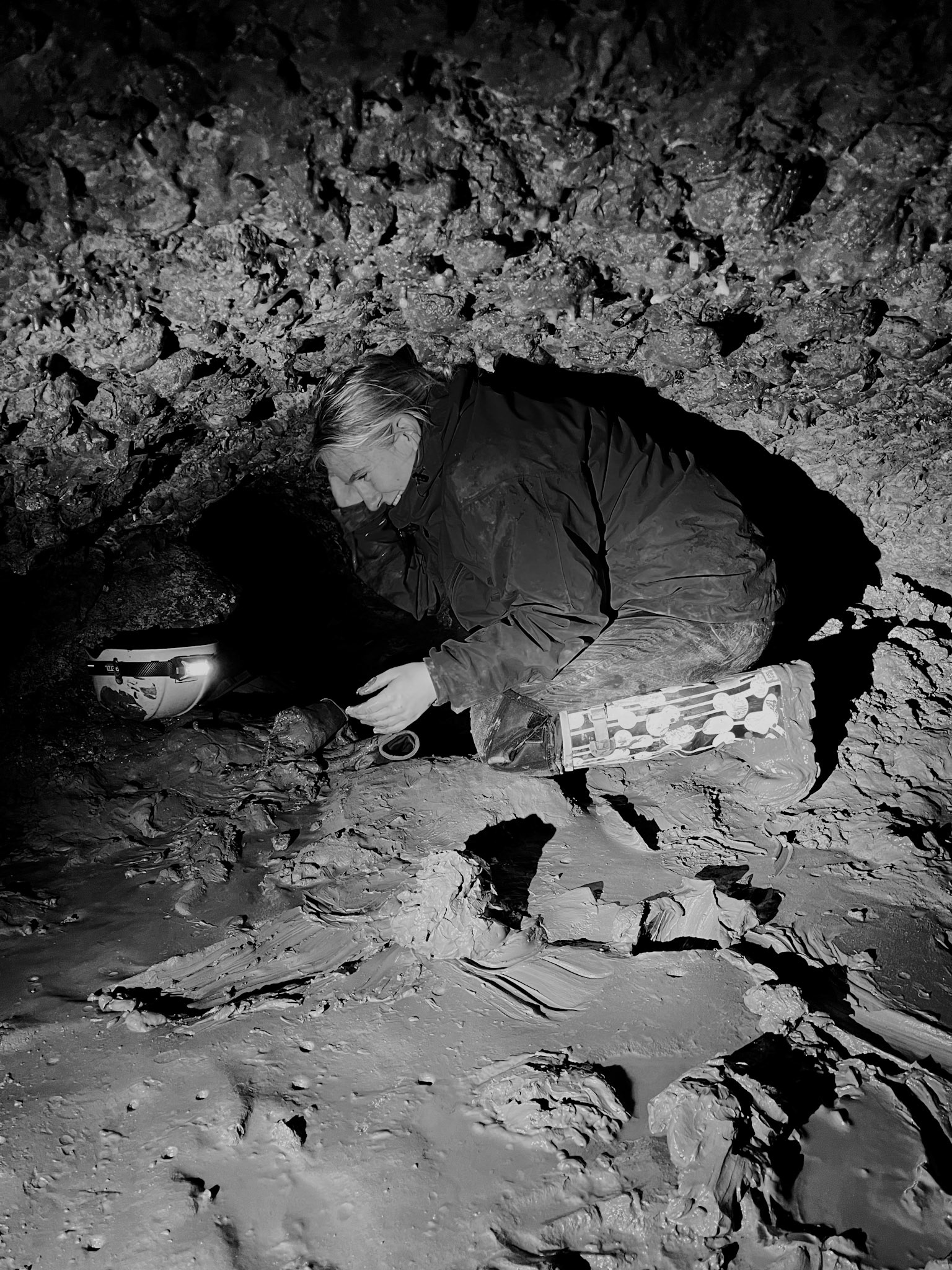
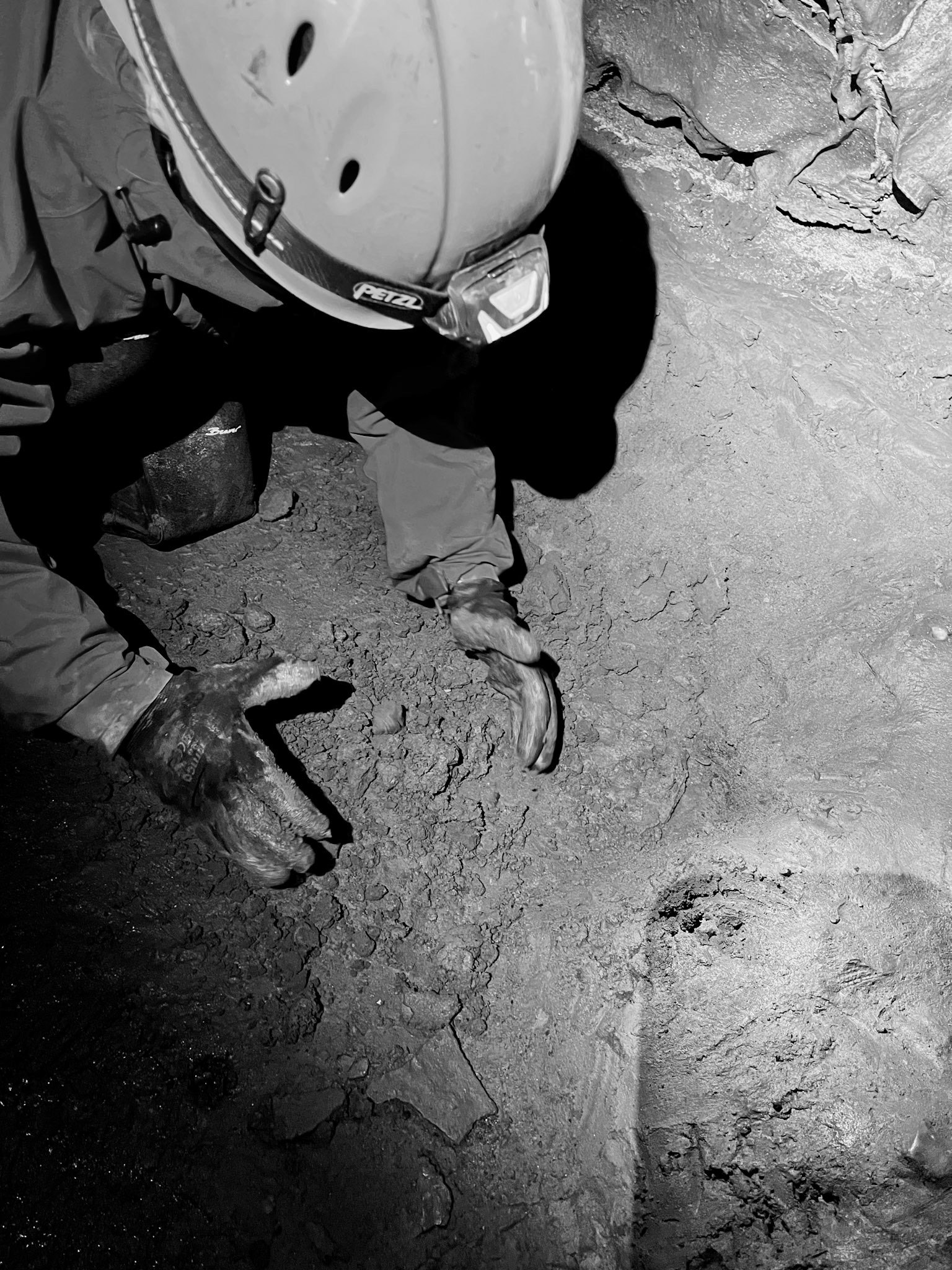

There are vast amounts of clay in certain areas of the cave. It is often under and to the side of puddles of water, so the clay has a high water quantity but it means that it is often very smooth and relatively easy to dig up, as it has a slip-like quality.
The clay in these caves, which is locally known as toadstone, is "formed from volcanic ash which settled on the seabed during the formation of limestone." (The Geology of Middleton Dale, 2014)
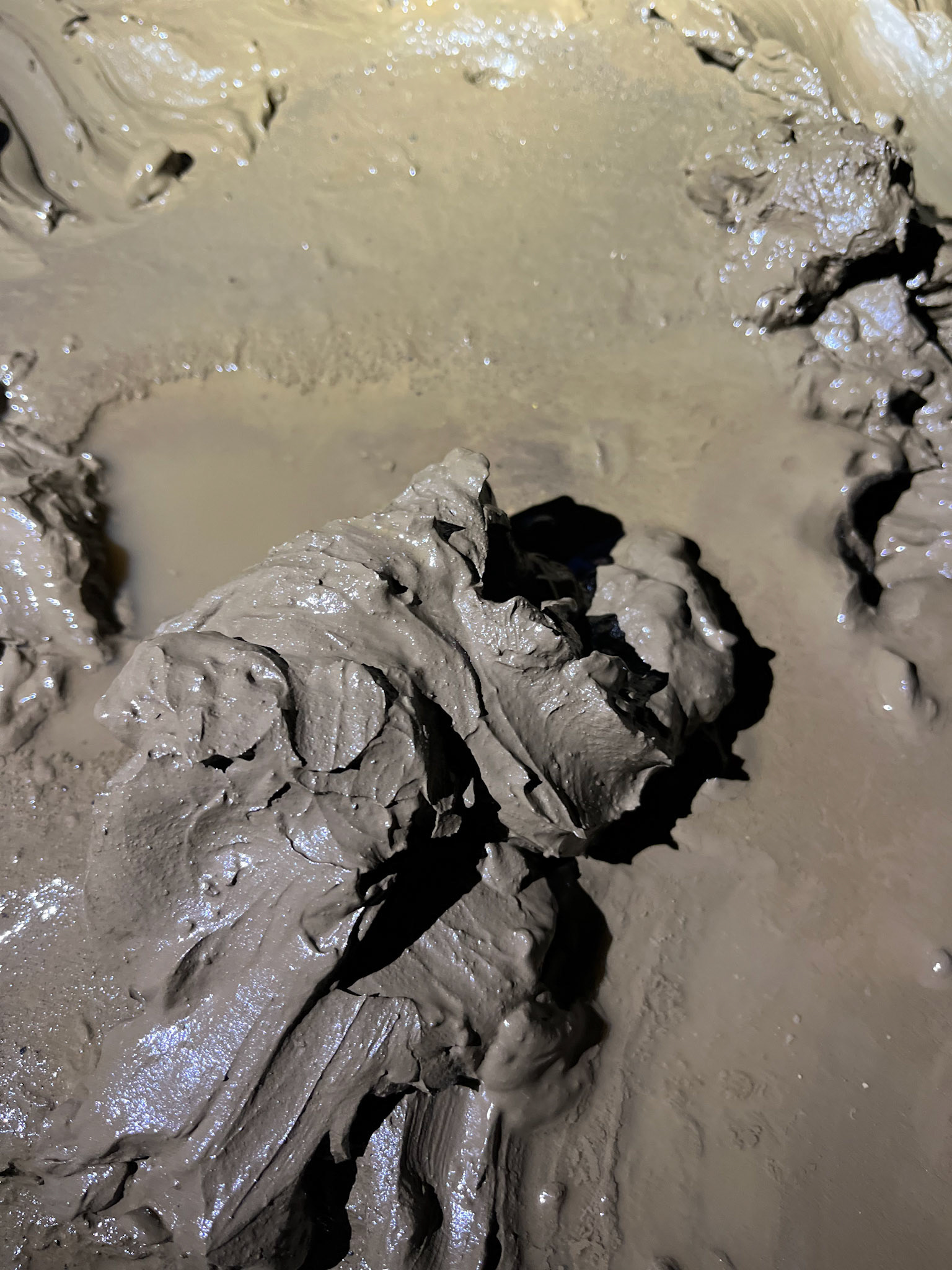
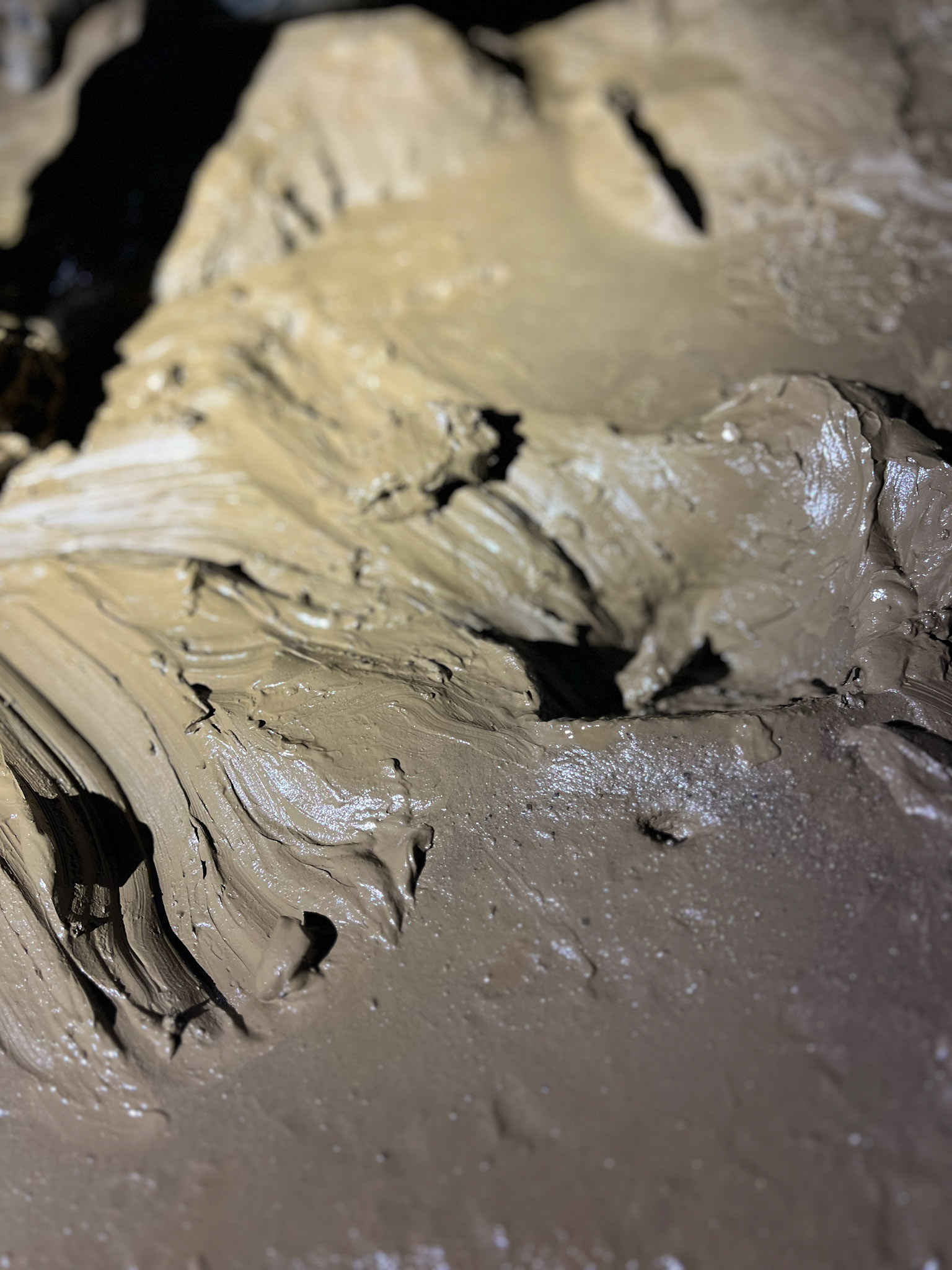
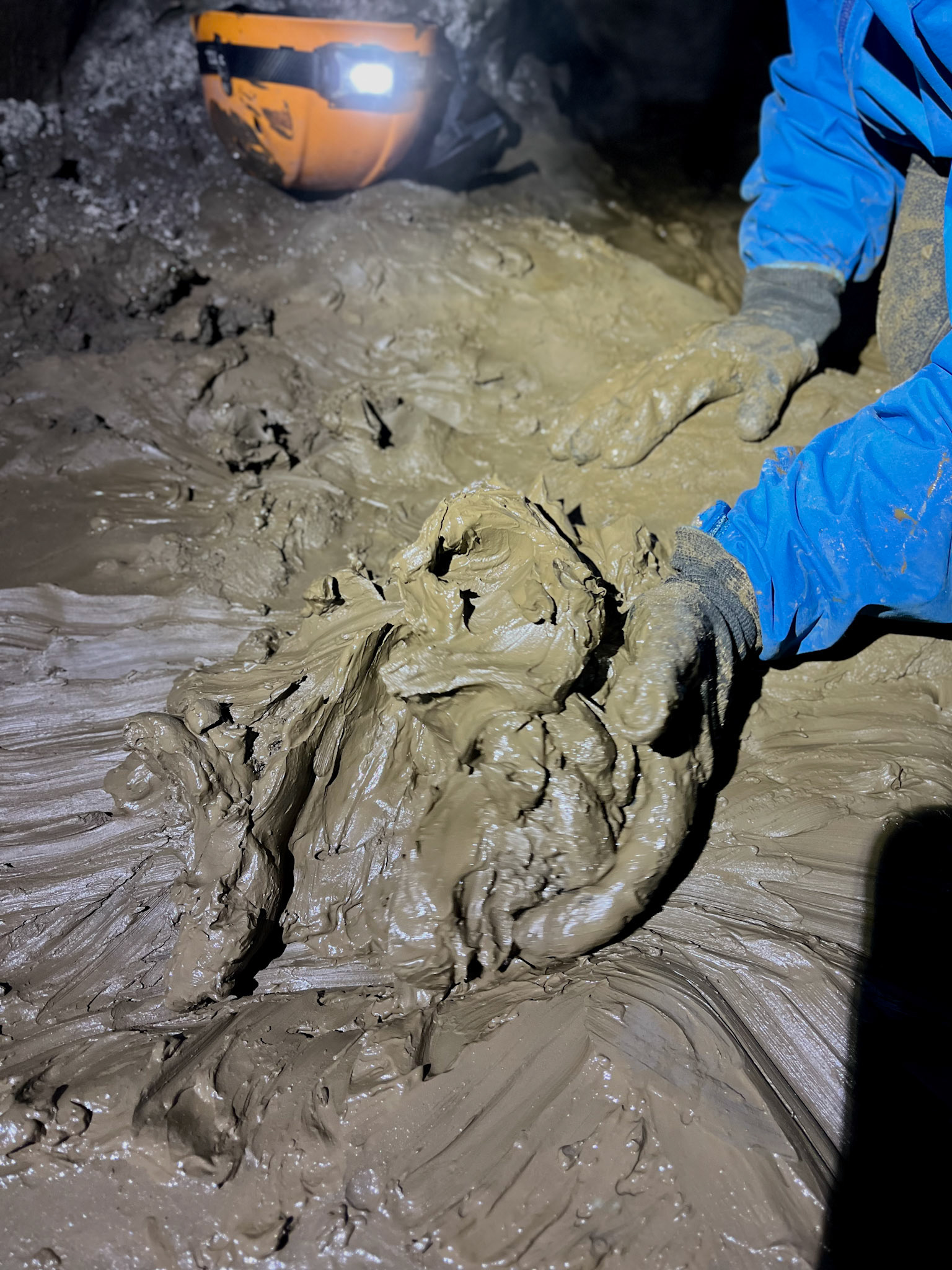
Cave Textures
Due to the caves being glacial, there are lots of textures on the surfaces of the clay walls. Rainwater percolates through the limestone in the cave, picking up calcium carbonate which in turn dissolves part of the limestone walls as it comes through the cave. When the water reaches the edges and roof of the cave, it starts dripping out, leaving small parts of calcium carbonate. These drips will then form features such as stalagmites and stalactites. The water flows over the rock, creating a calcium carbonate deposit flowstone over the rock. So each of the textures on the walls of the caves is formed from the calcium carbonate dripping and setting throughout millions of years.
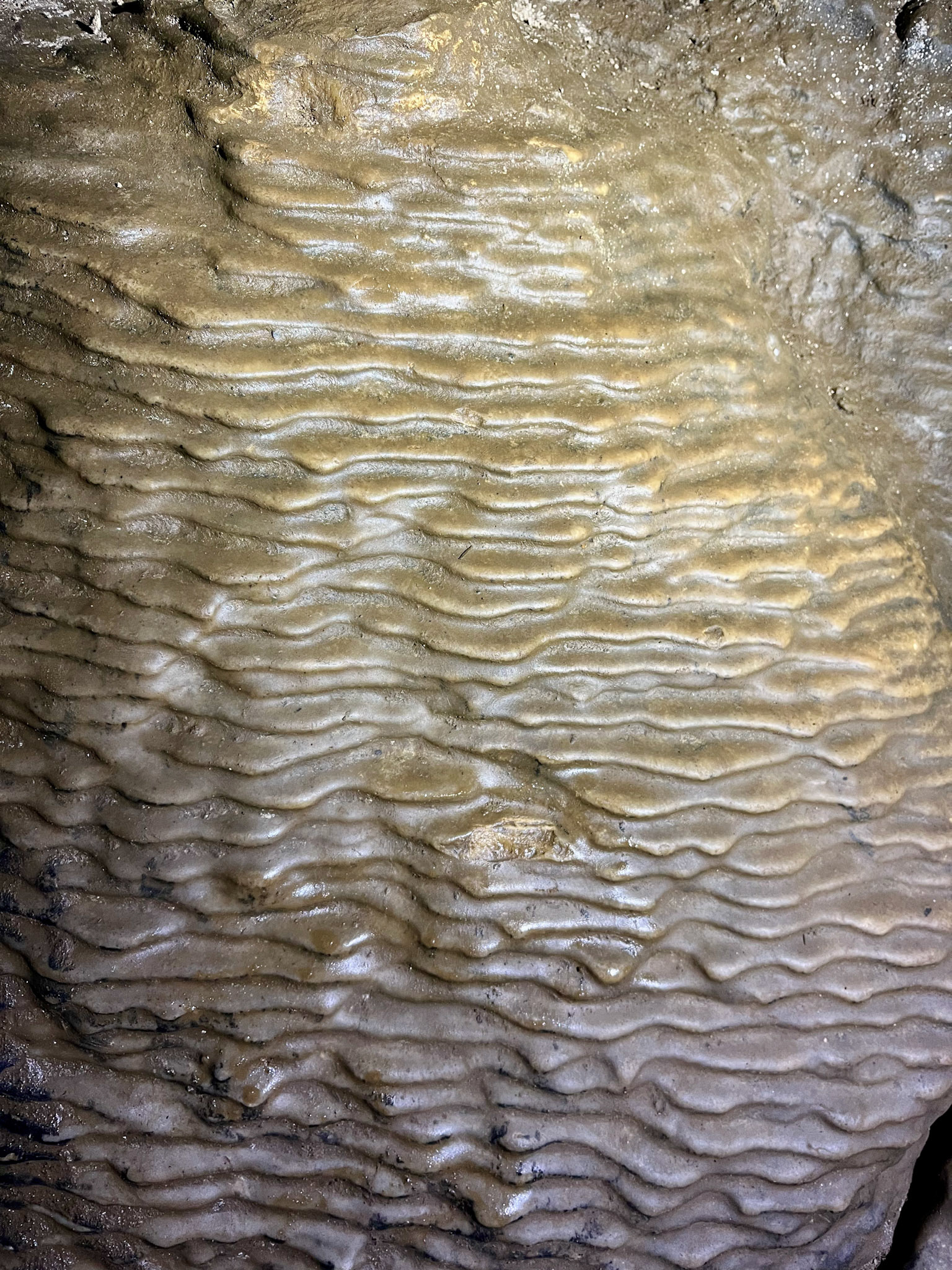
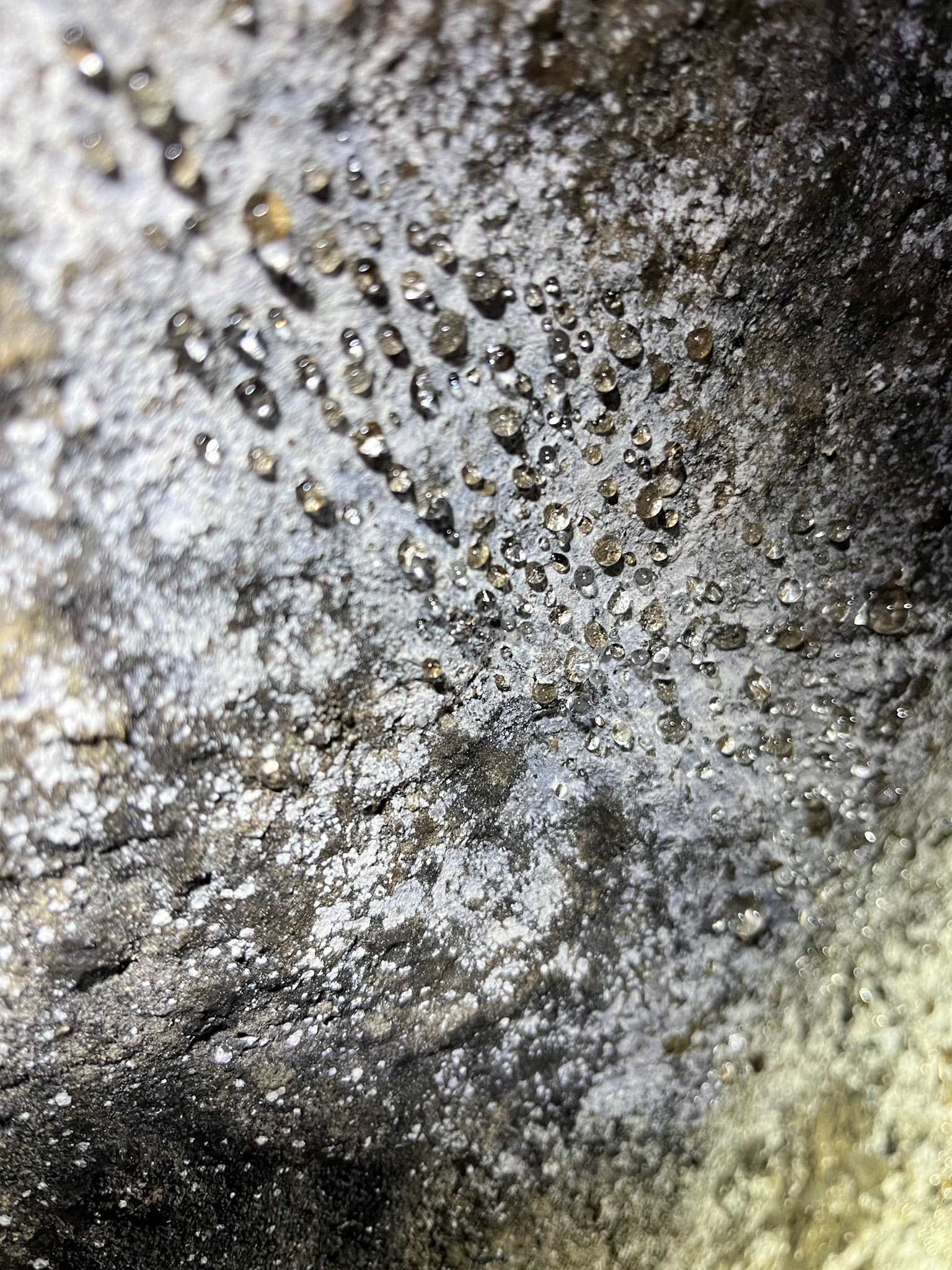

Process Reel
I made this process reel to show what it is like on my journey to find clay. During my research, I noticed there were hardly any videos on caving, and the majority of ones out professional cavers were squeezing through incredibly tight gaps in rocks and getting stuck. This is the main misconception of the sport of caving, and through my project, I am to show that caving is not just some extremely claustrophobic, scary and dangerous activity, but it can also be a beautiful way of exploring new, untouched, pure land.
Processing the Clay
I brought this new clay into the workshop (it was very heavy!) and started to work on it. I decided to fully process this batch of clay, as I wanted to learn the techniques of processing clay and the steps involved in this.
The first step was to lay the clay out on boards to let it fully dry and release all the moisture from the clay. The clay was quite wet but it was easy to work with.
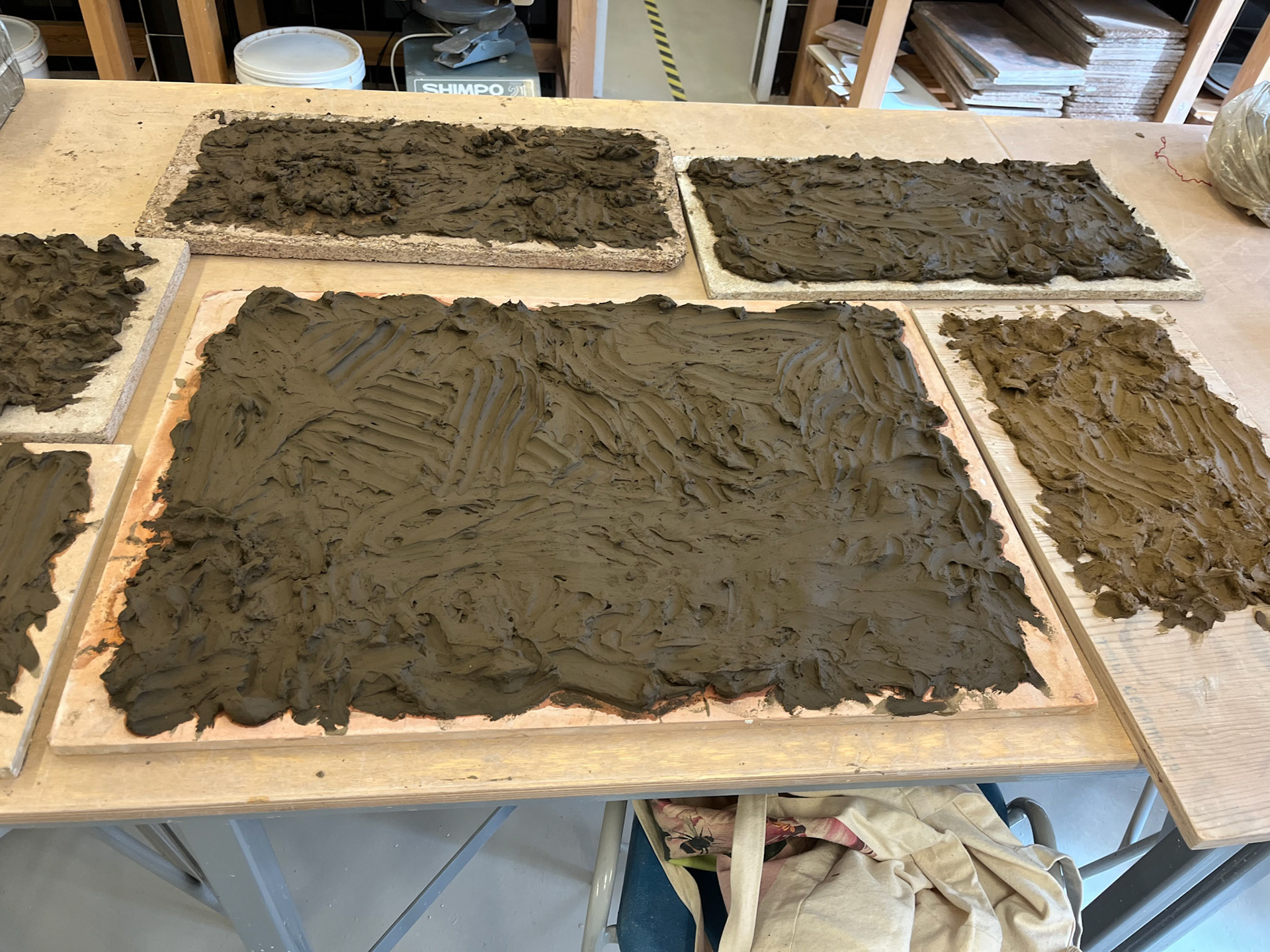
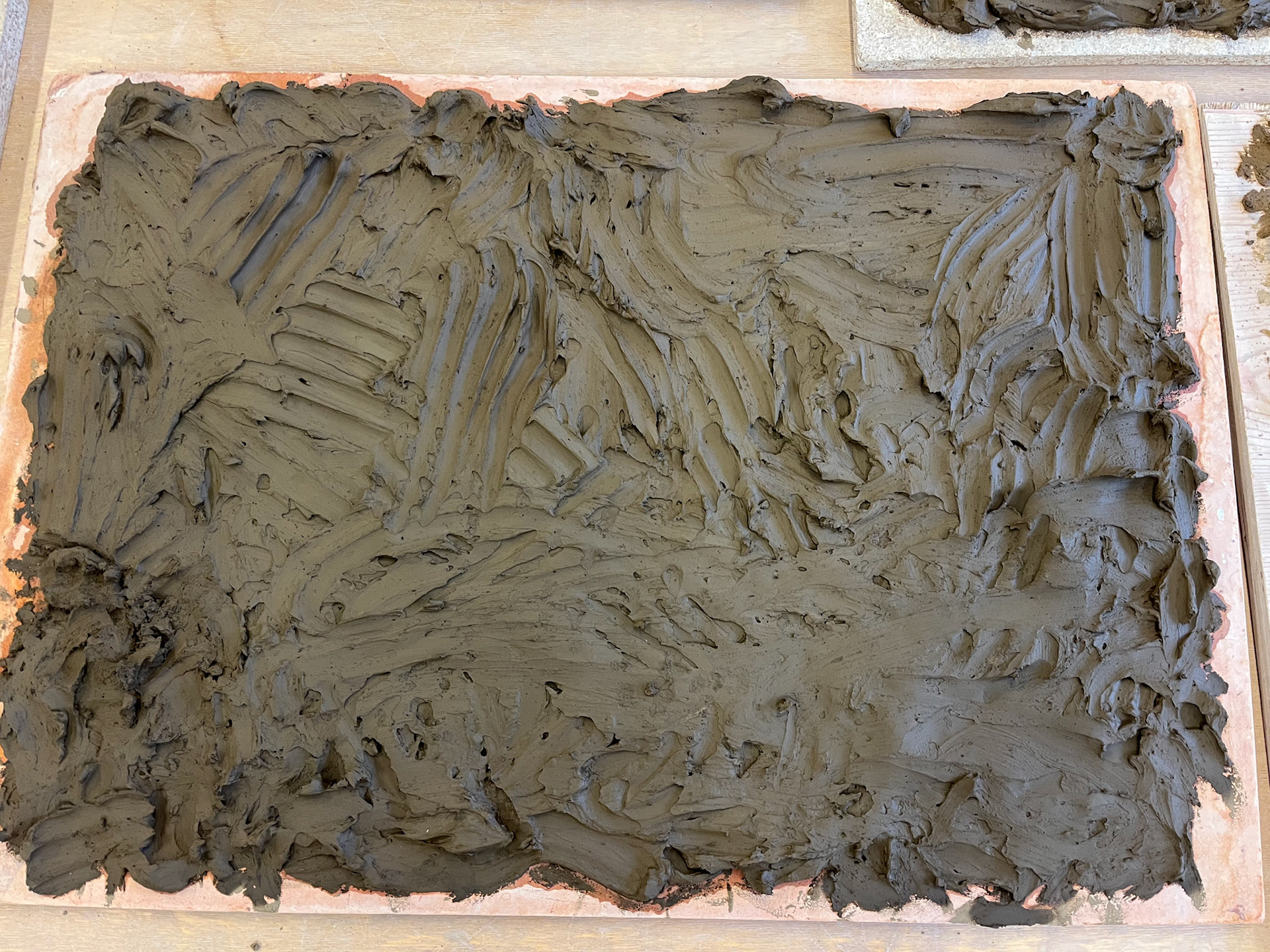
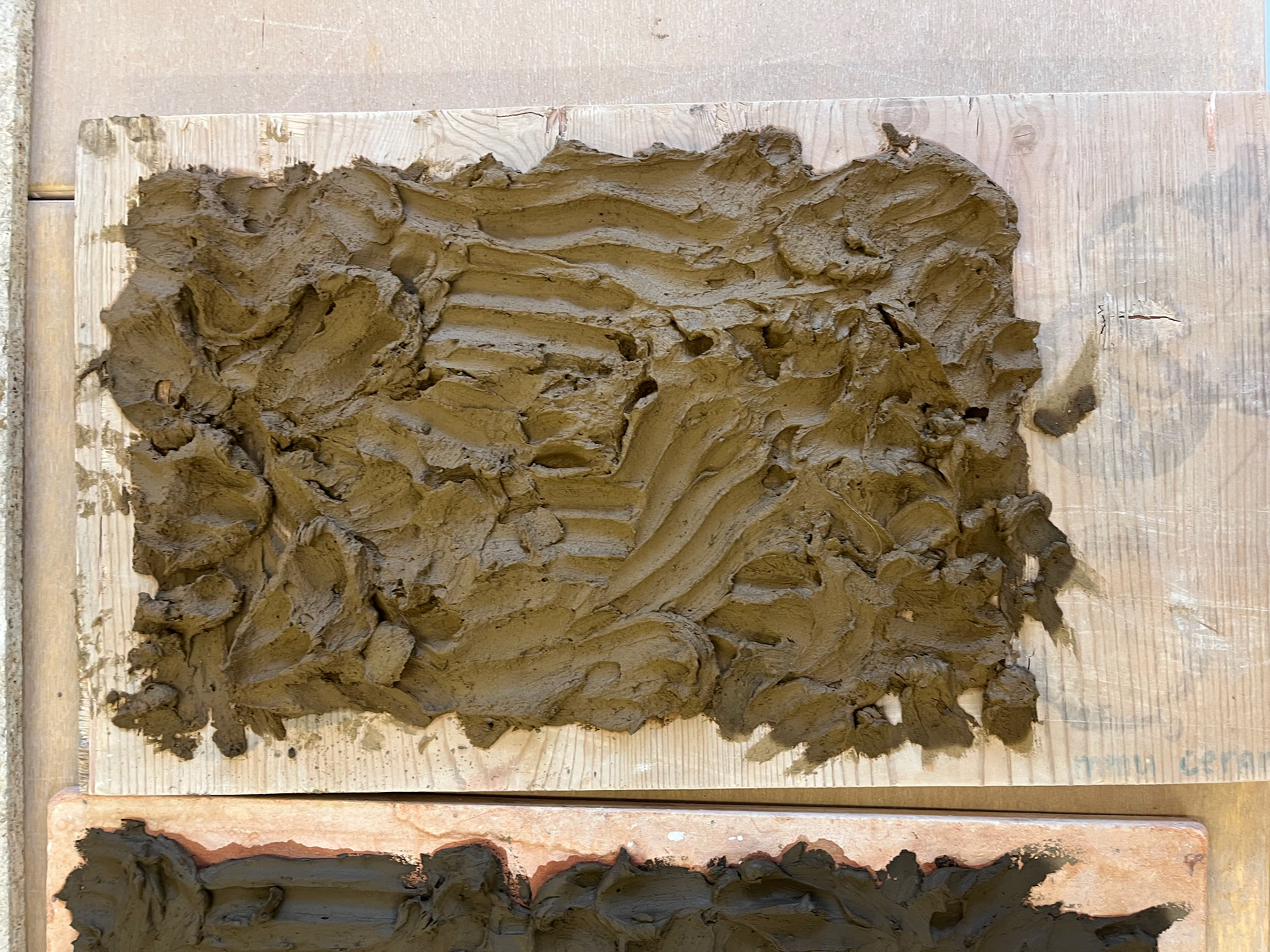
The clay is left for a couple of days, until it is completely dried out and cracking. It will go much paler in colour, and will start to peel off the boards.



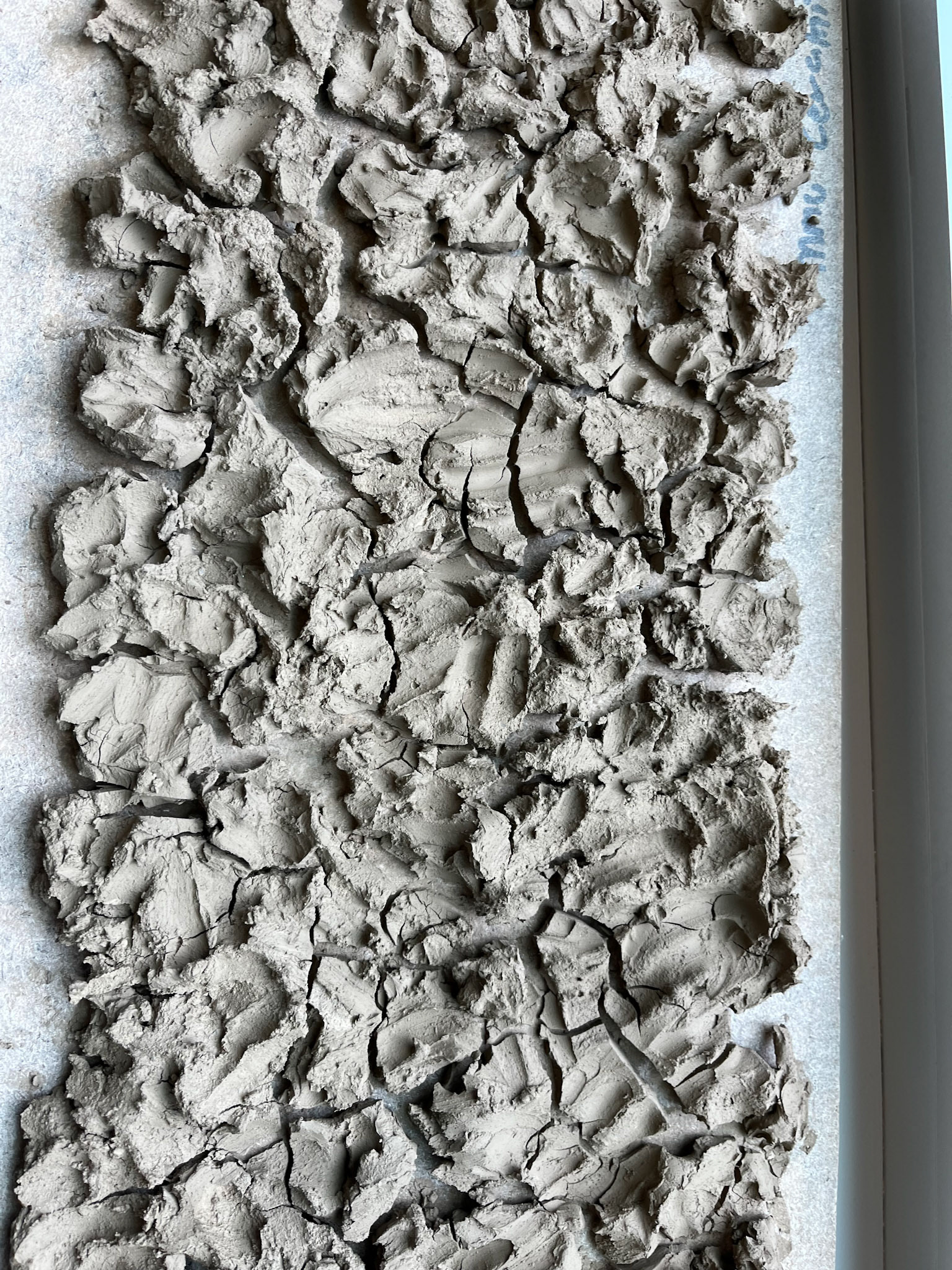
I then break up the clay into small pieces and put it into buckets.

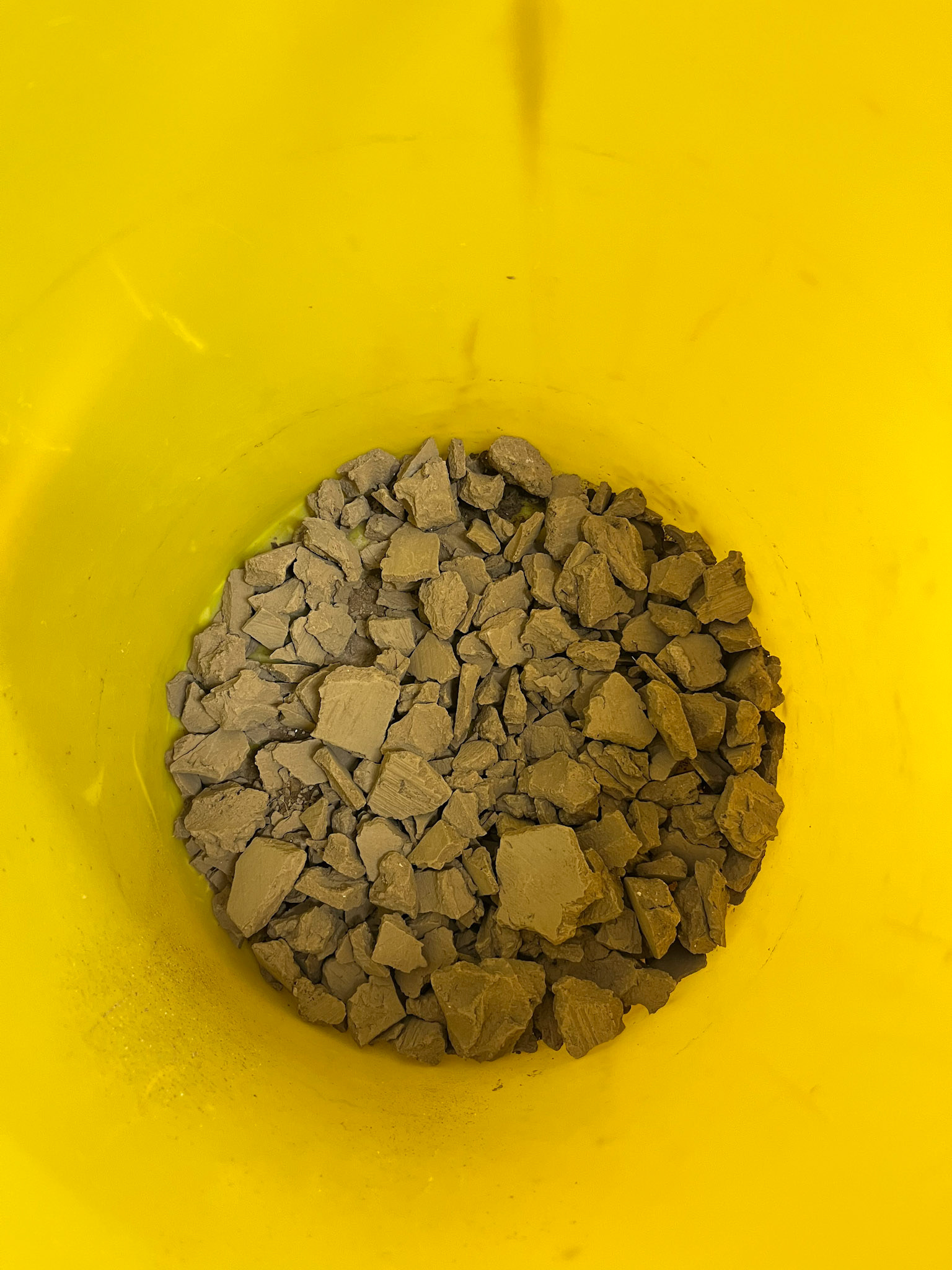
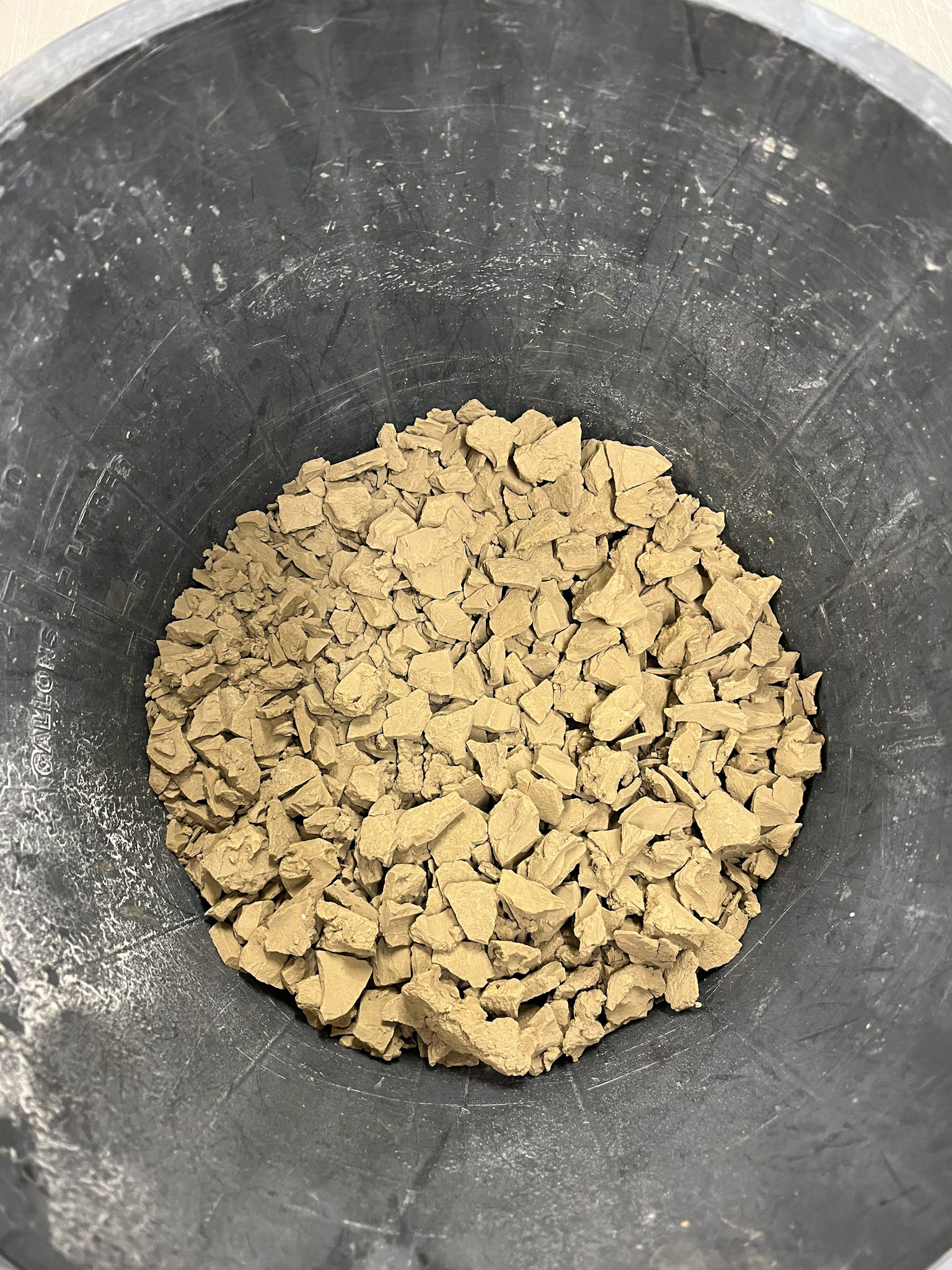
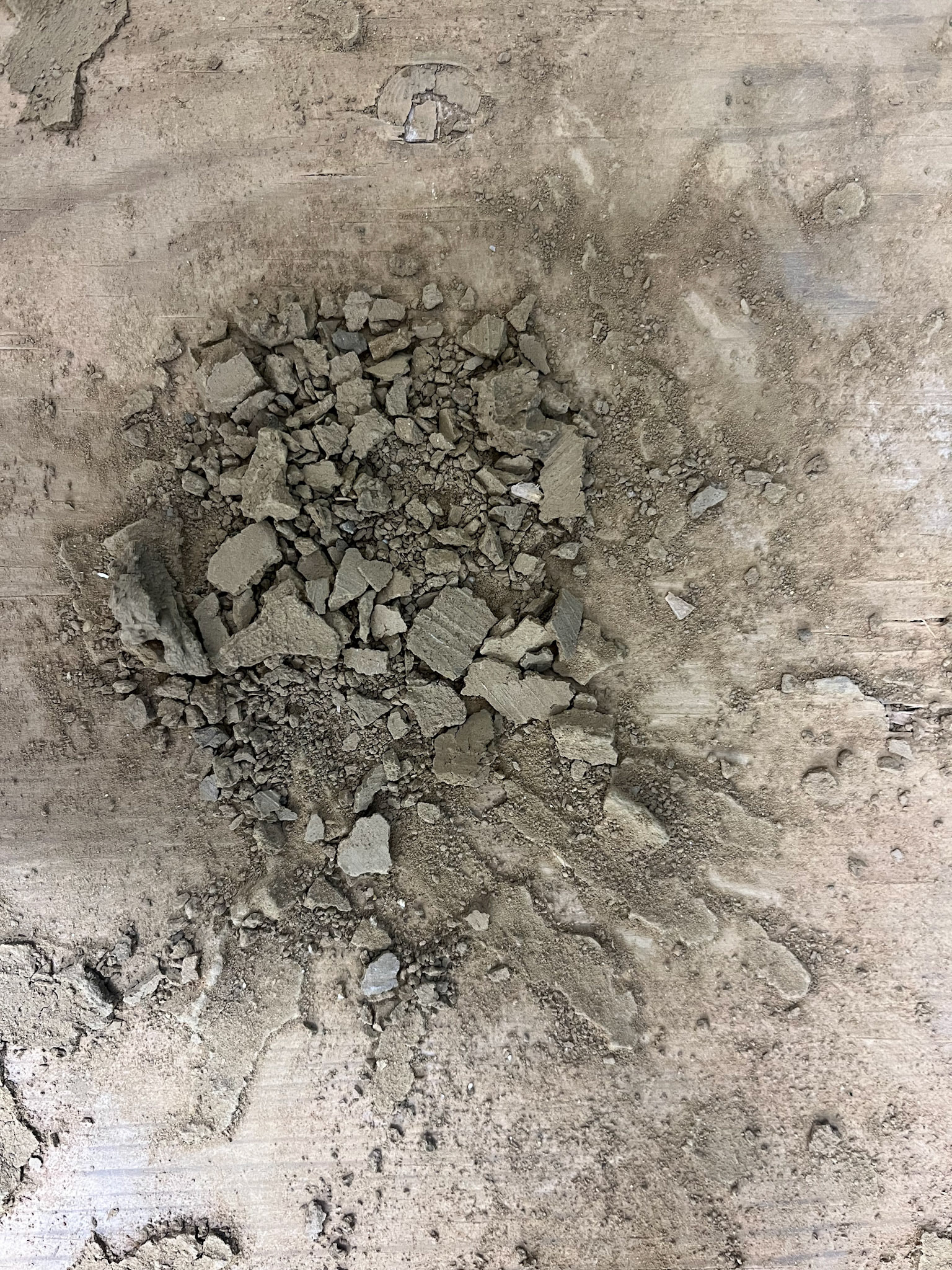
Next, I pour hot water in the clay pieces to cover it. It is then left for a few more days to absorb the water.
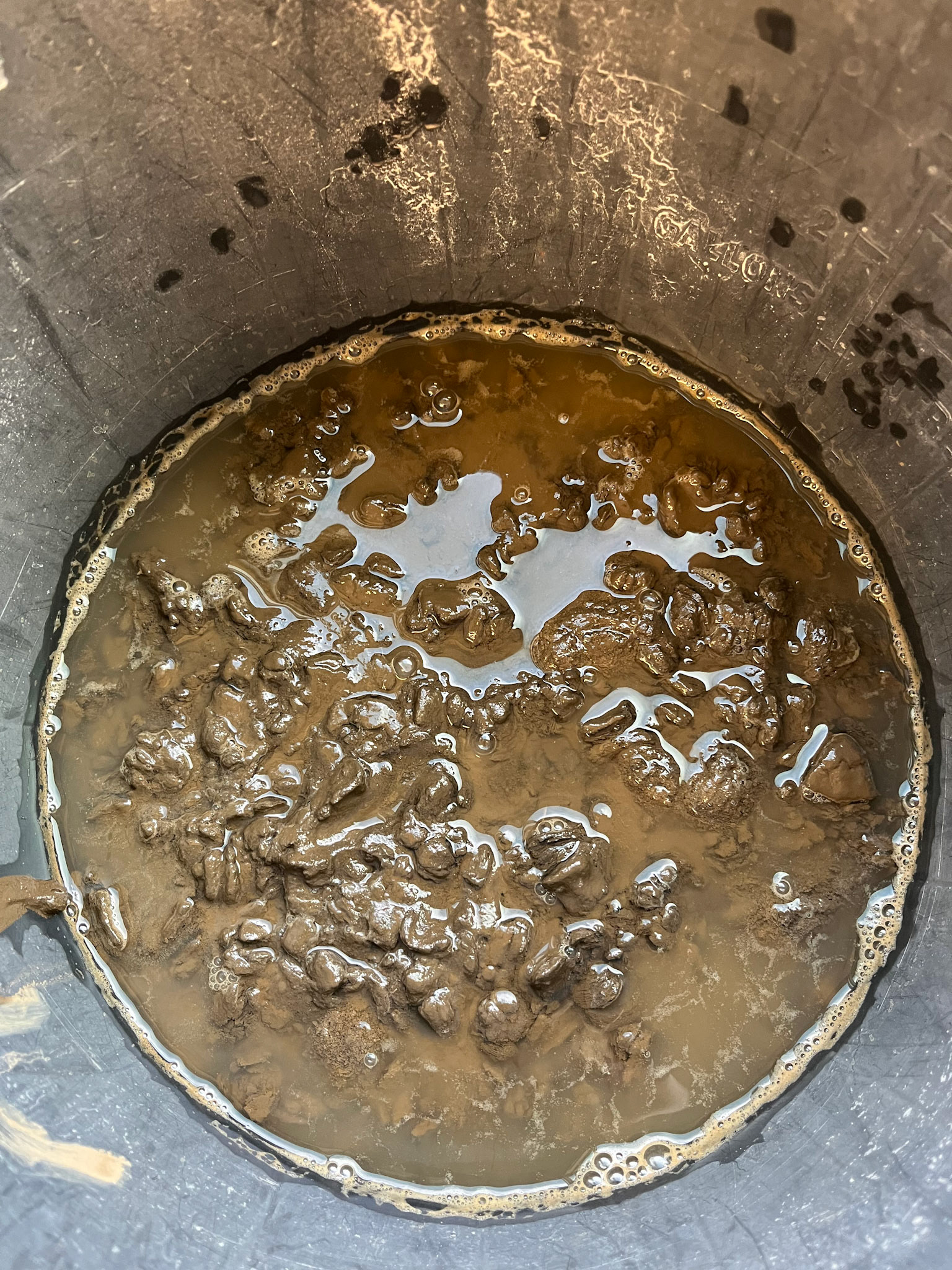


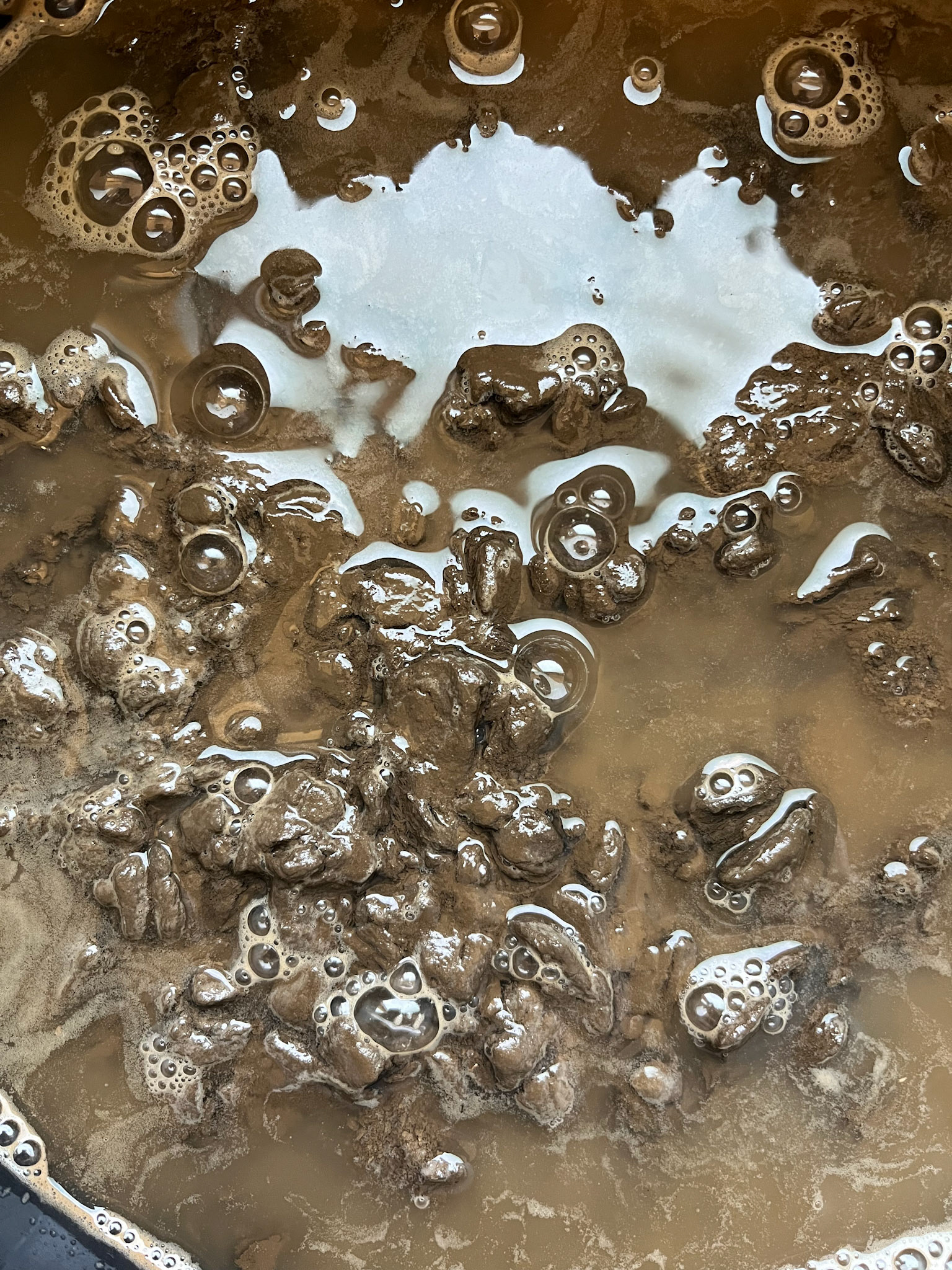
The clay turns into a slip like quality.
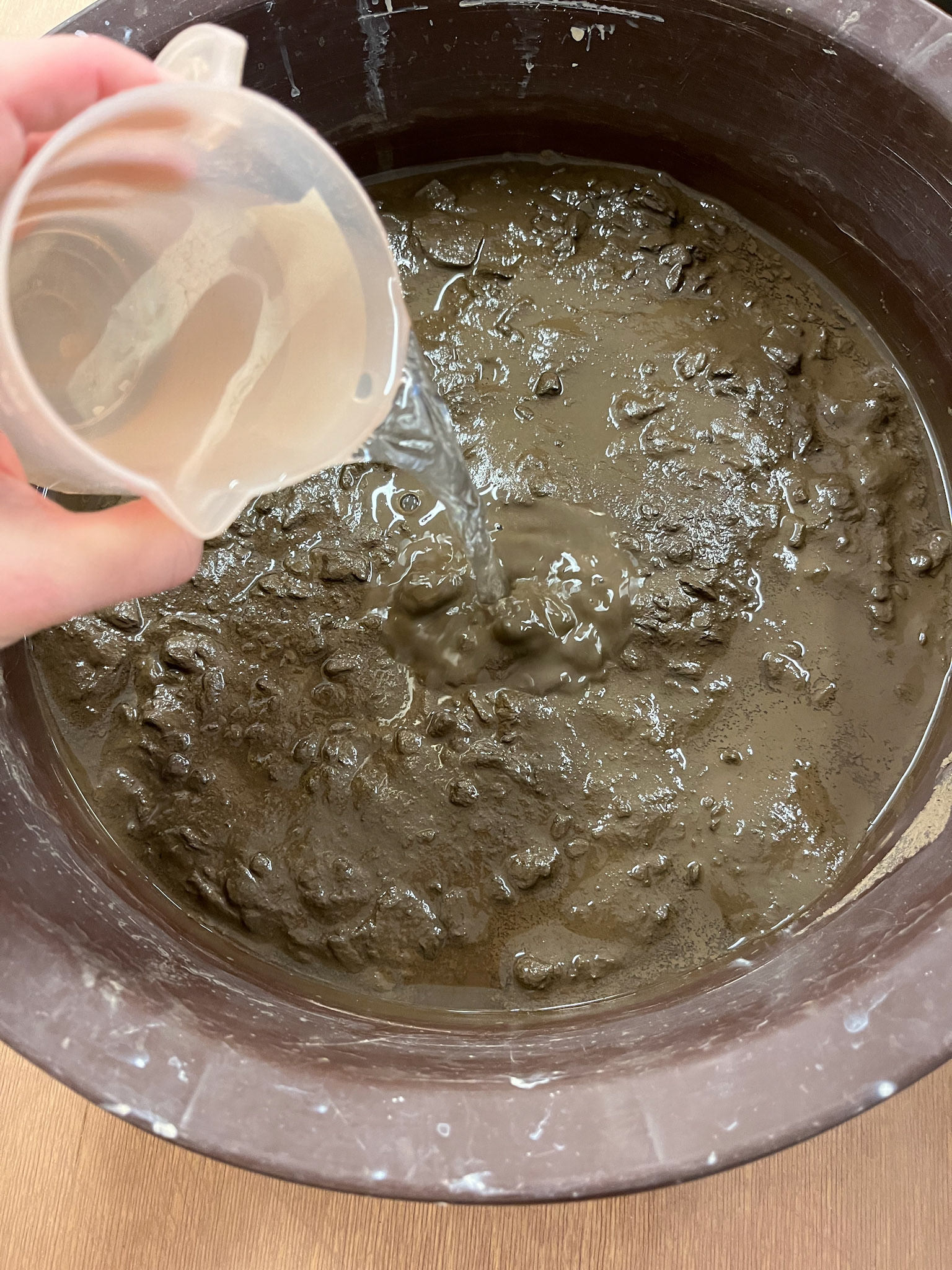
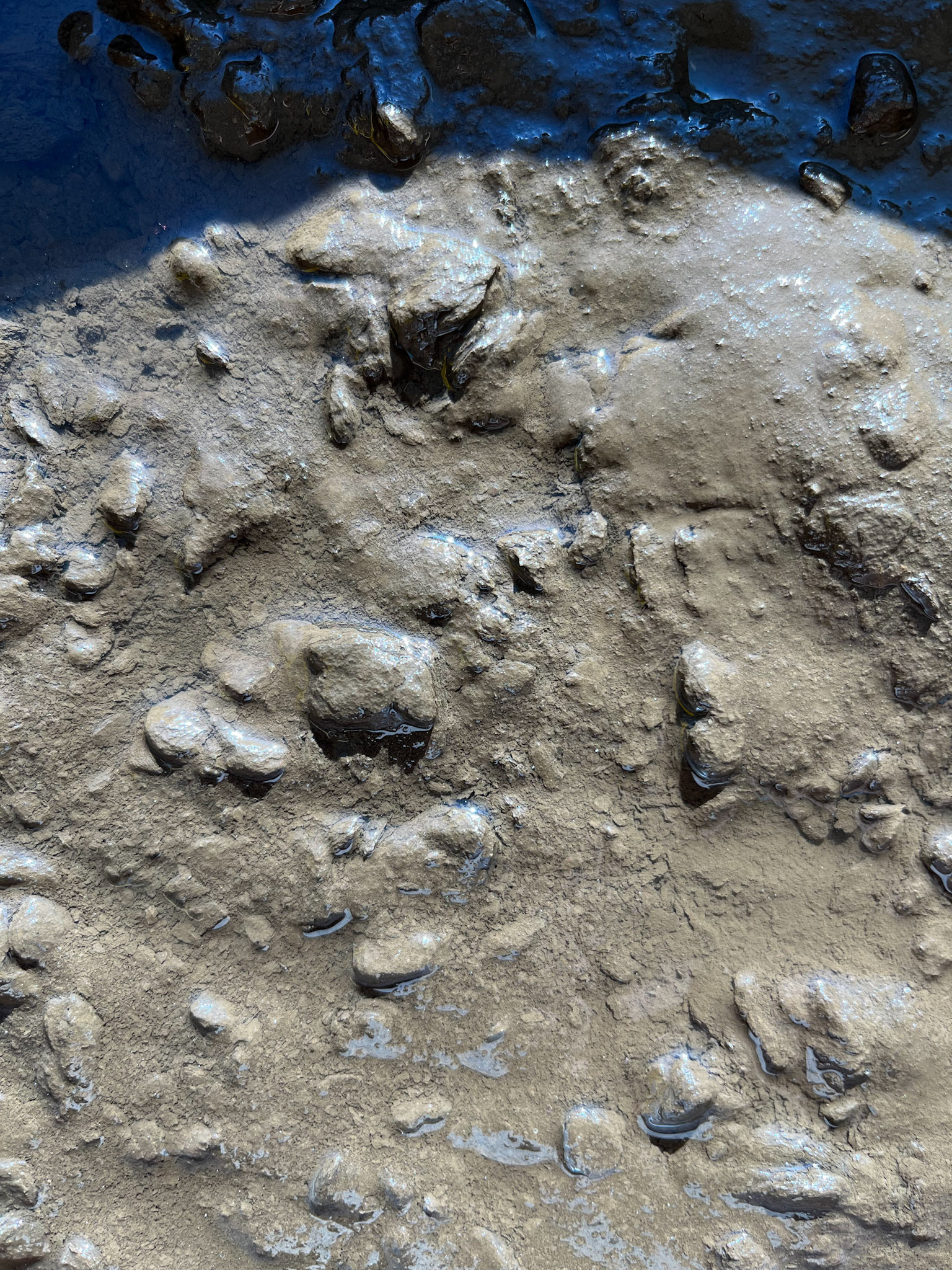
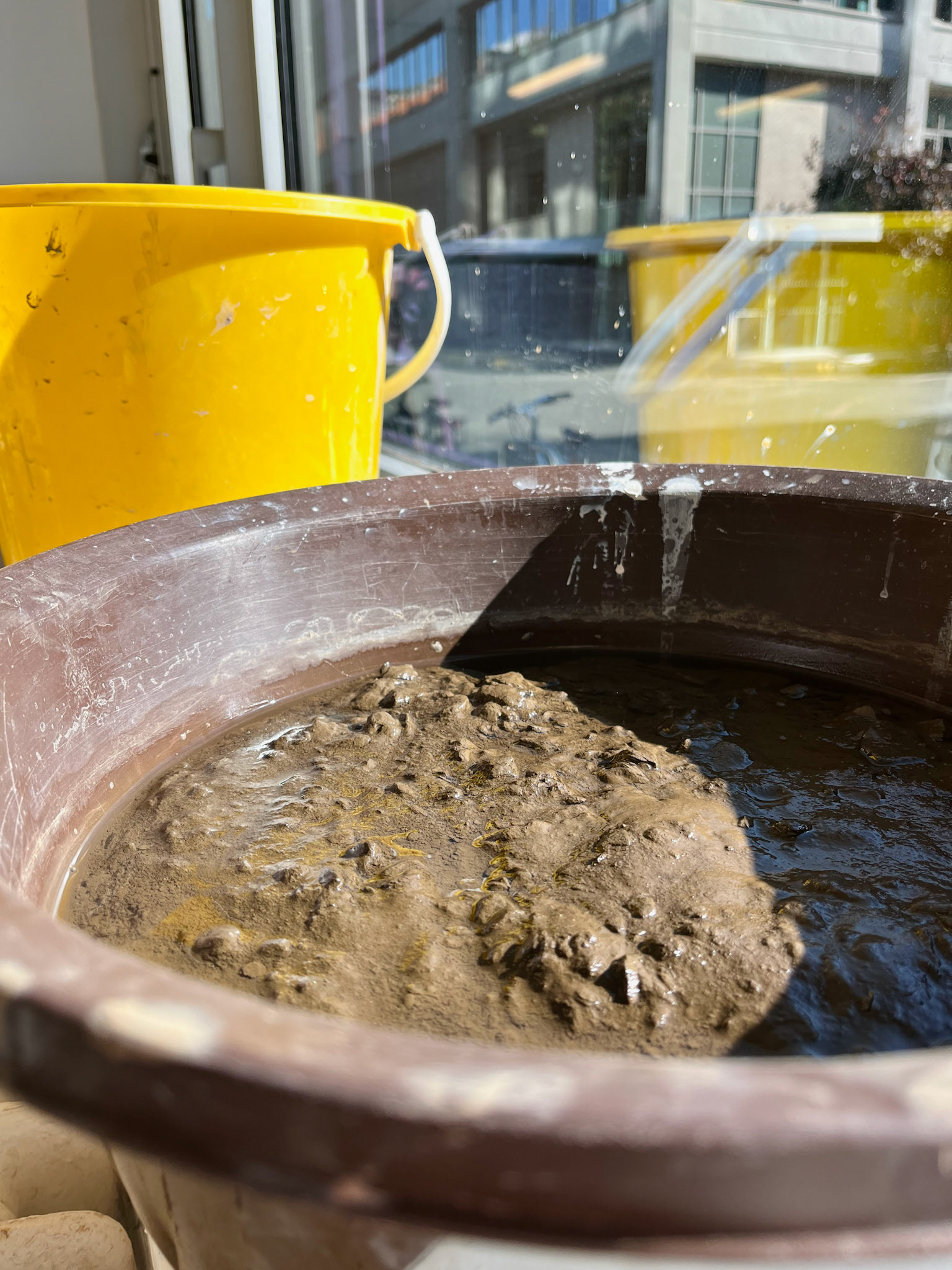

I then sieve the clay slip to get rid of all the debris that is in the material.
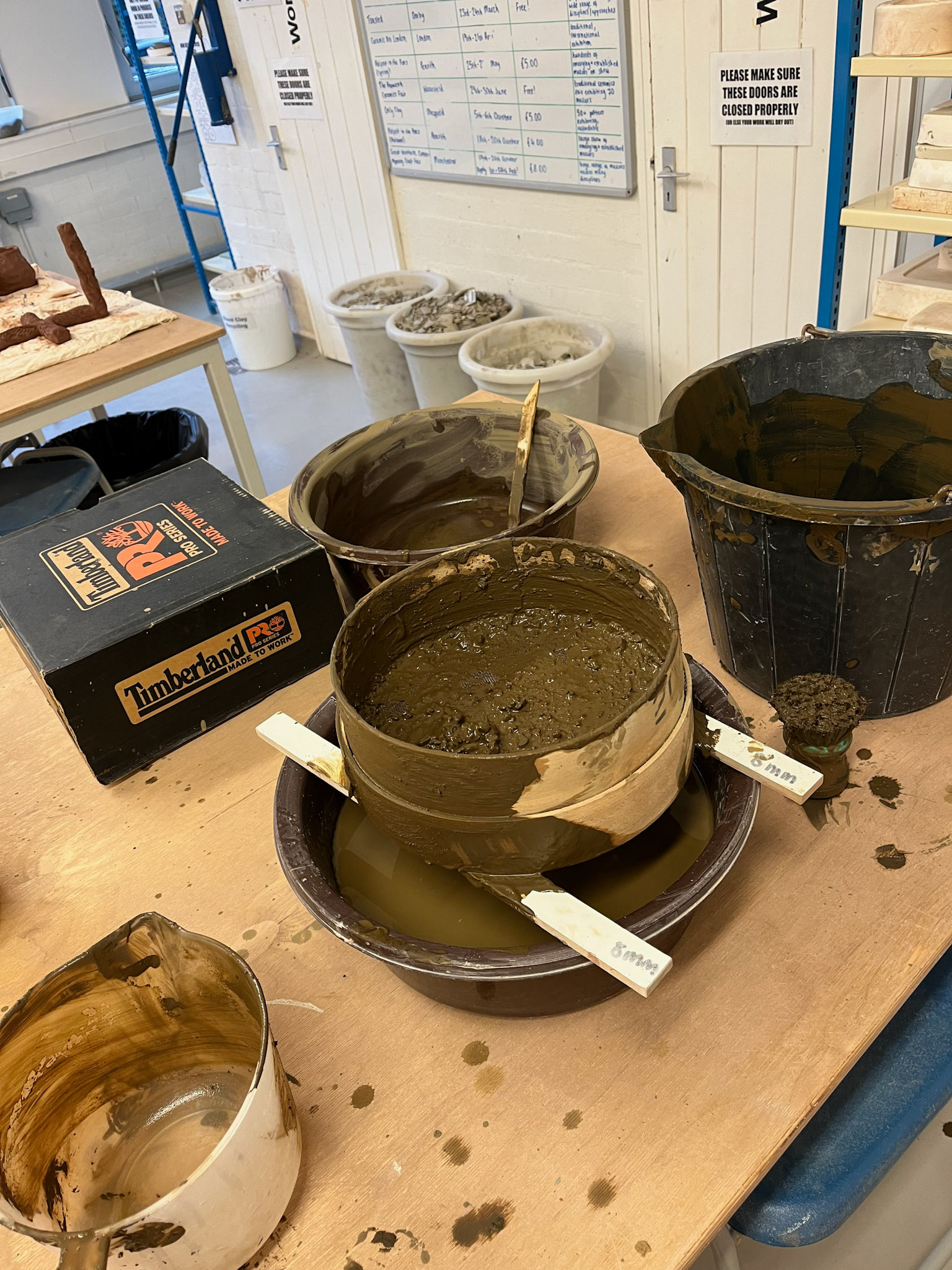
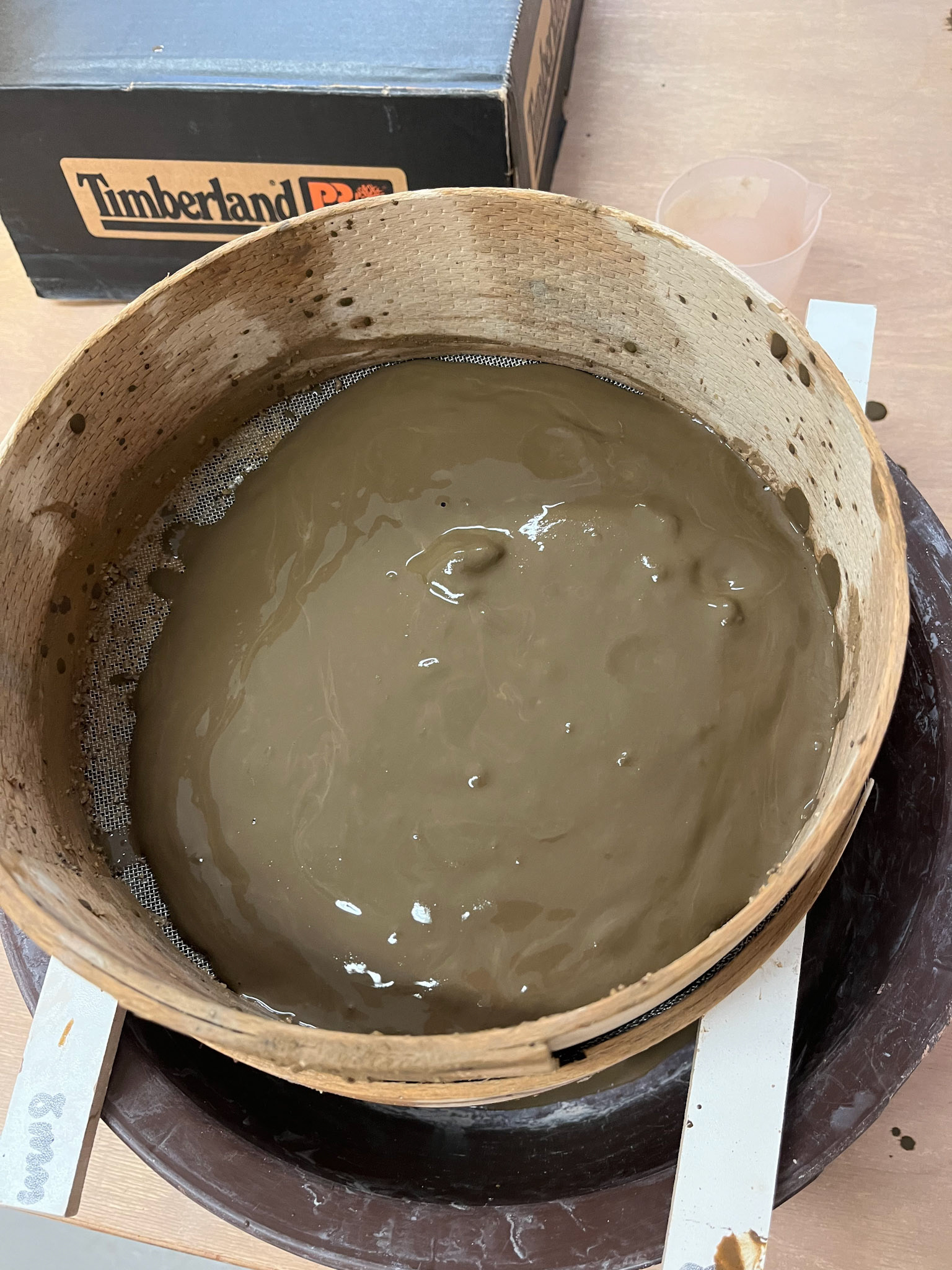


The clay is now at a point where it can be worked with. I lay it out on a plaster bat to extract unwanted moisture, and then gather it into a ball and bag it up, ready for me to start making with it!
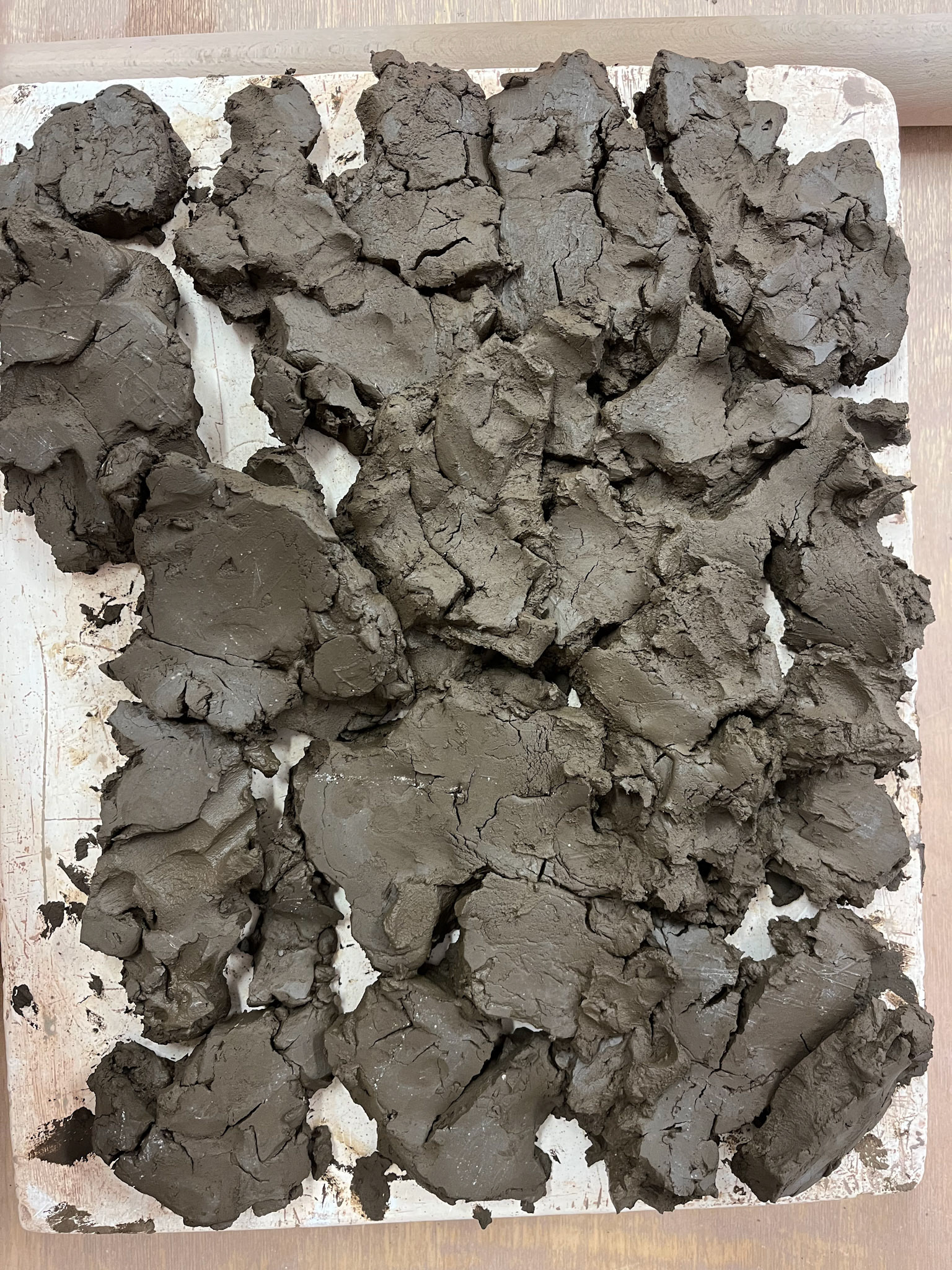

Clay samples
These photos are a mix of clay from the first cave batch, which was gathered over the summer, and the batch which had been gathered from the second cave. The bits of "rubble" in the glass jars are the remains of the clay from the first batch. The textured, unfired pieces are extracts from when I was in the processing stage of the second batch of clay. I wanted to keep these how they are as I really like the way you can see the marks of working with the clay, and the way my actions win the clay create textures.
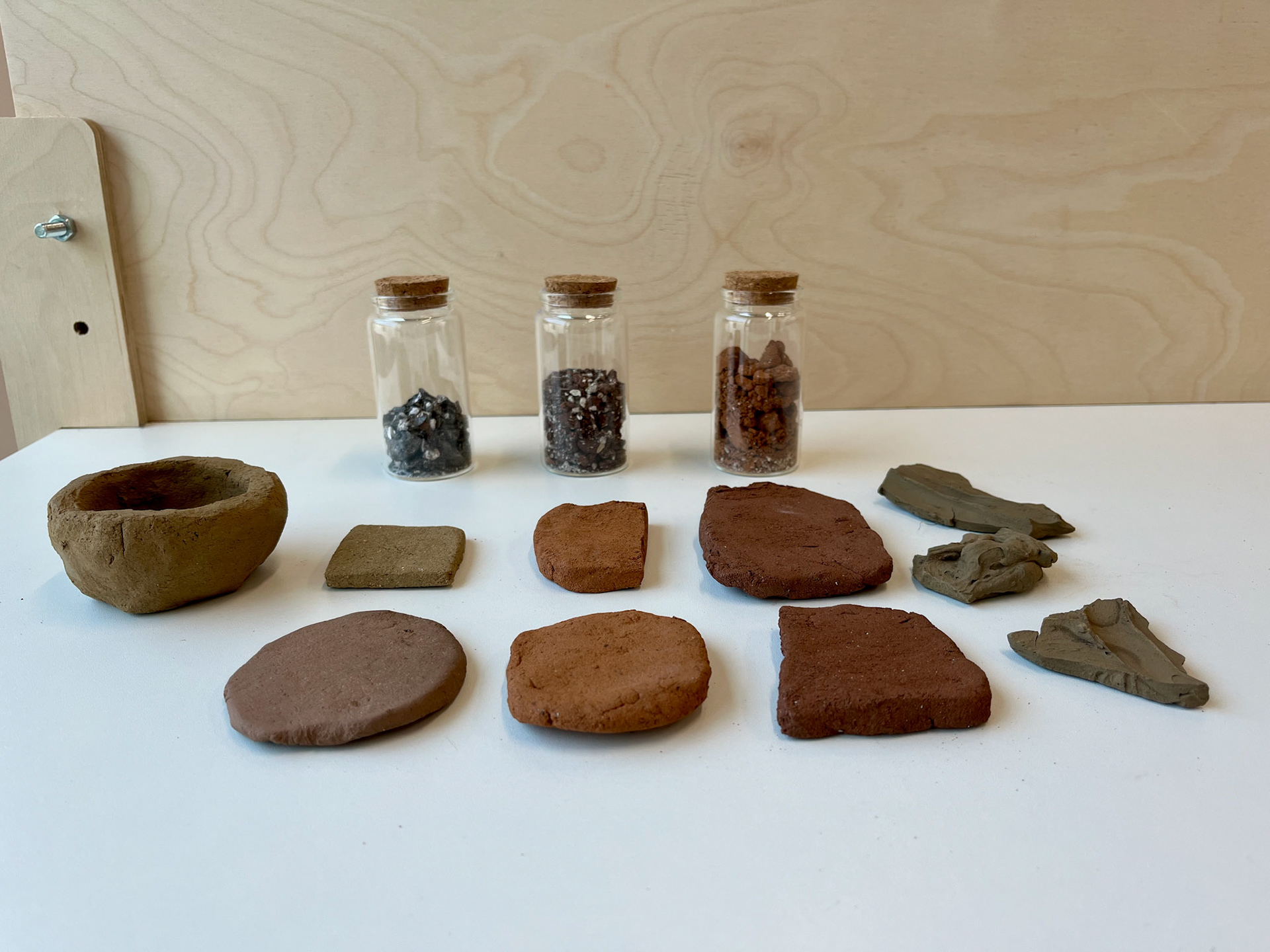
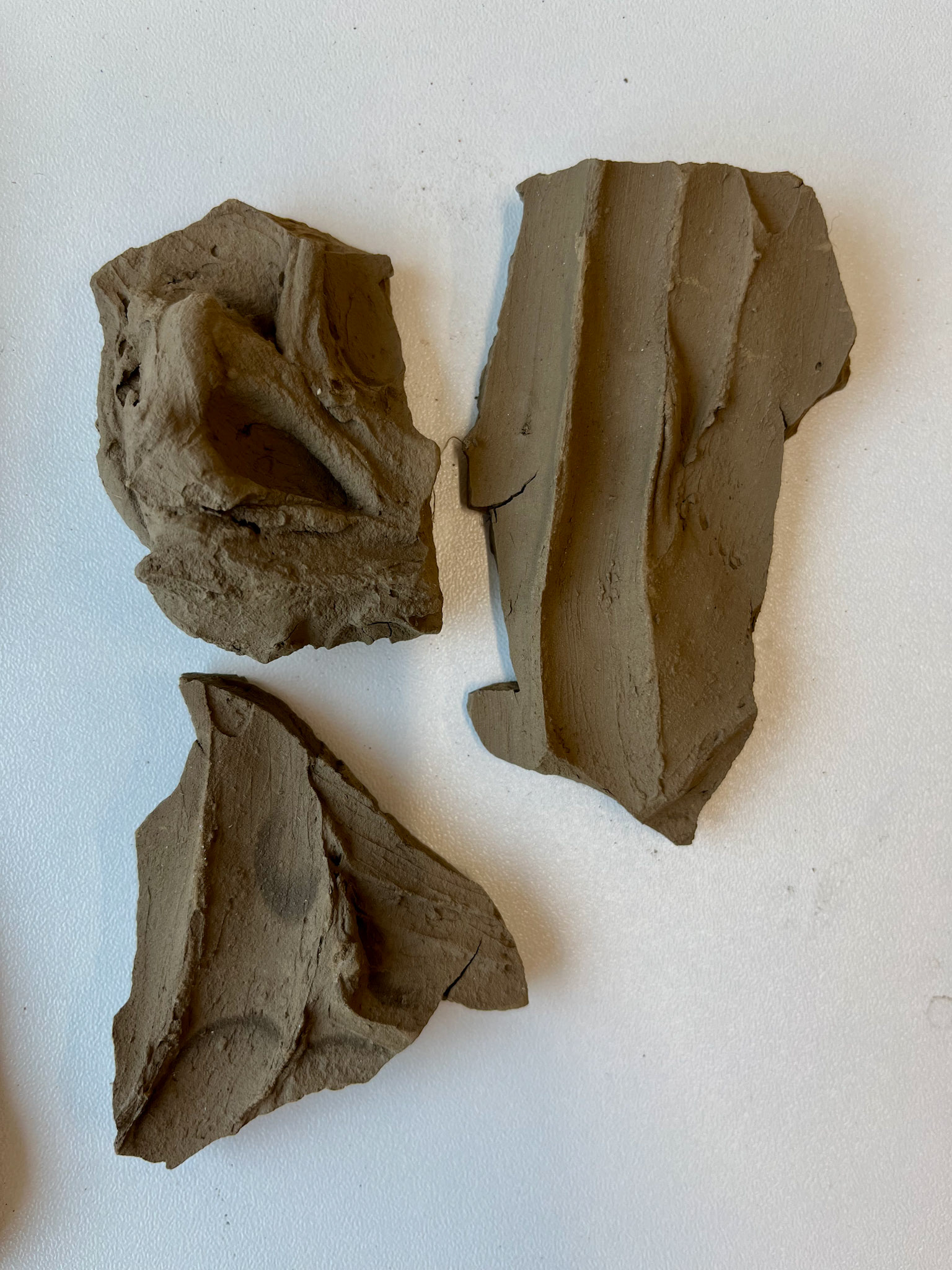
Unfired, textured pieces
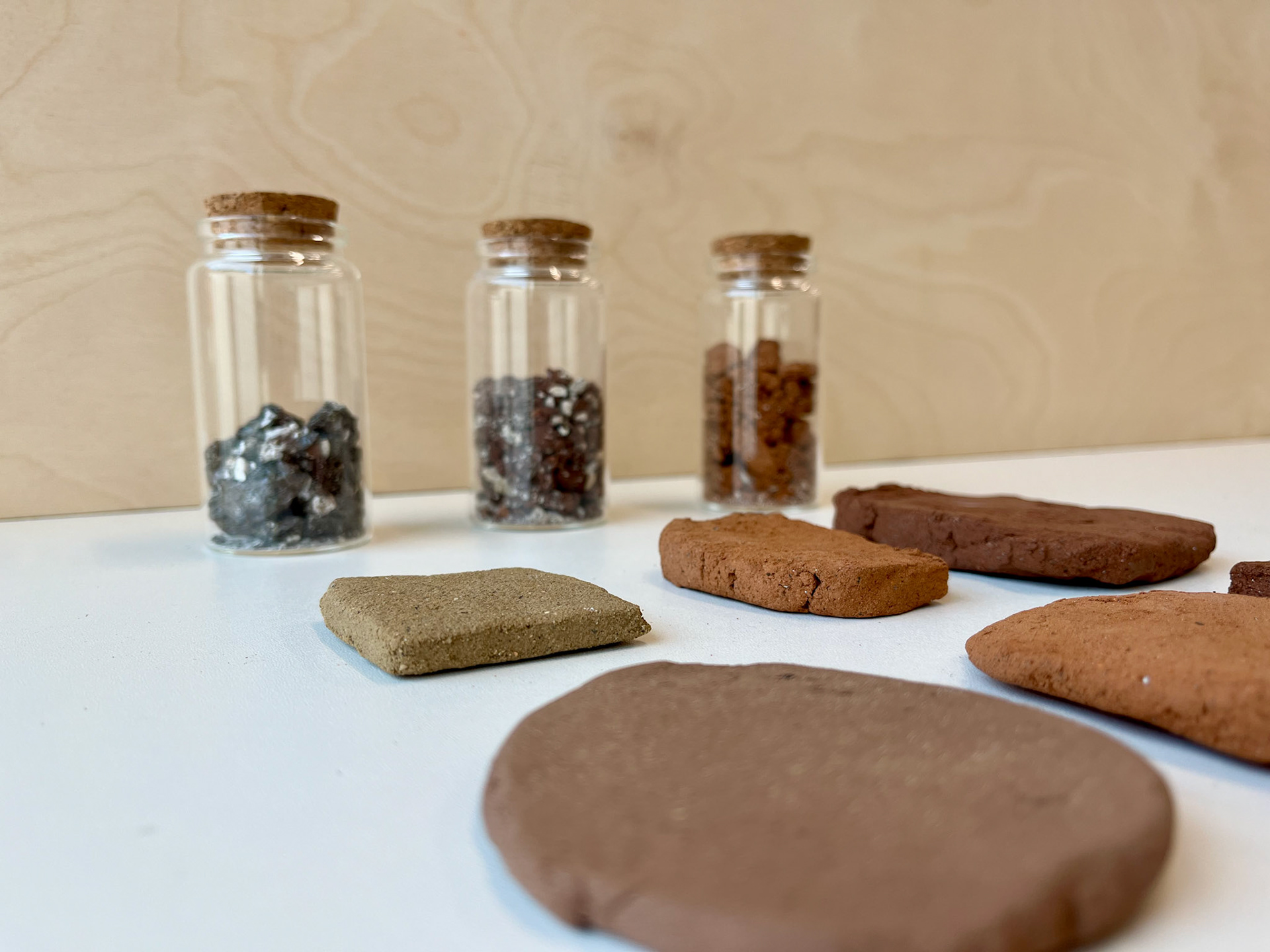
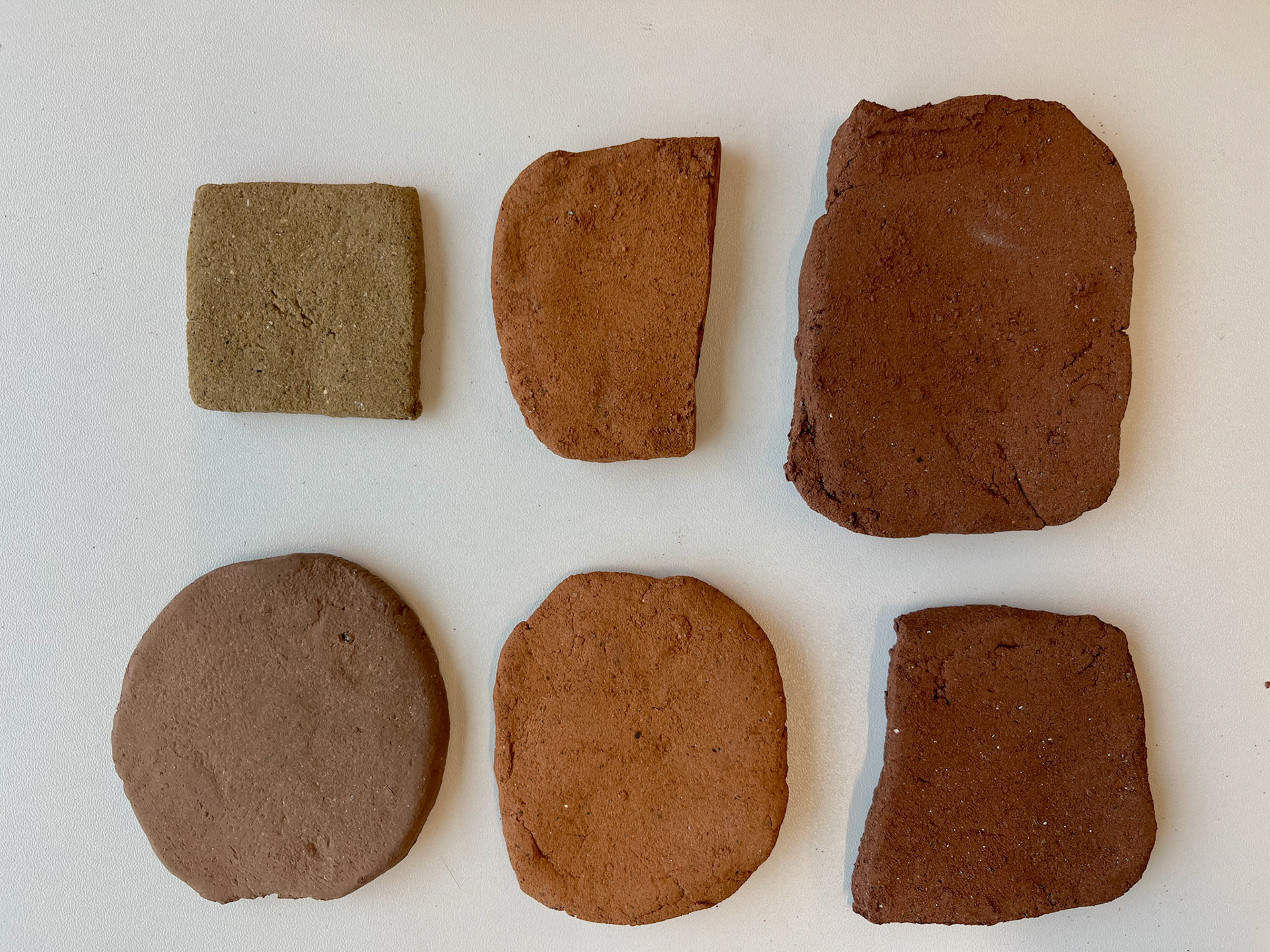
Ceramic tiles fired at different temperatures, creating different colours

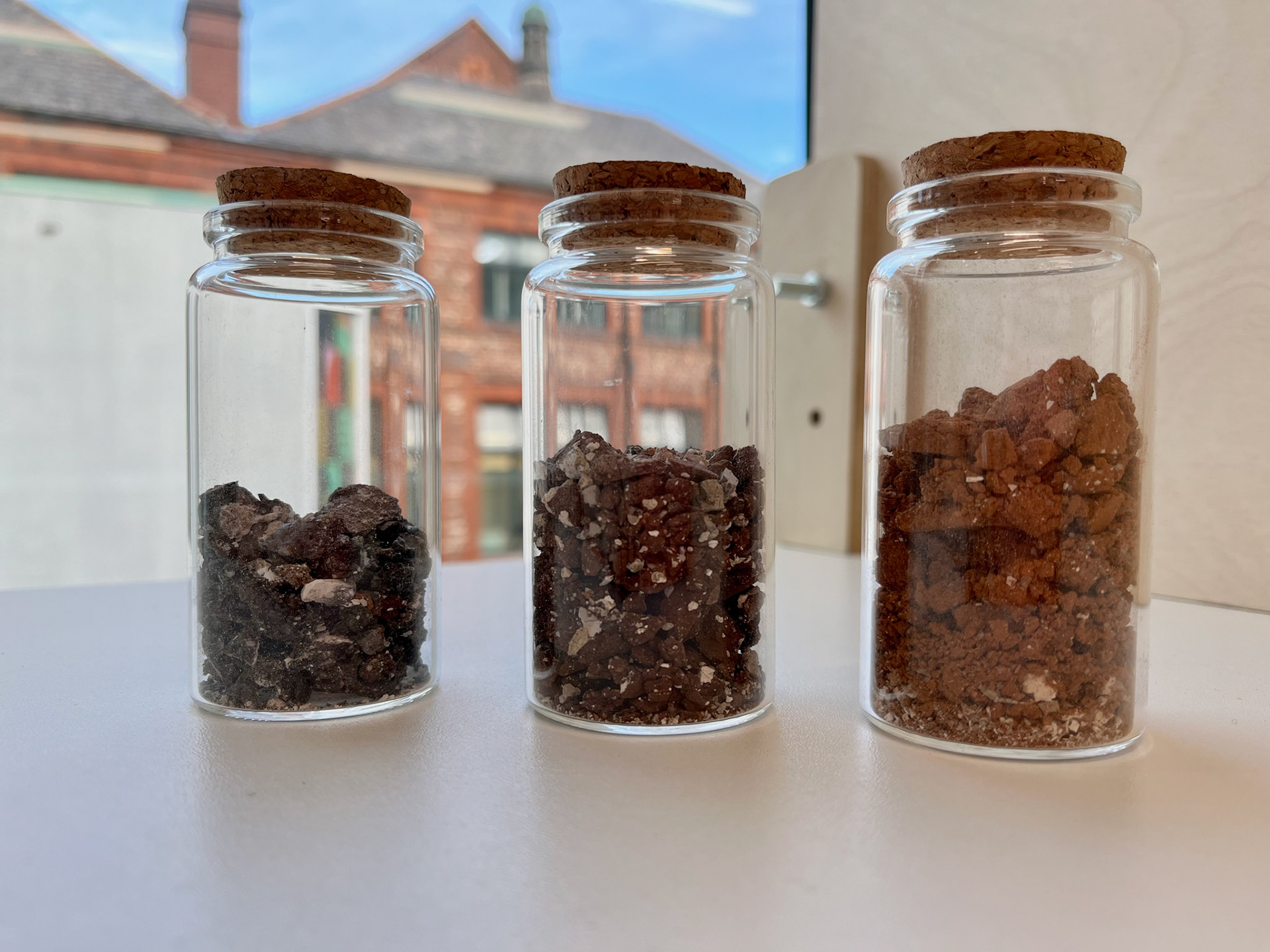
"Rubble" from first batch of clay
Test Tiles
I have been experimenting with lots of different test tiles with each of my batches of clay. I have lots of different bags of clay, from either different caves, or processed or raw. I have labelled all these types of clay and key coded them so I can keep track of them all.
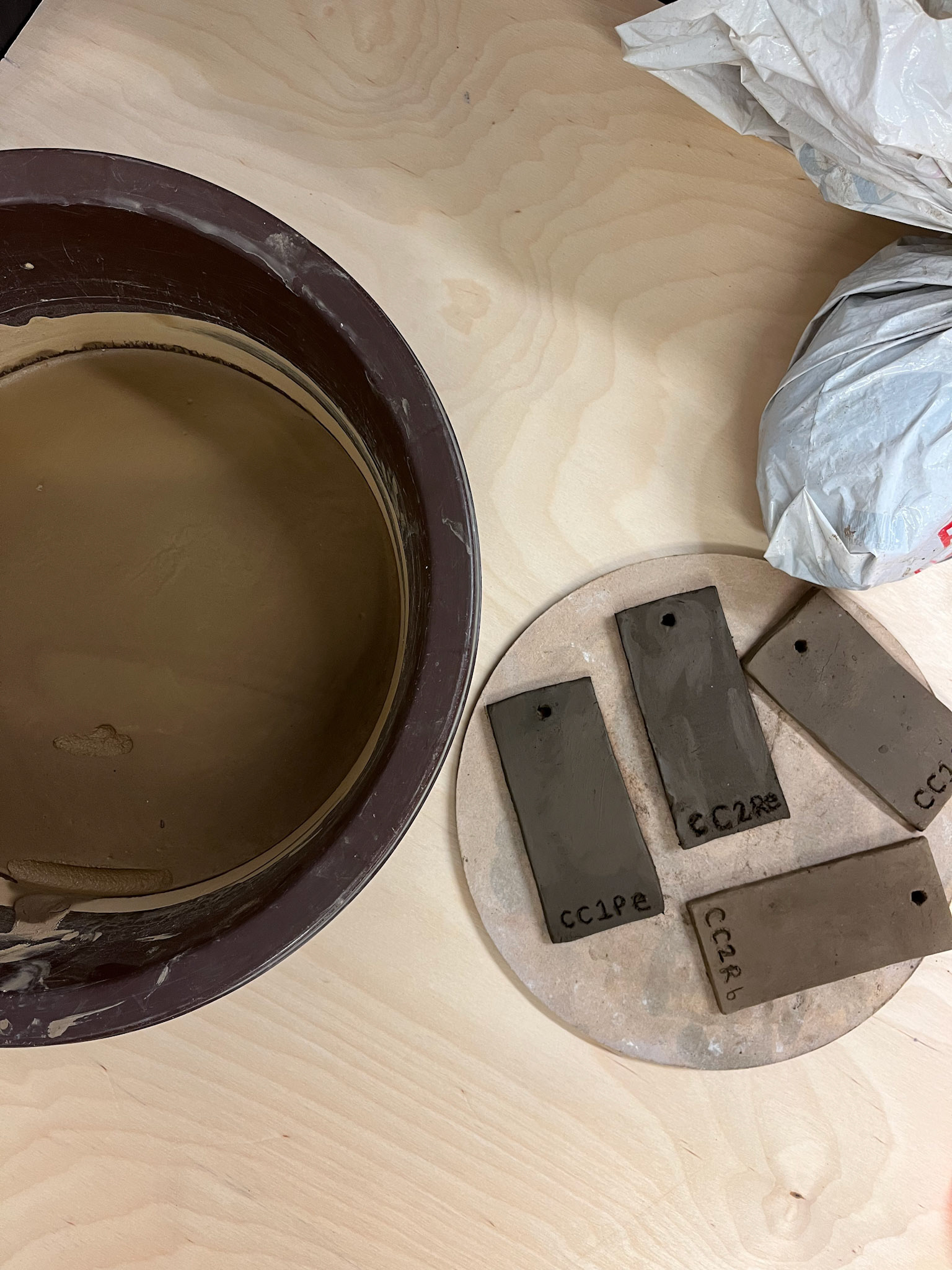
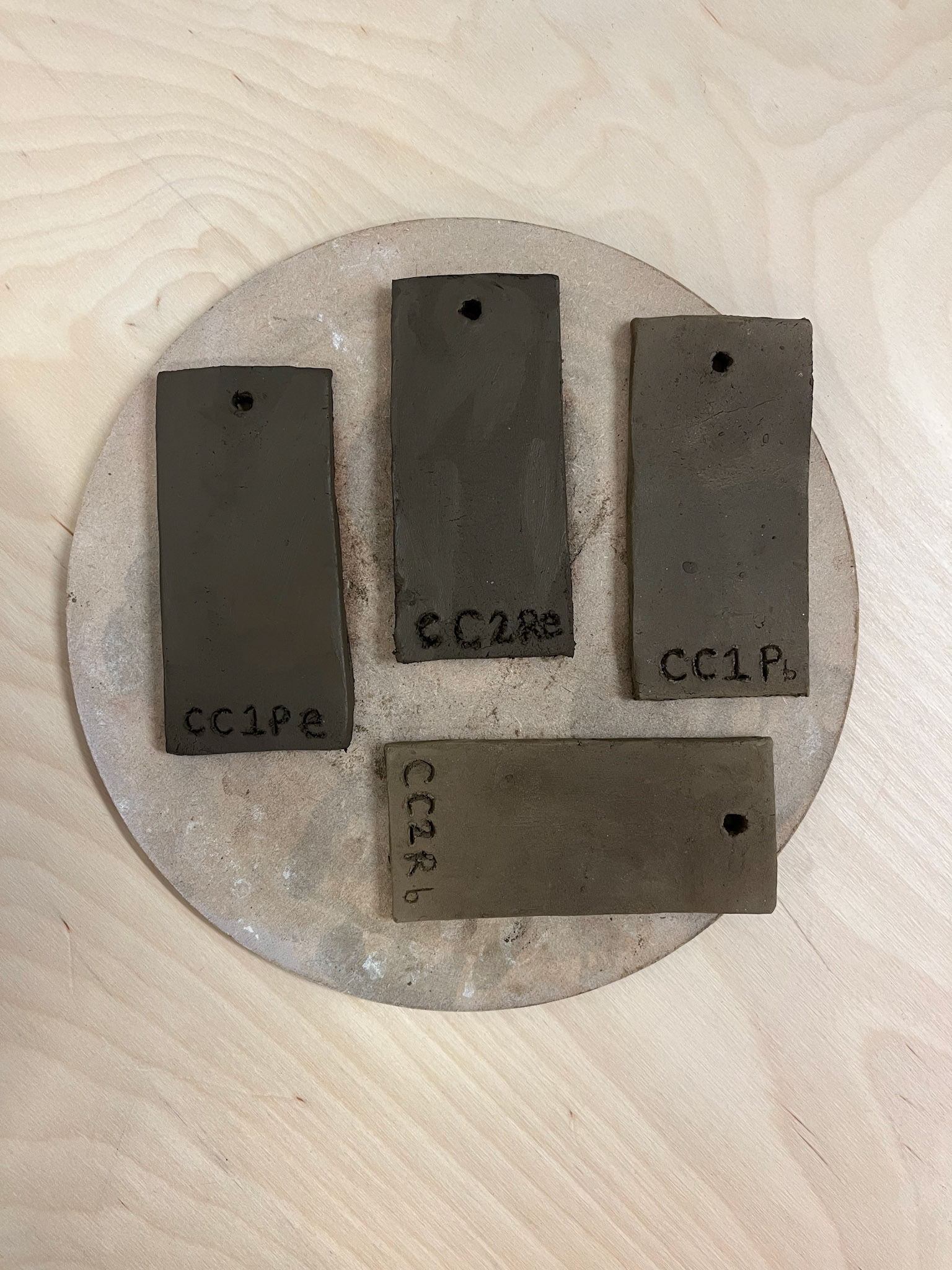
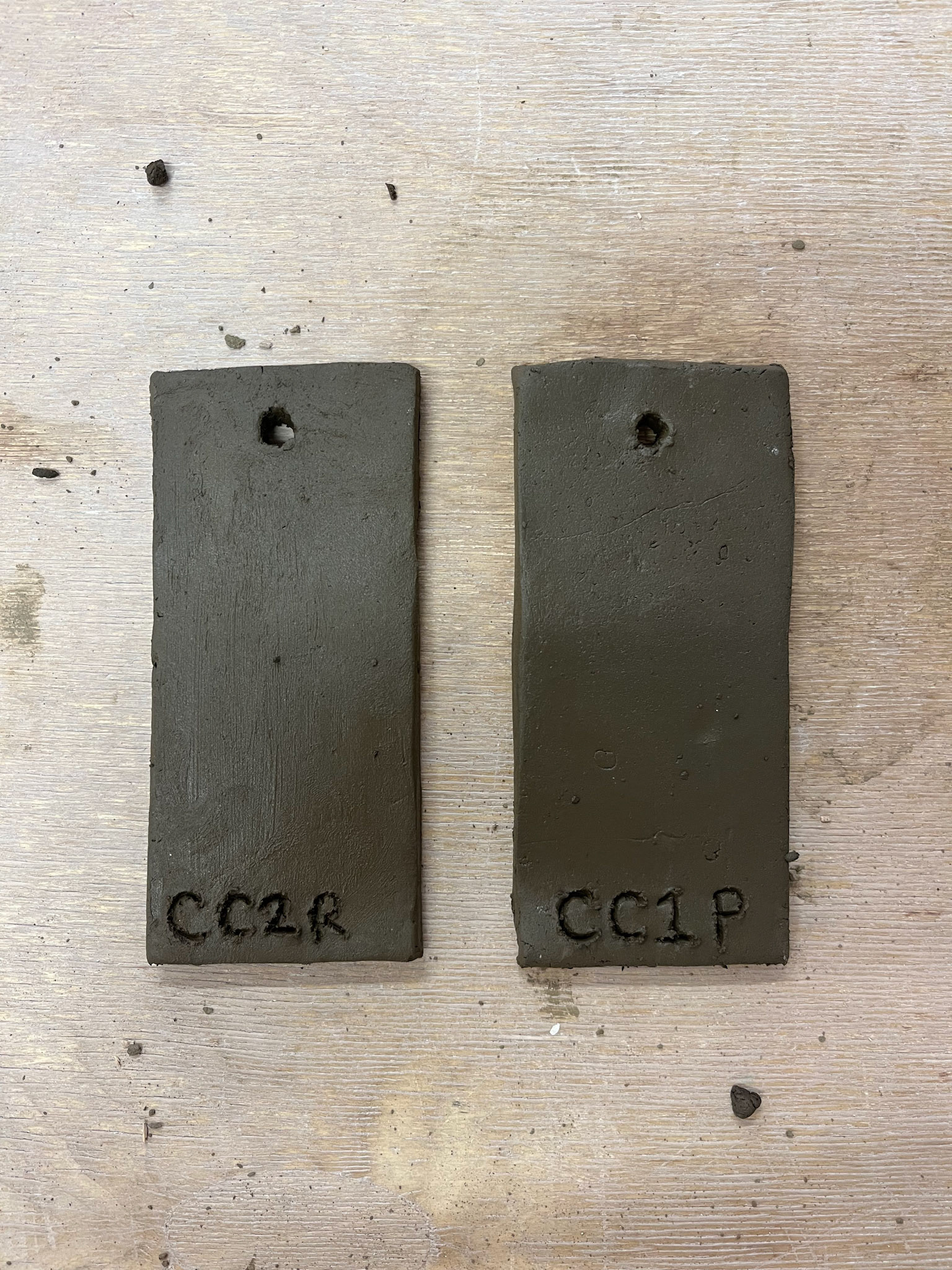


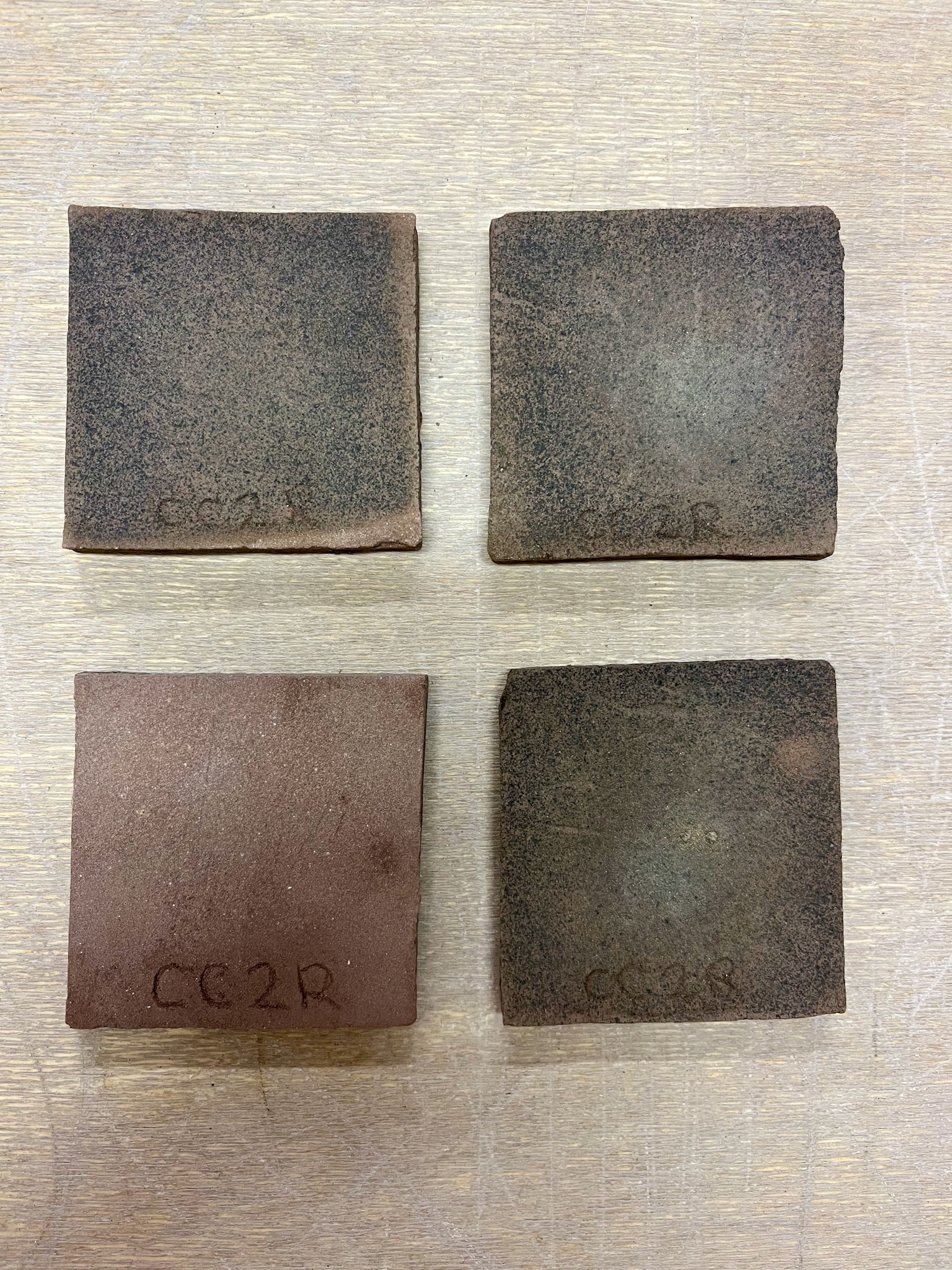
Test Tiles unprocessed
I also made some test tiles of the clay that I got straight from the cave. This clay fires really well, without me having to do anything to it. It is really light and easy to work with, and there is very little to no stones or debris in the clay, meaning I can work with it straight away from digging it.
Chunky pinch pot
I have made this pinch pot using CC1 processed clay. I wanted to get a feel for the clay in my hands, and decided to build a simple pot to examine how the clay holds and its qualities once fired, but also its qualities whilst making with it.

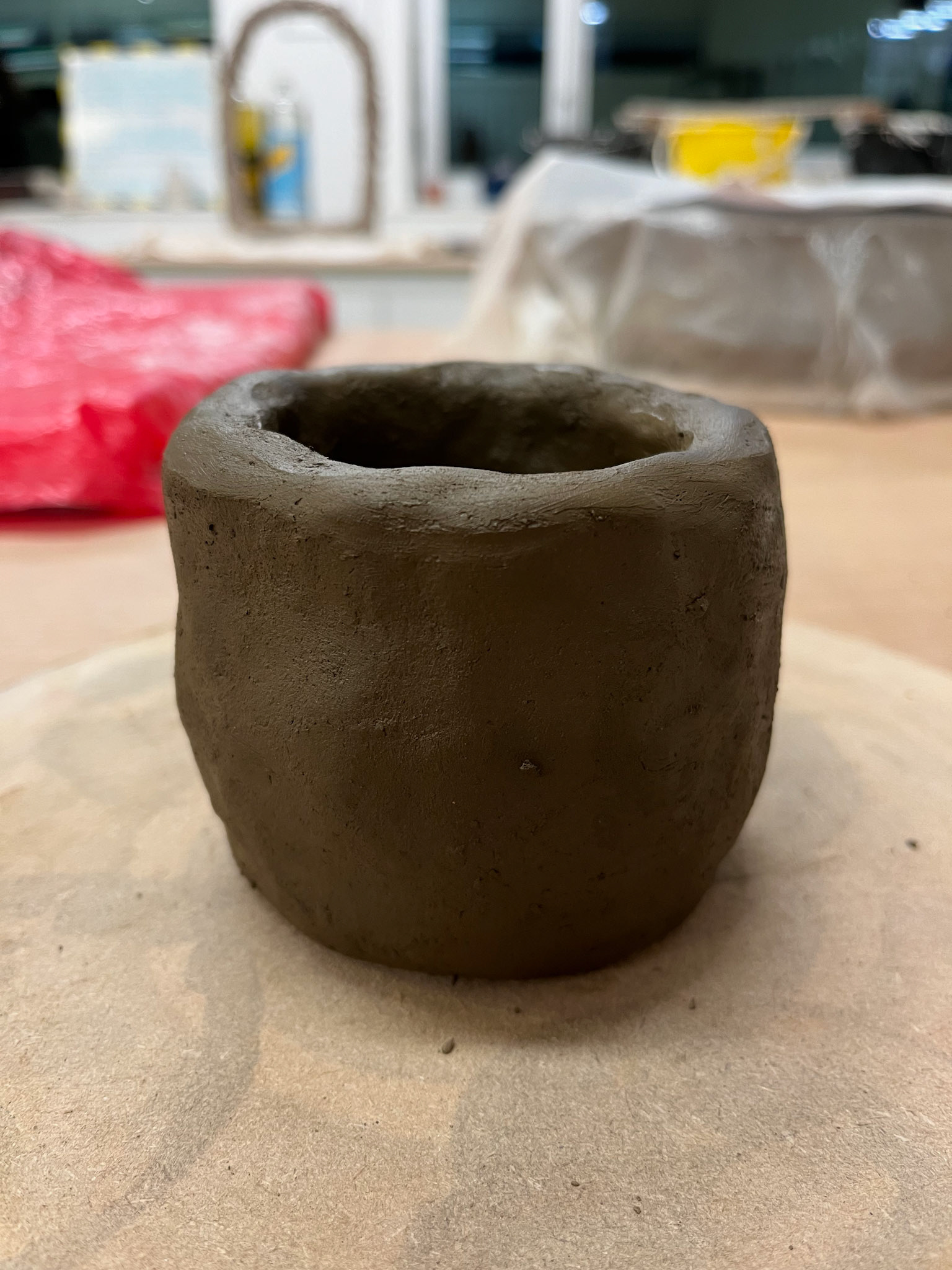

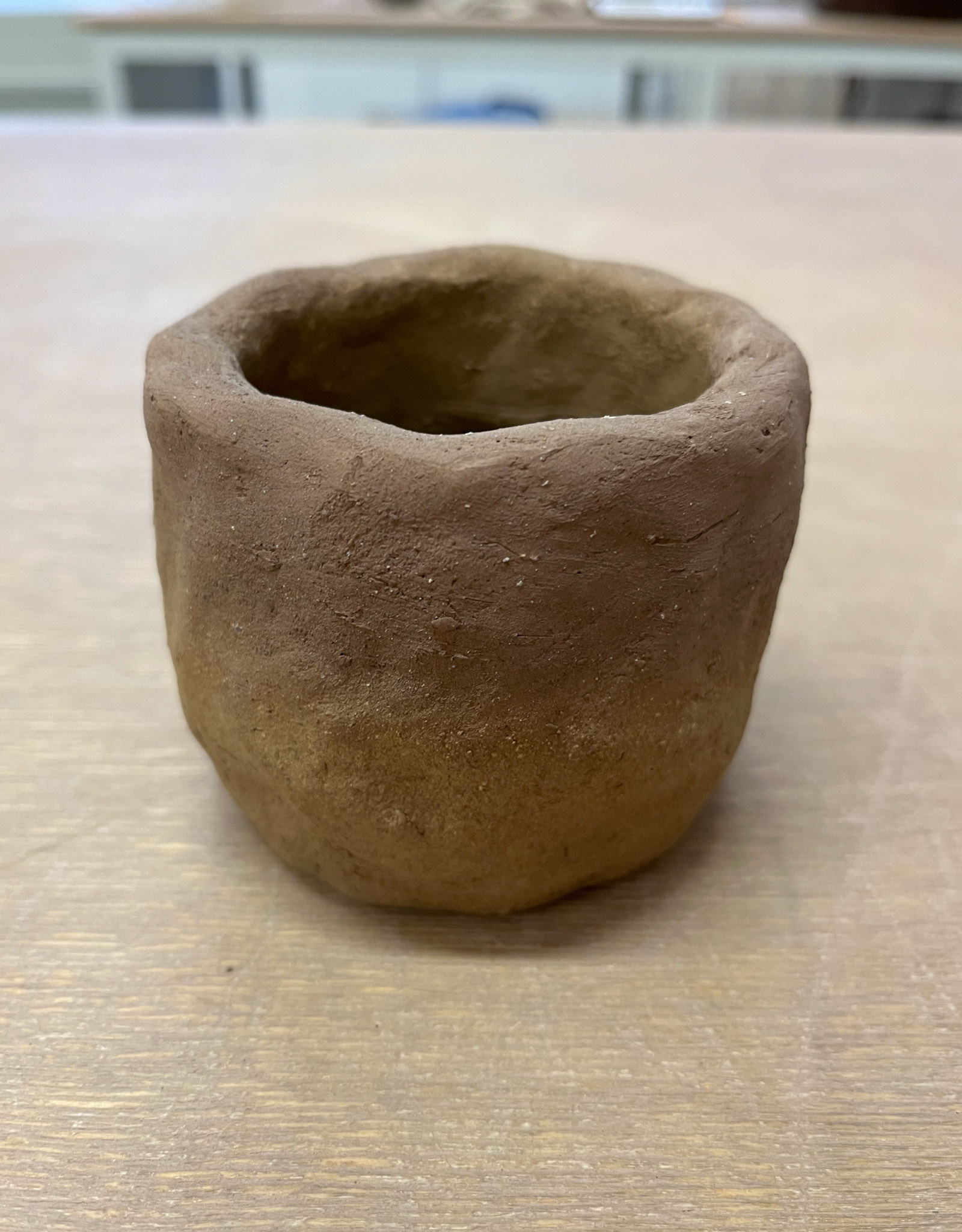
The clay is very smooth and malleable and forms structure well. This is clay which I have processed, so it is similar in quality and texture to commercial clay. However, I have also started working with clay from the same area of the cave which I have not processed, but it seems to be very similar in quality to the processed clay.
GNCCF Exhibition piece
The piece I exhibited at the GNCCF shows the starting point for my project in cave clay.
It displays three different stages of the firing process of the clay that was sourced over the summer BETA project, and demonstrates a work in progress rather than a finished product. Each section is fired at three different temperatures; bisque, earthenware and stoneware. Bisque being the lightest and stoneware the darkest. These went into the kiln being test tiles, however due to their vast quantities of stone and debris, they deteriorated even at bisque stage. However, I do not mind this at this stage, as due to this being the first batch of cave clay I have been experimenting with, I didn't have any expectations of what would happen with it.
As such, it was a bold decision to exhibit as we are not used to seeing ceramics in such a raw, undeveloped state but it was a decision which generated much public curiosity and questioning.

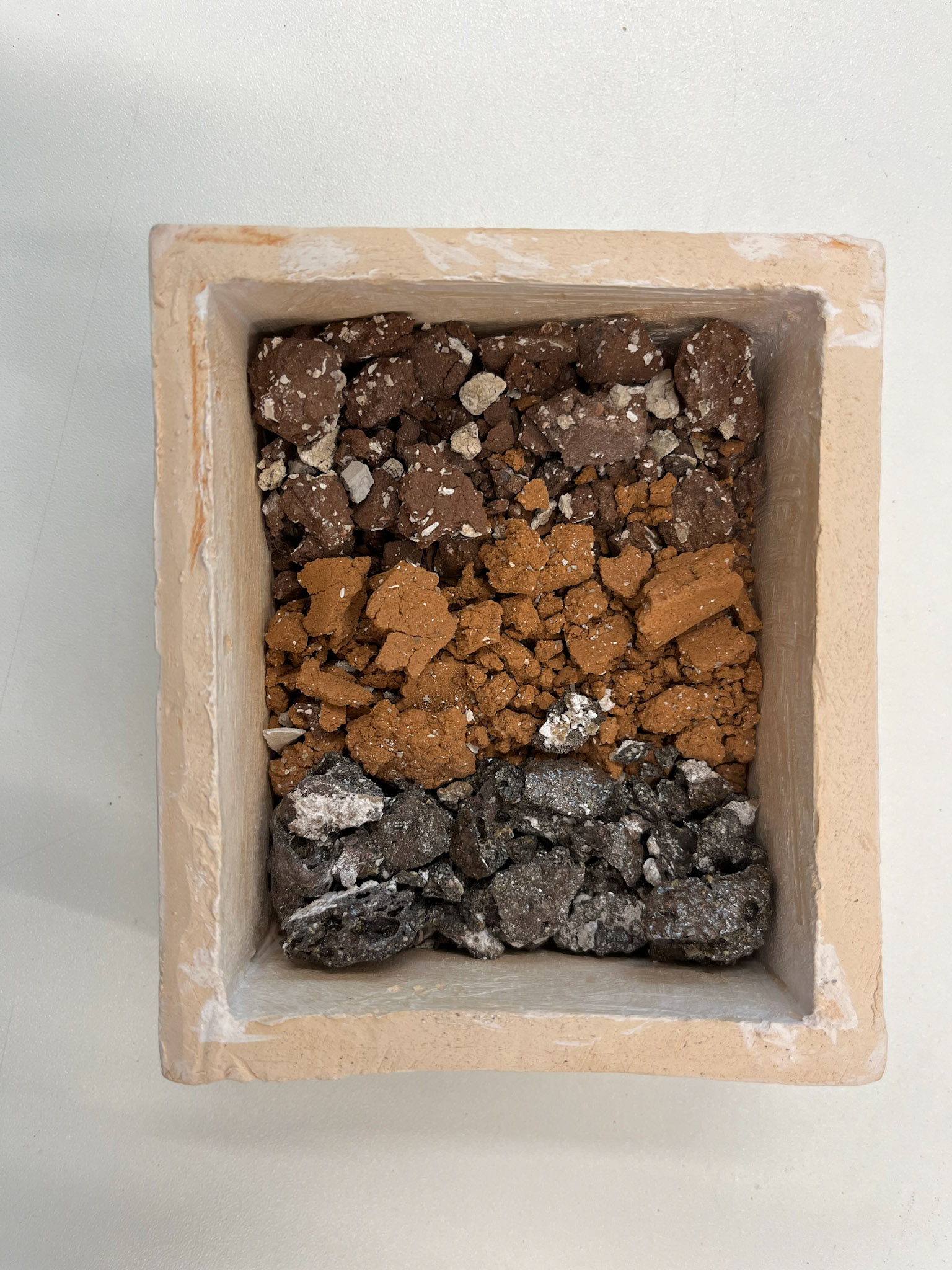
Trip down cave 06/11/24
Stony Middleton, The Peak District
My second trip underground began with an abseil down into a different entrance to the cave system. This was a more technical trip involving squeezing and crawling through smaller passageways as well as climbing over large boulders.
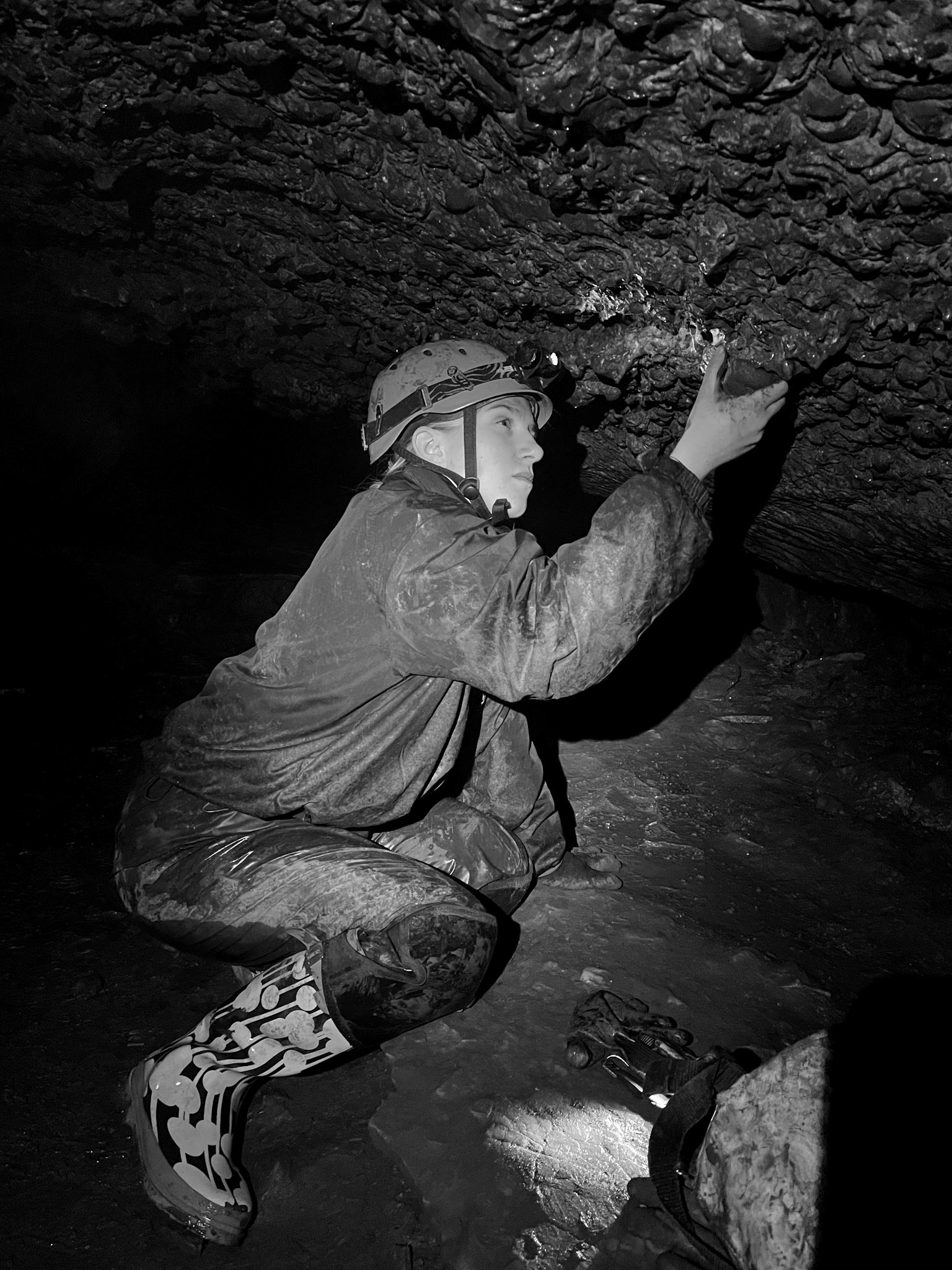
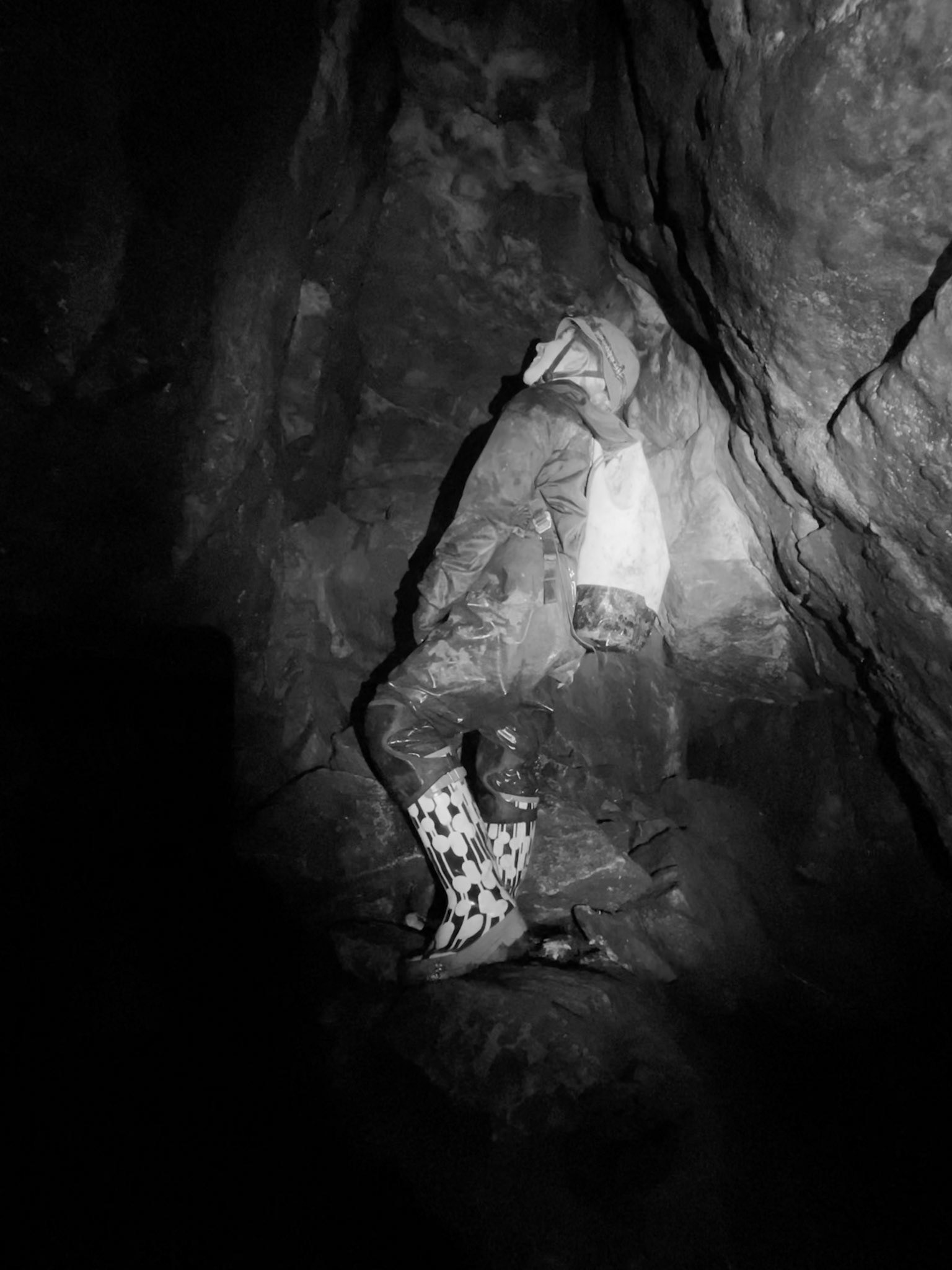
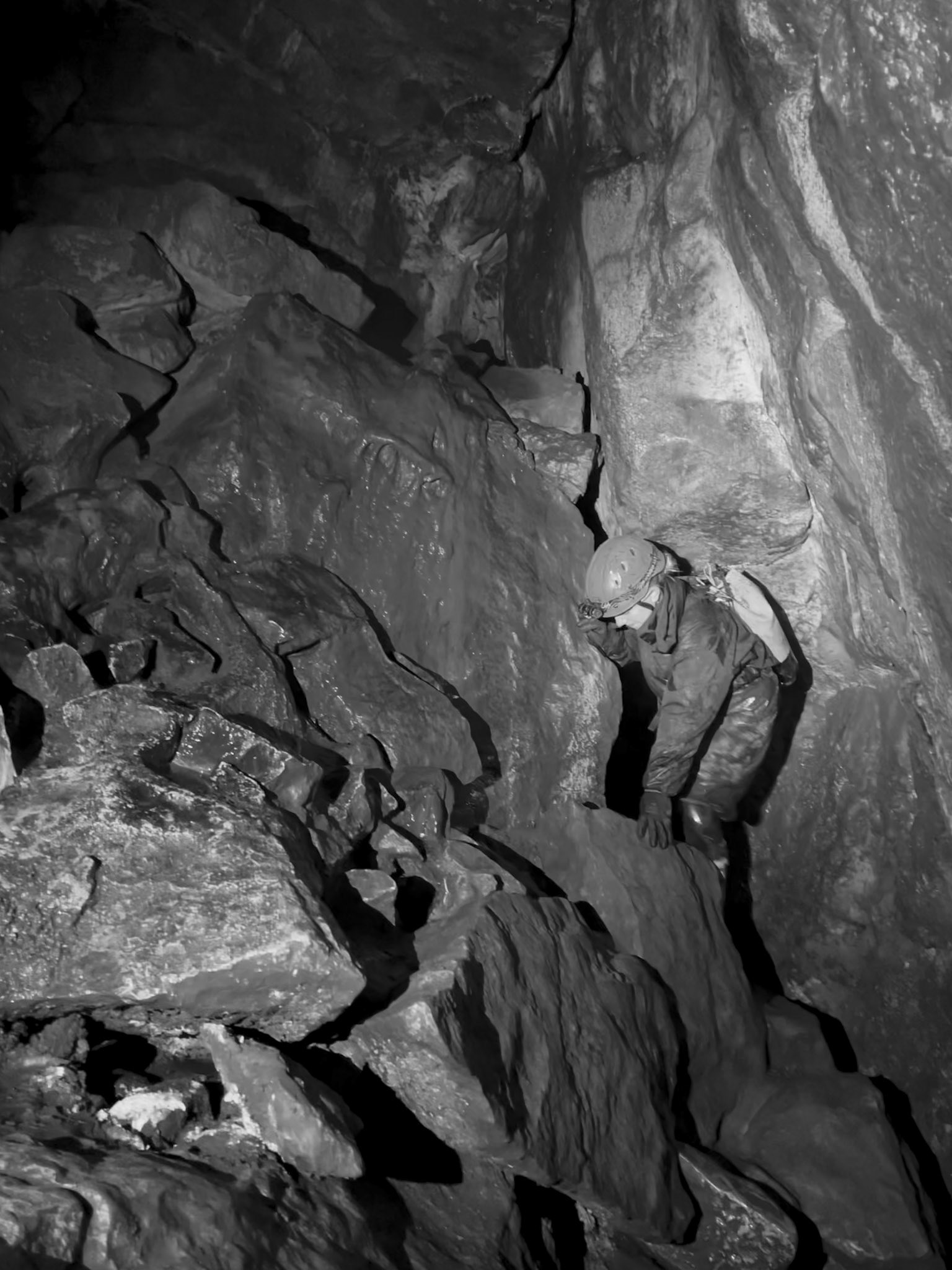
Reel to show the journey down underground to find clay
From abseiling down into the complete darkness to crawling and squeezing between and under rocks, I interact with the mud beneath my feet, digging through the puddles and passageways to find raw clay.
Making underground
I decided to bring my making where it originated- underground. I wanted to highlight the fact that a workshop can be anywhere, and that because my clay is sourced from caves, it is caves which I feel the most comfortable working with my material in.

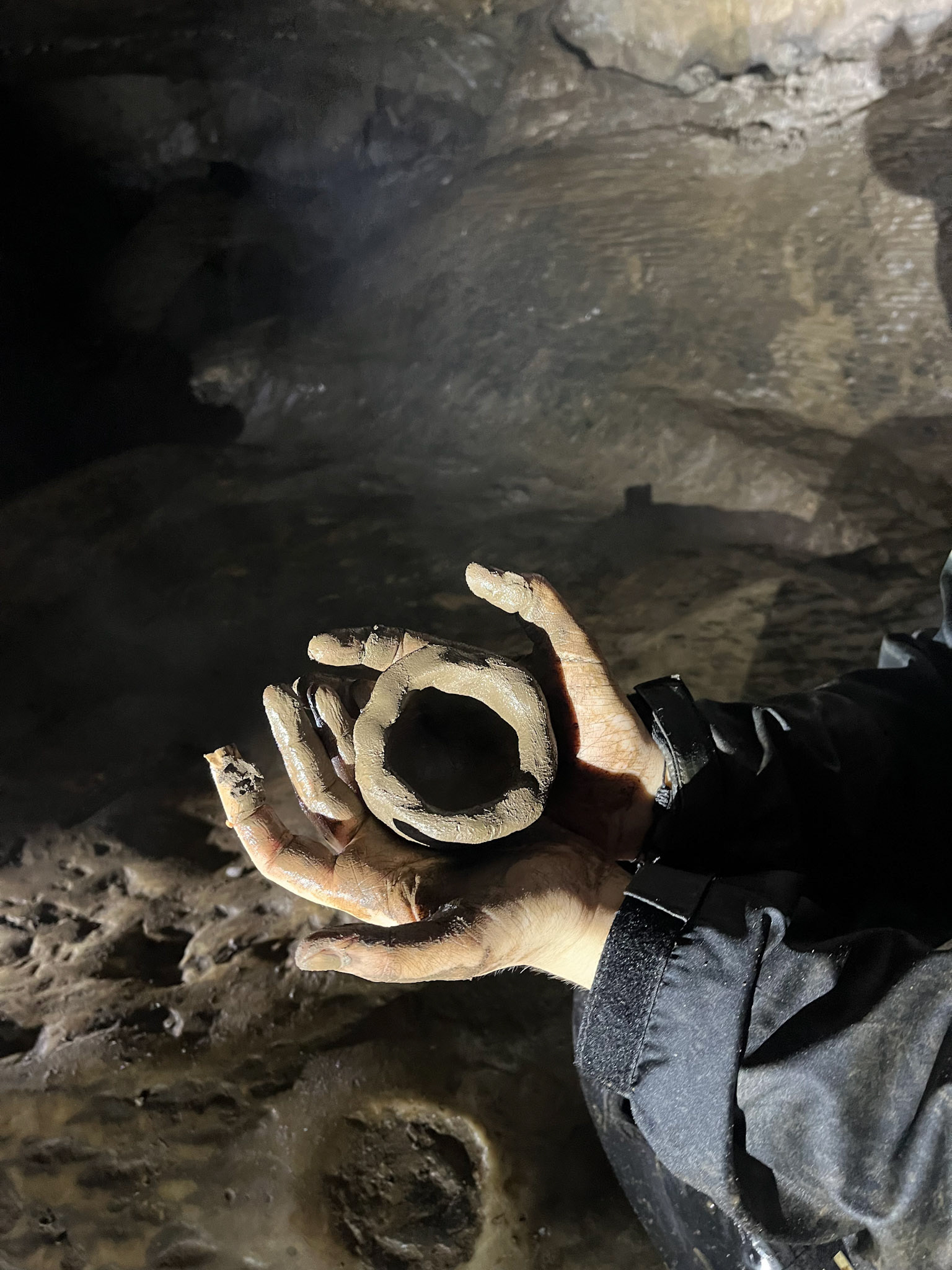
Digging for clay
I used a trowel to get between the rock and dig under the surface layer to find rich clay. Often the clay is tucked behind boulders and in small spaces, so I have to squeeze under rocks and lay flat to dig for the clay. It is hard work but very rewarding.
Making underground reel
I have made a series of different small samples underground. The first two are impressions from the textures of the cave walls and rock. I have also made a small pinch pot to get a better feel of working with the clay underground.
Before firing.
I made impressions of the textures in the cave, and also a pinch pot using the water and surfaces of the cave.

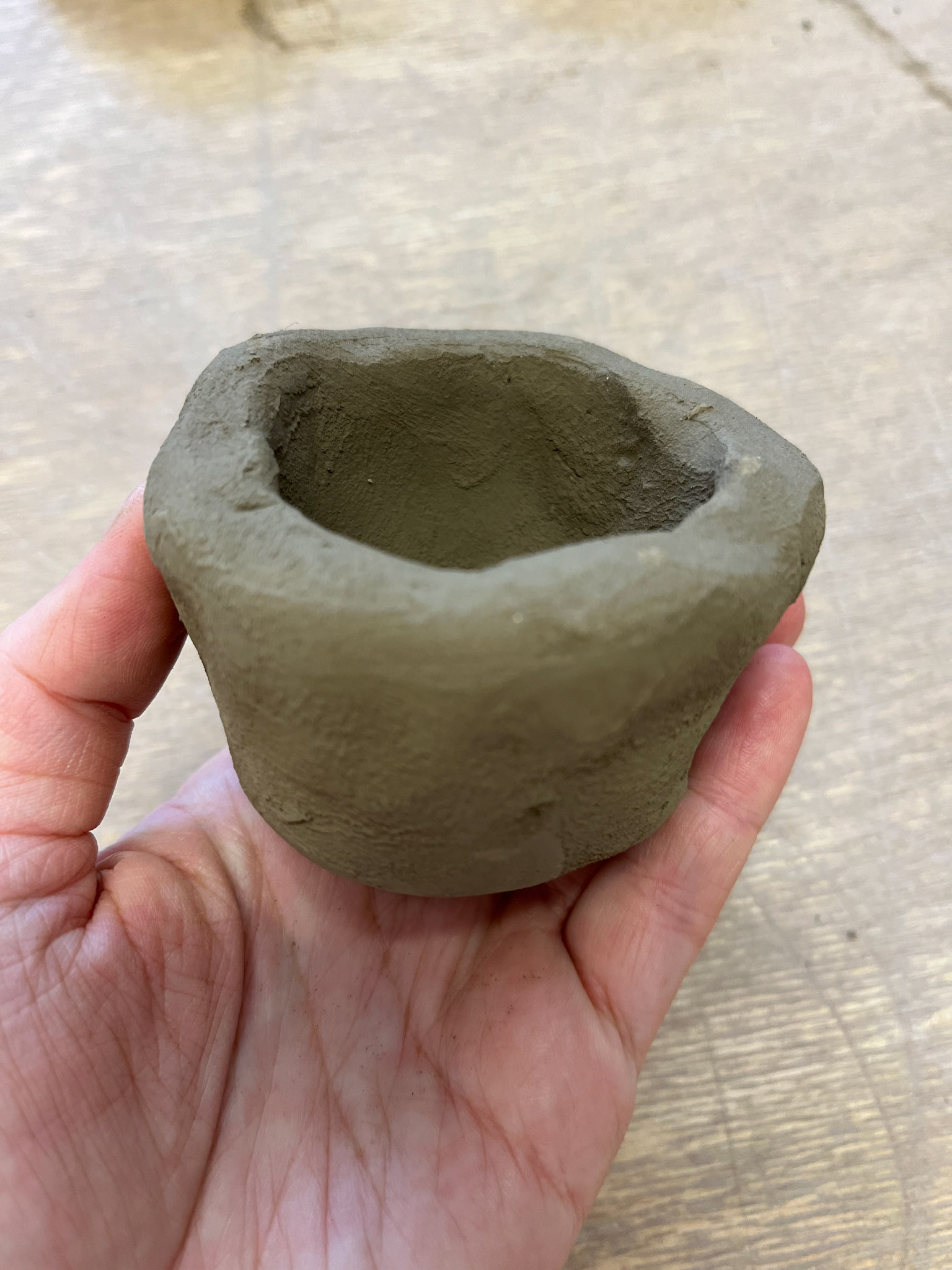
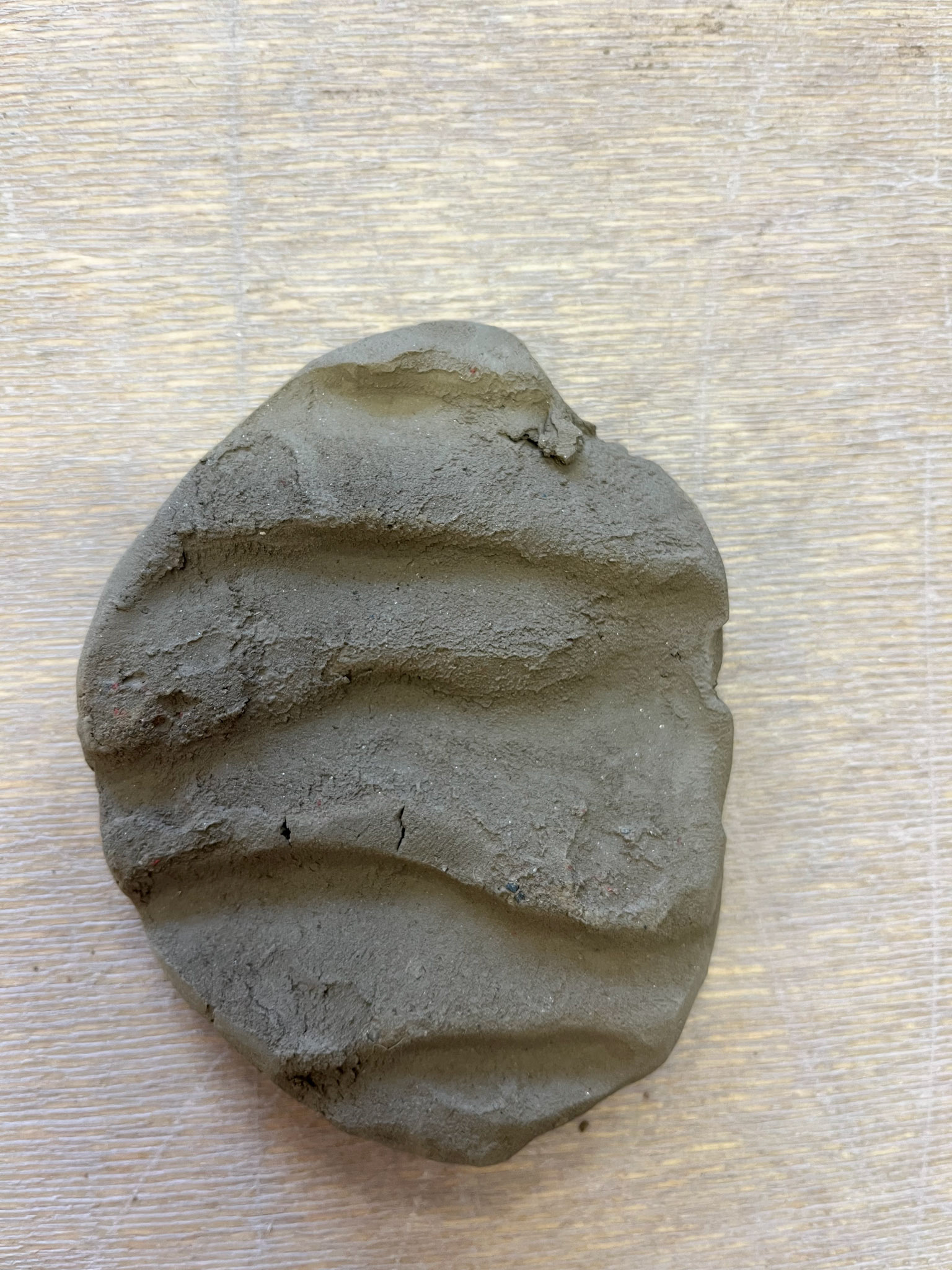

After firing.
These were all fired to Bisque, however, because they were all in the same sagger, stacked on top of each other, it meant that the carbon got trapped in between the layers, so the pieces each came out of the kiln with varying shades.
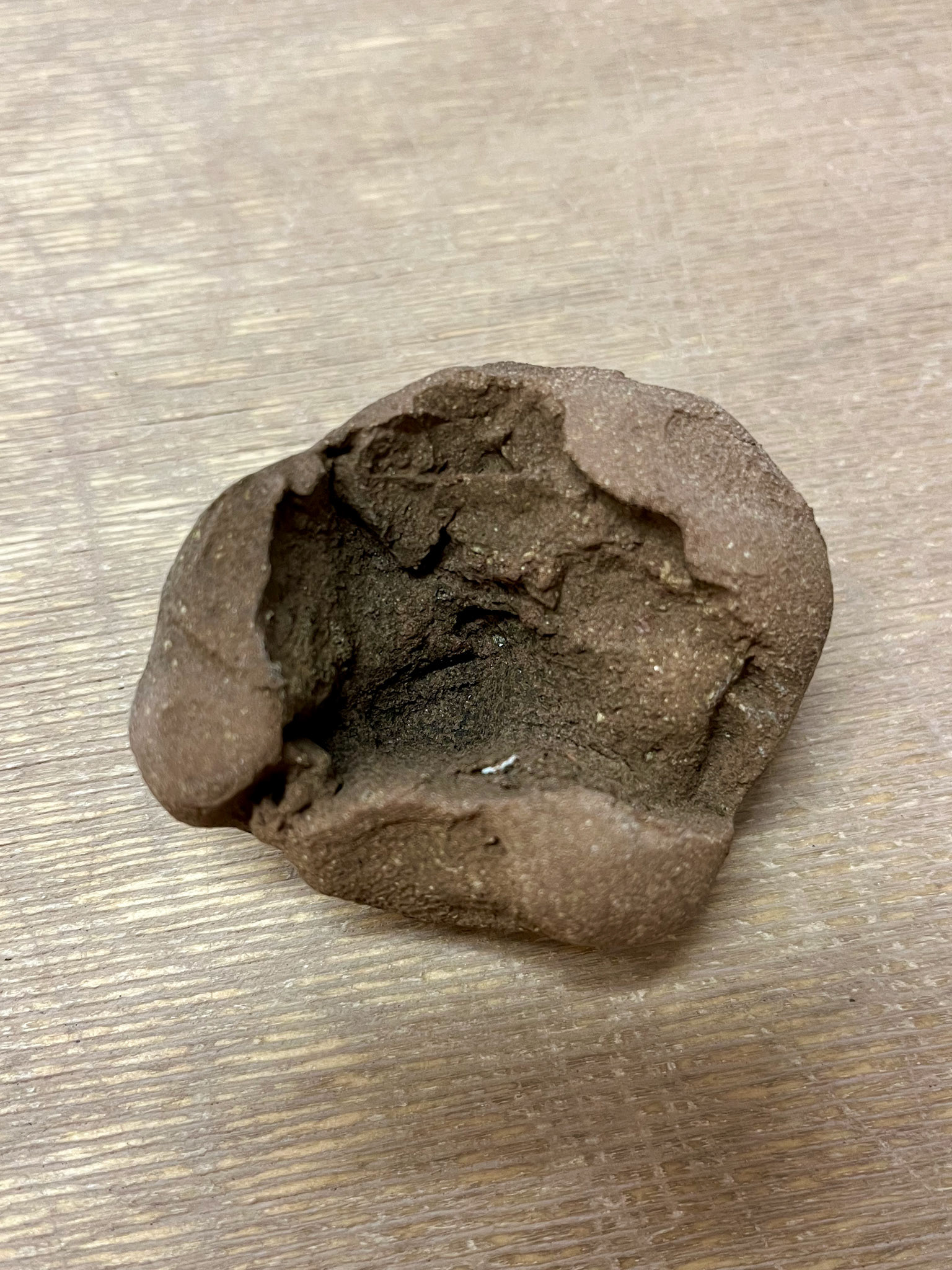
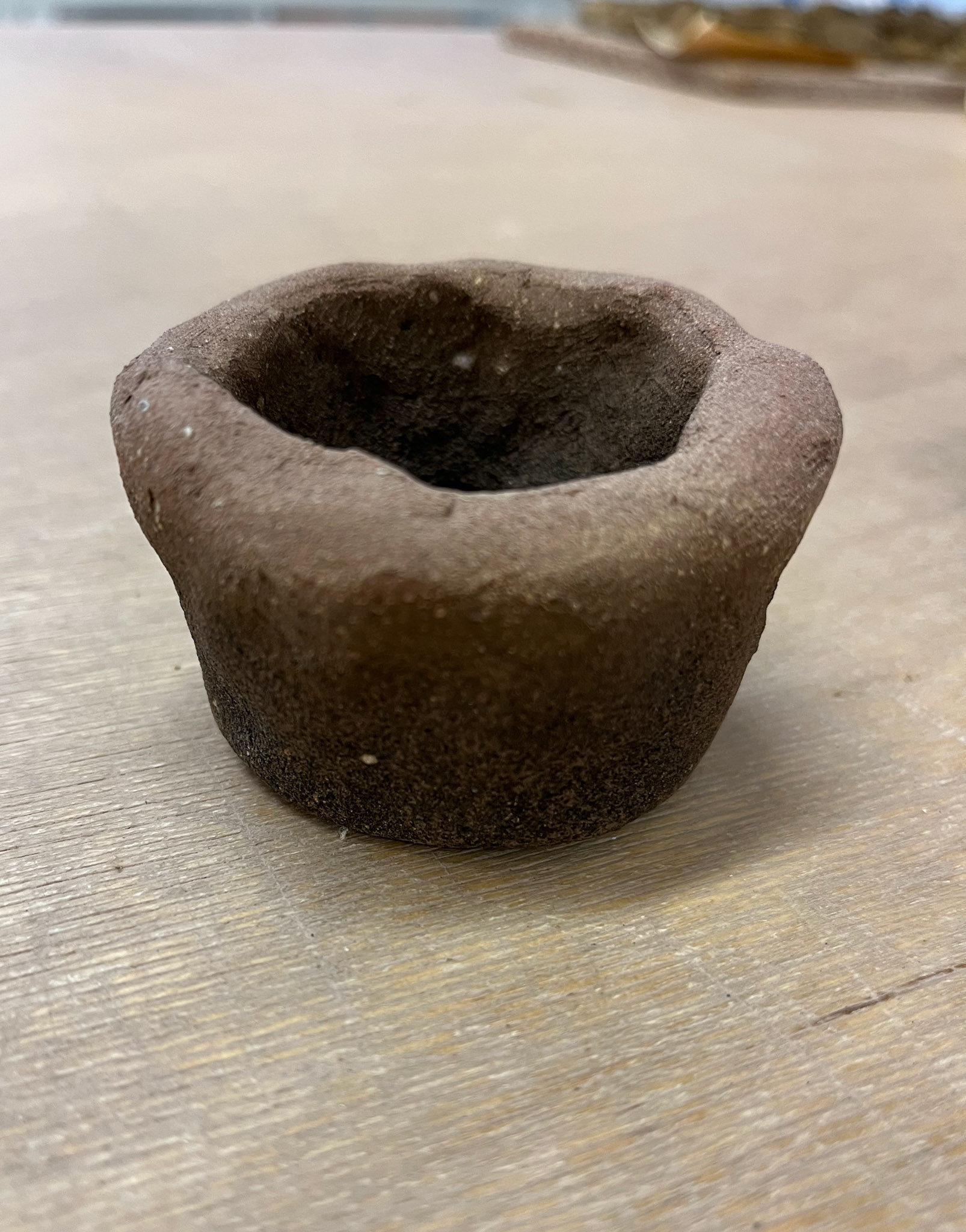
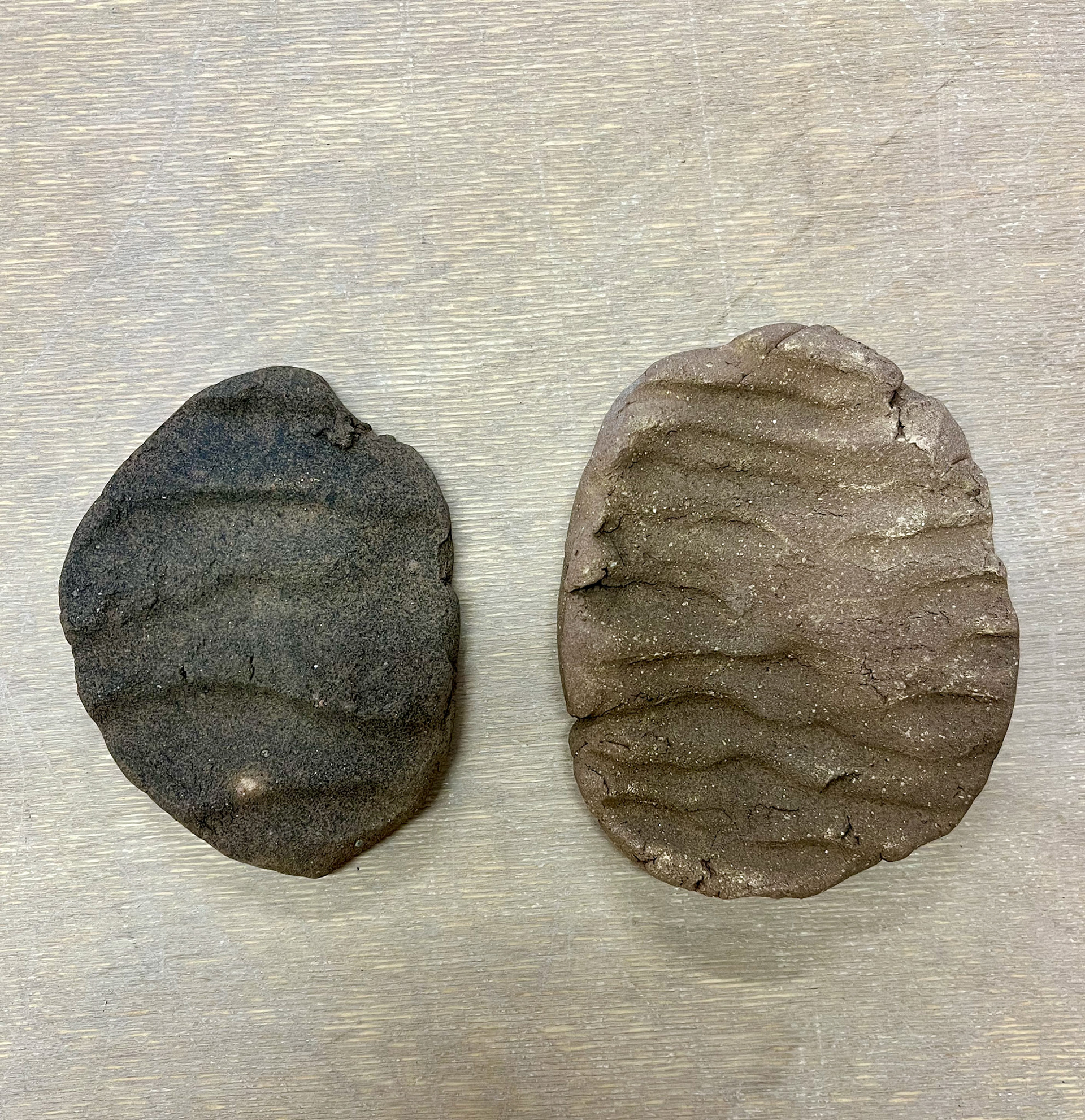
Taking inspiration from the cave
I am taking inspiration from the flowstone from the walls of the caves and bringing it into hand building, to represent parts of the cave in clay form. Flowstone is the mineral deposit which is formed in caves when the water flows down the caves walls. I really wanted to pick up on these textures, as from the impressions that I made with the clay directly onto the flowstone, they came out well profound. I wanted to recreate this myself, to get a feel of the different levels and flow.
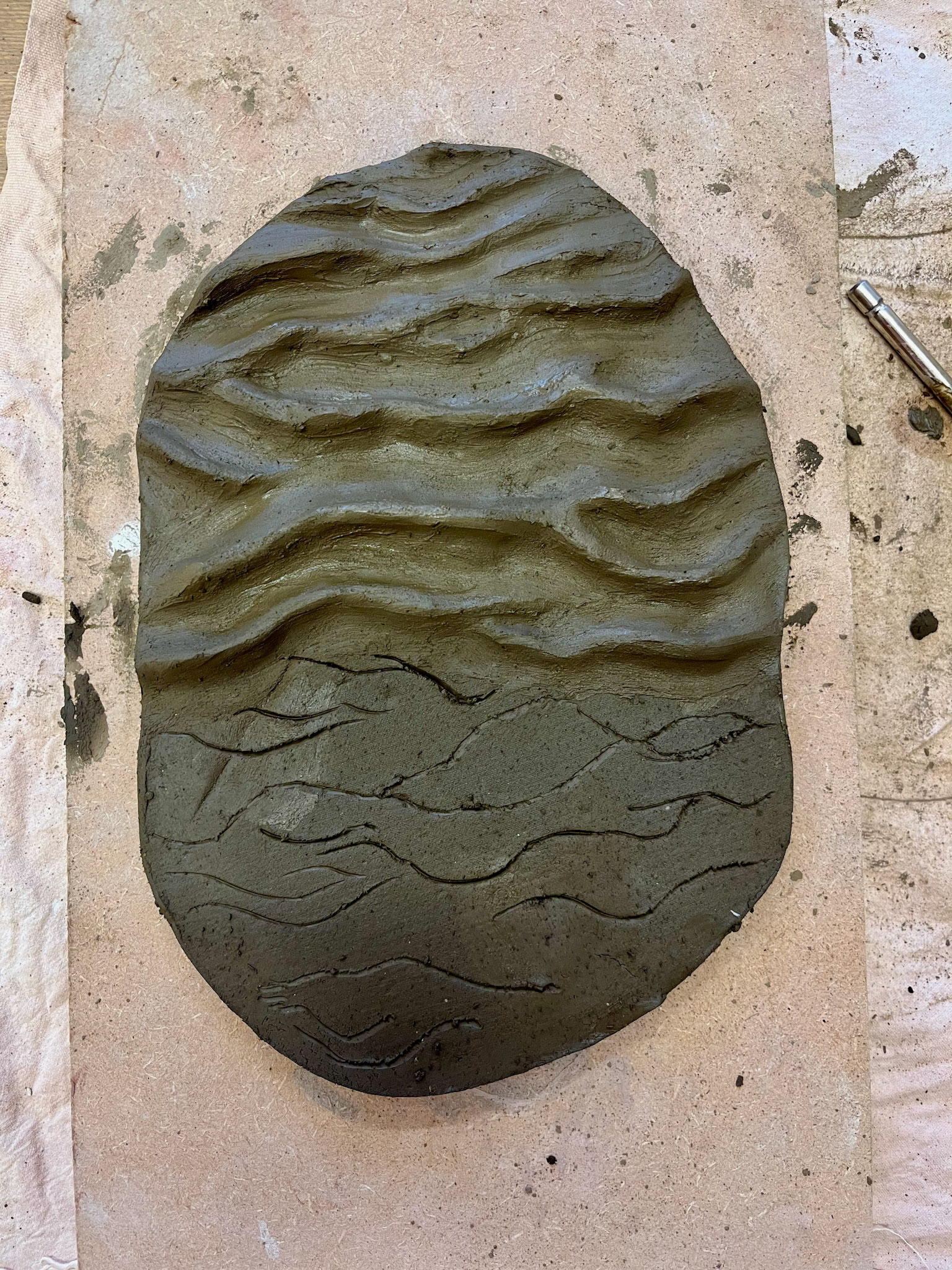
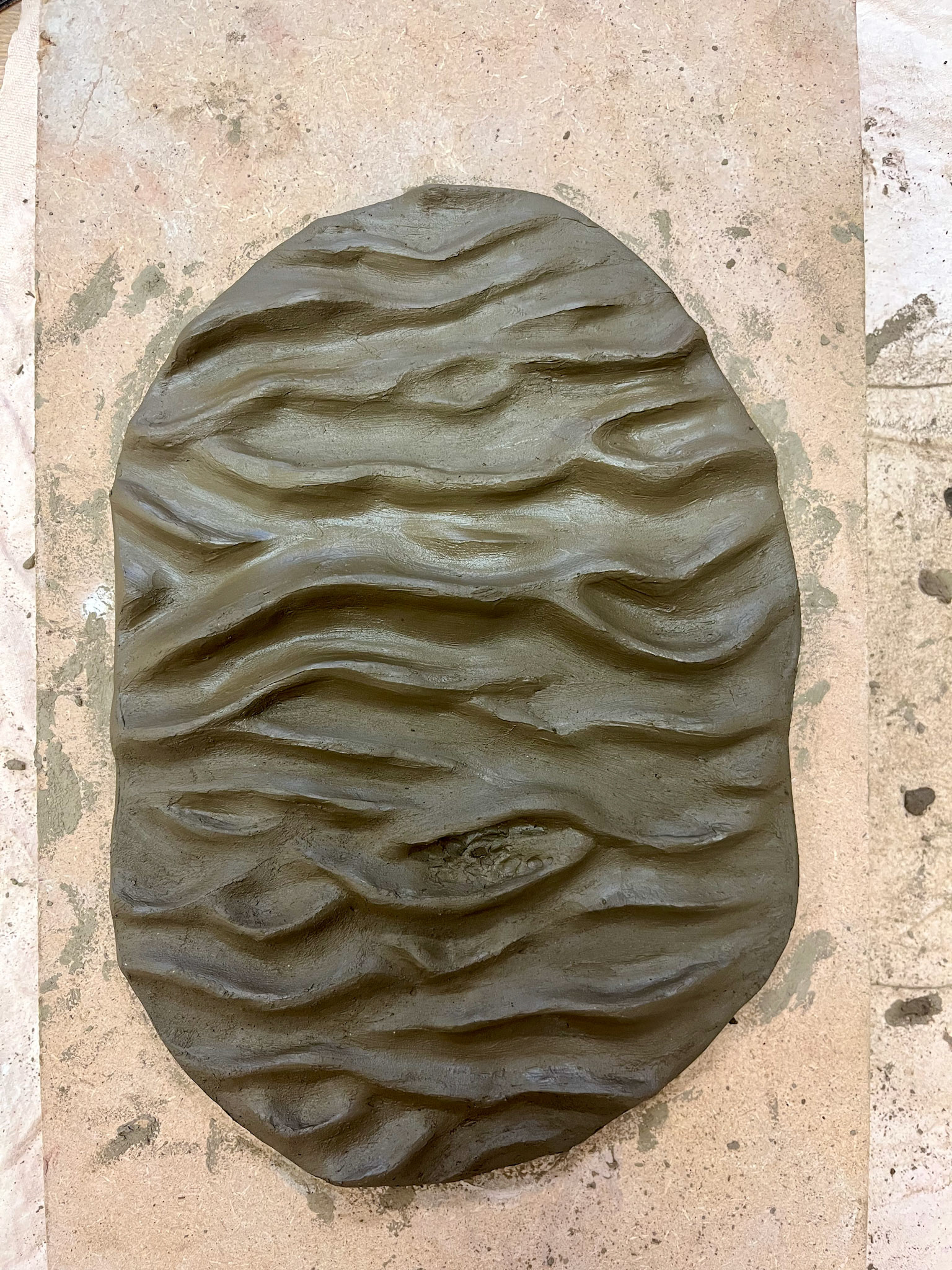
Extracting clay directly from cave into product
I wanted to keep the clay in the form that I dug it up in, to keep it as raw and in its natural shape as possible. Because I am digging the clay with my hands, the shapes are kept as they were when I dug them. I wanted to keep them like this, as the minerals and different colours show through without having to disrupt or over handle the clay.
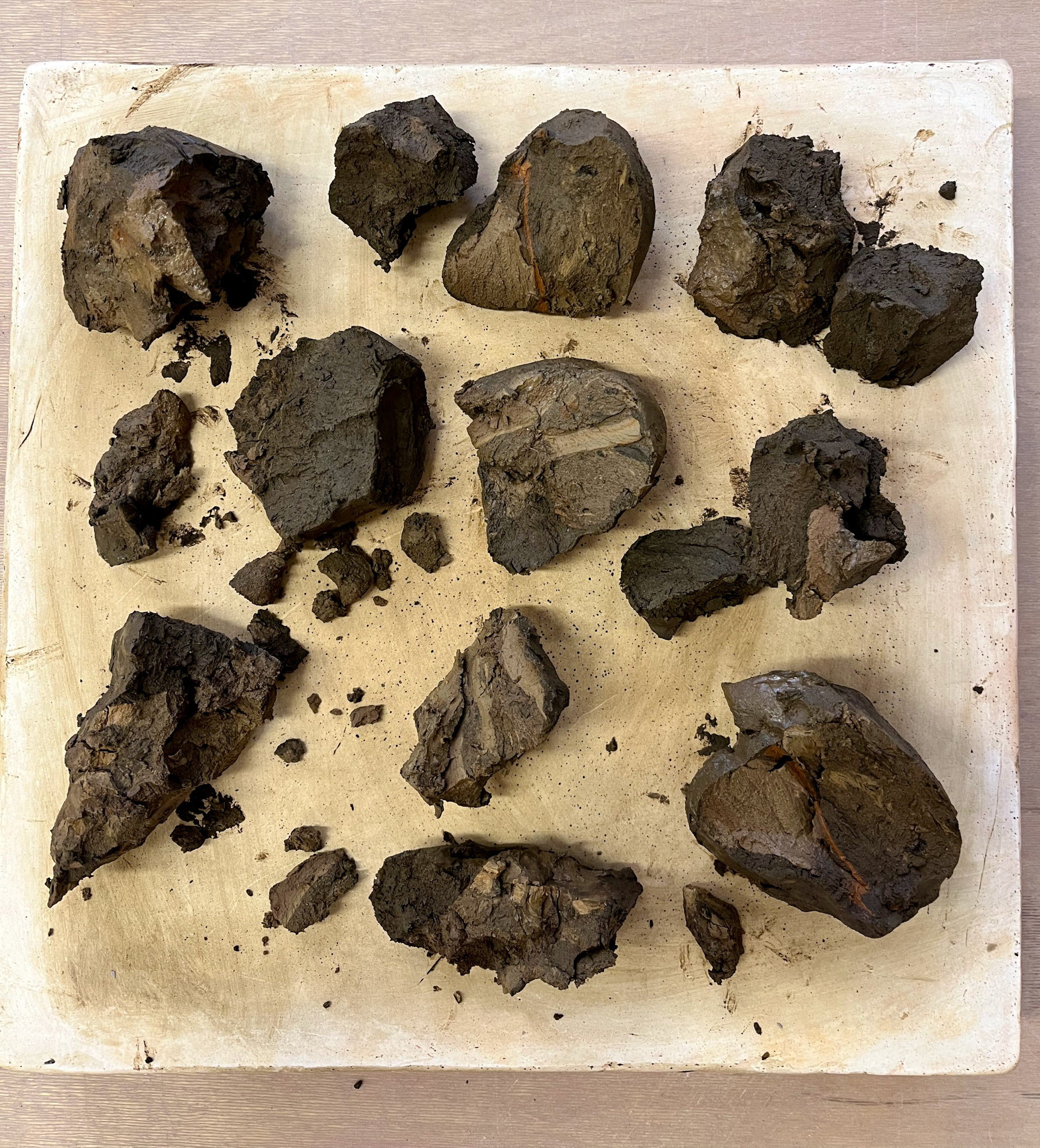

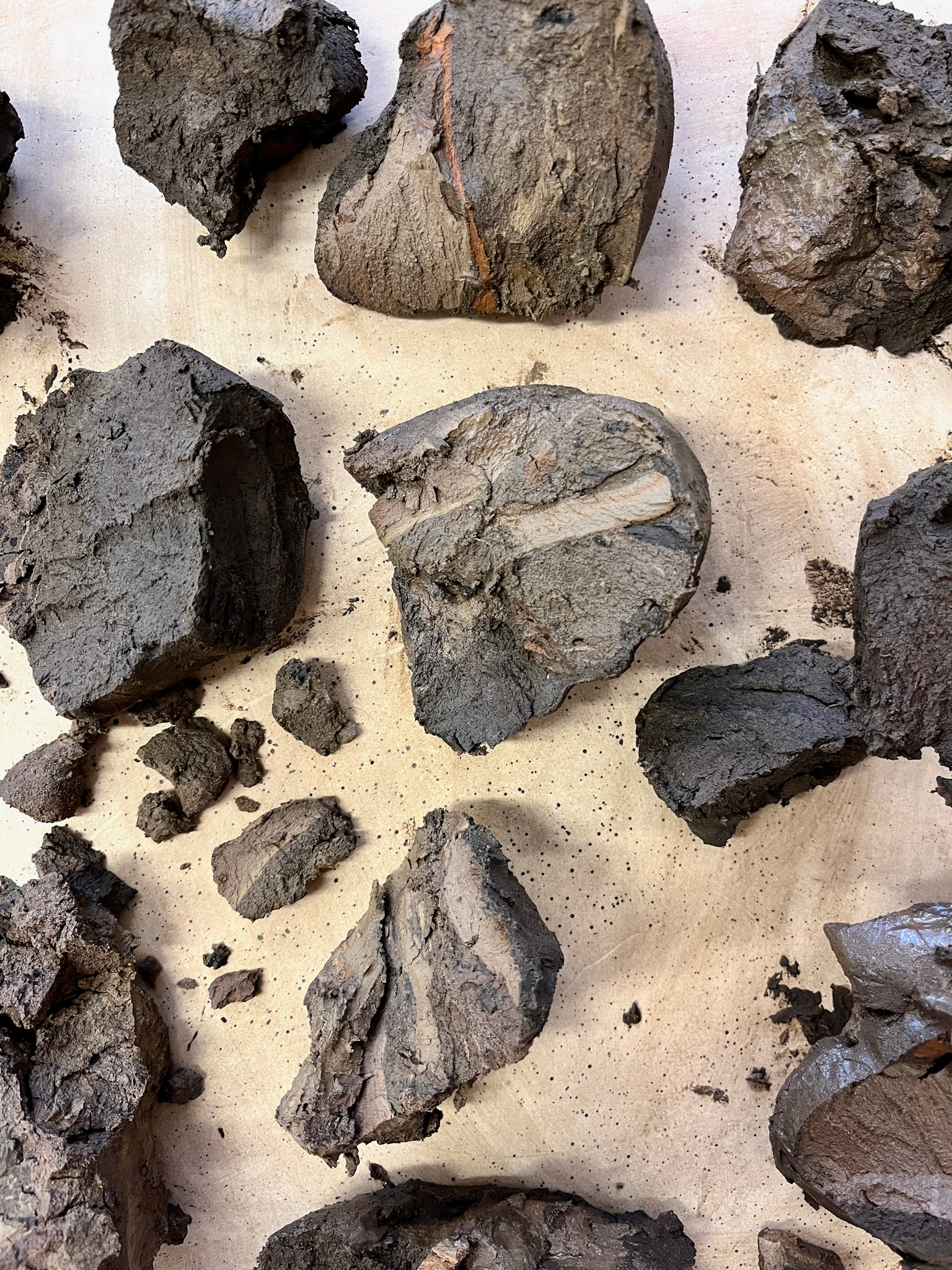
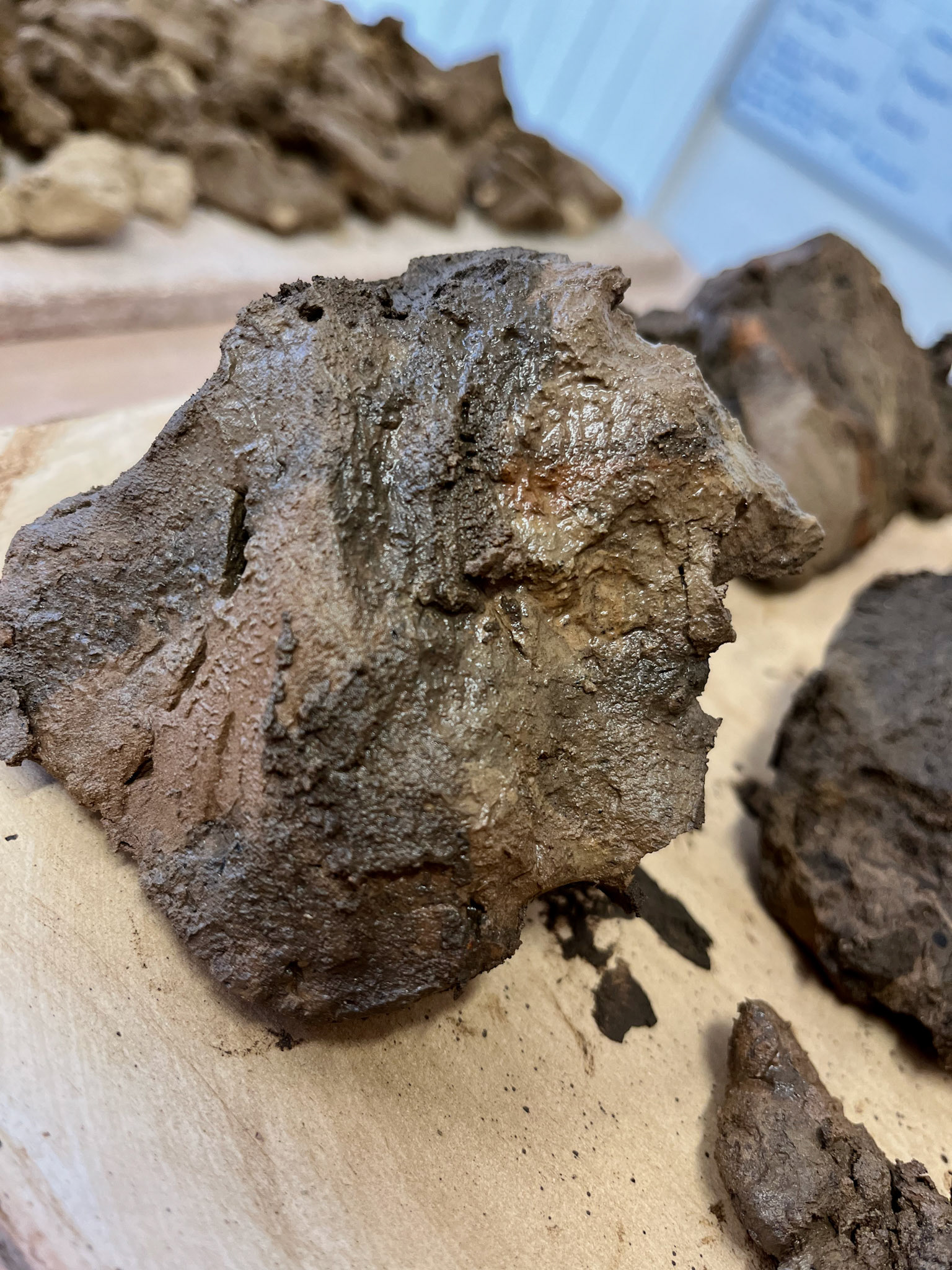

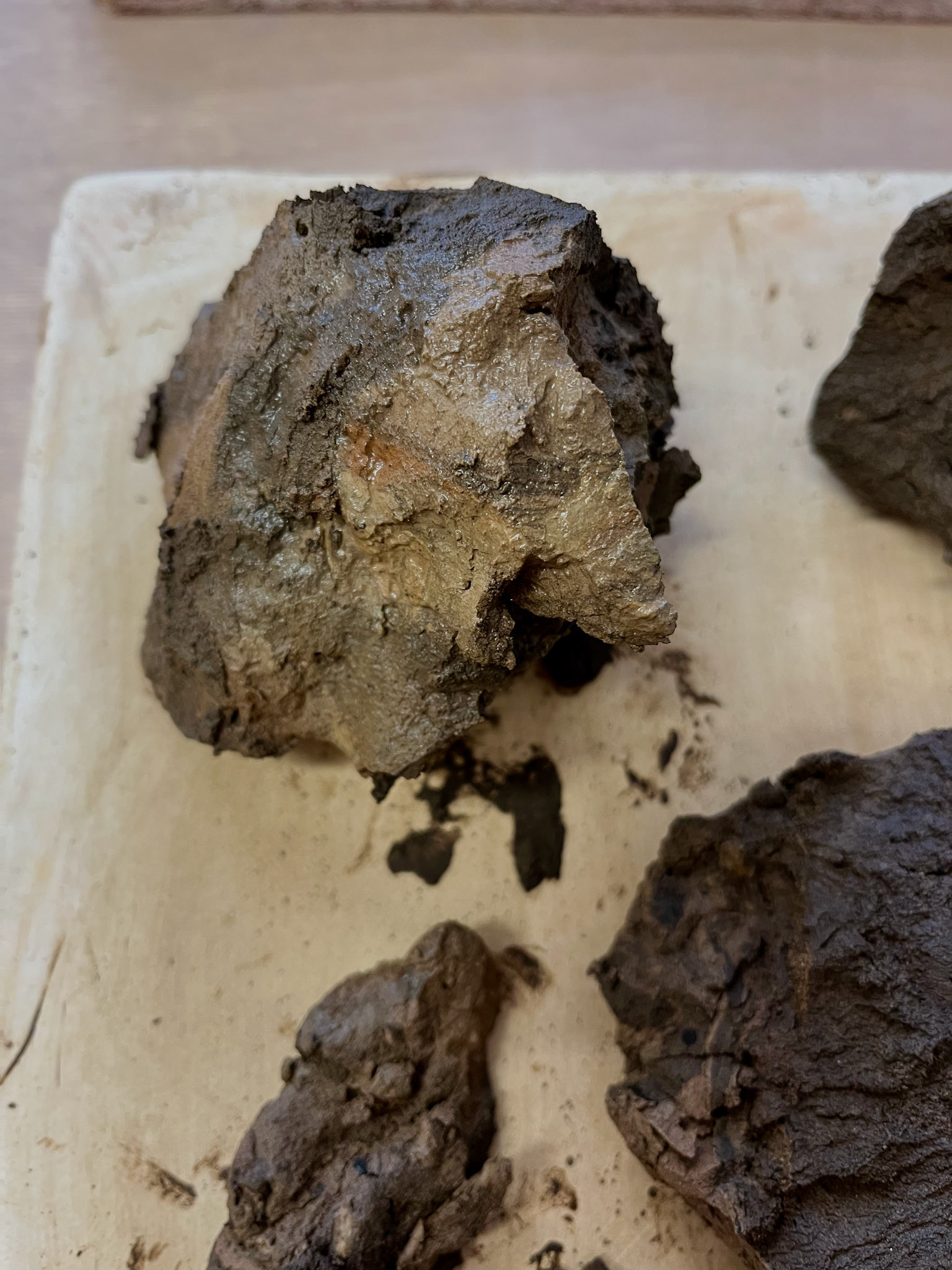
I find this clay extremely interesting due to the iron content and the minerals. This colour difference is due to the different mineral composition, which will have been formed when the sediment got into the cave when the glaciers were melting, when the cave was forming.
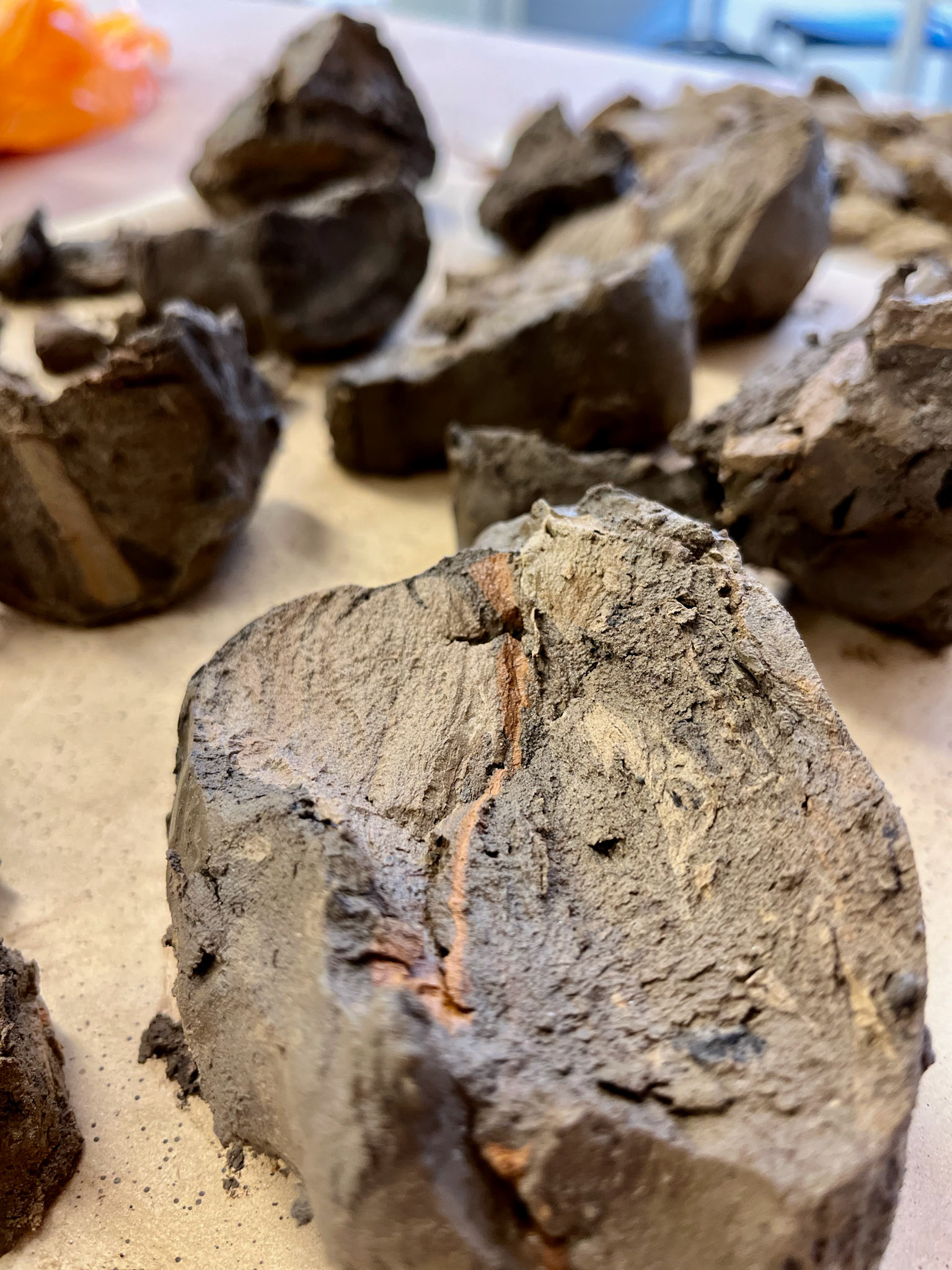

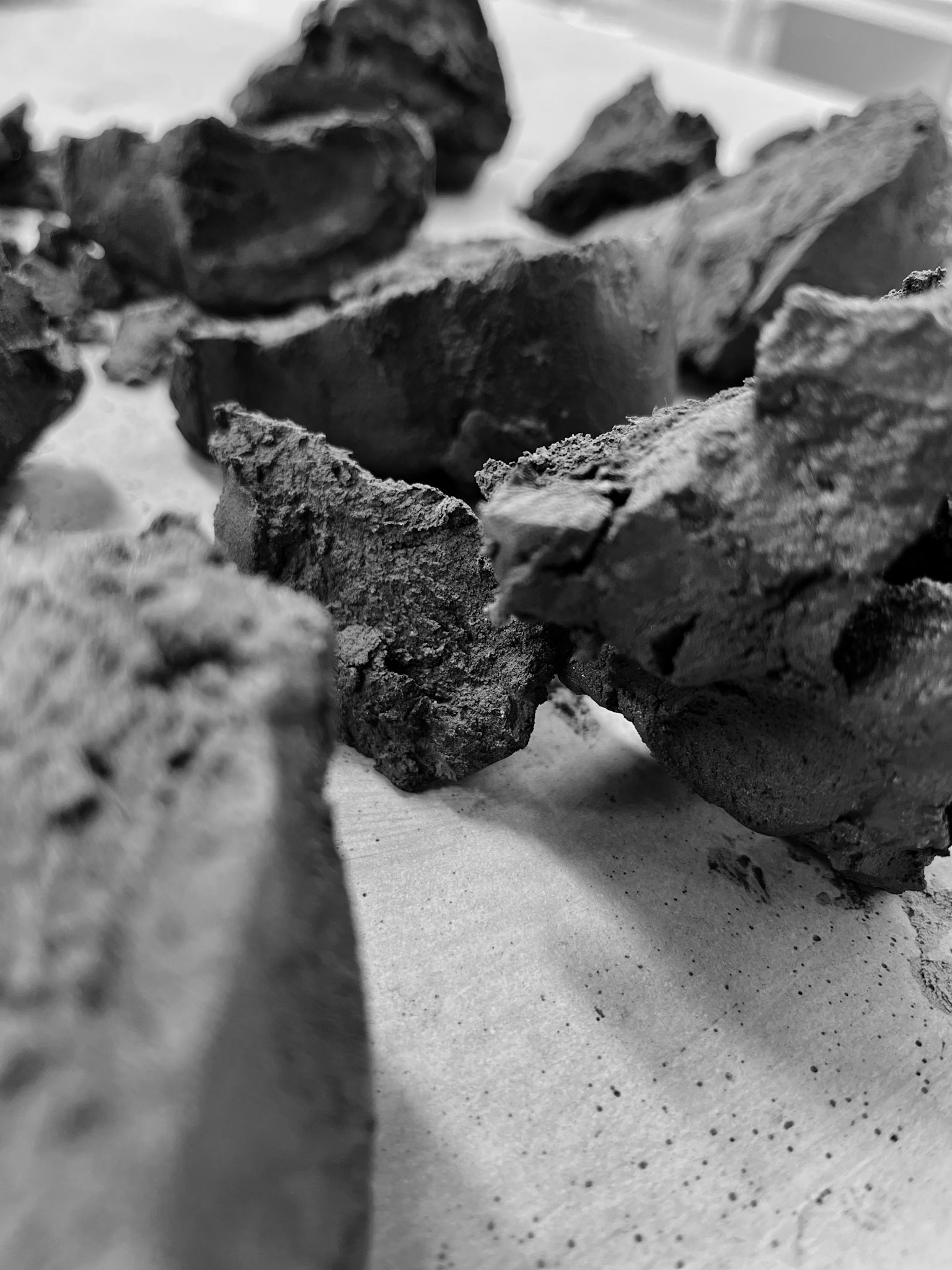
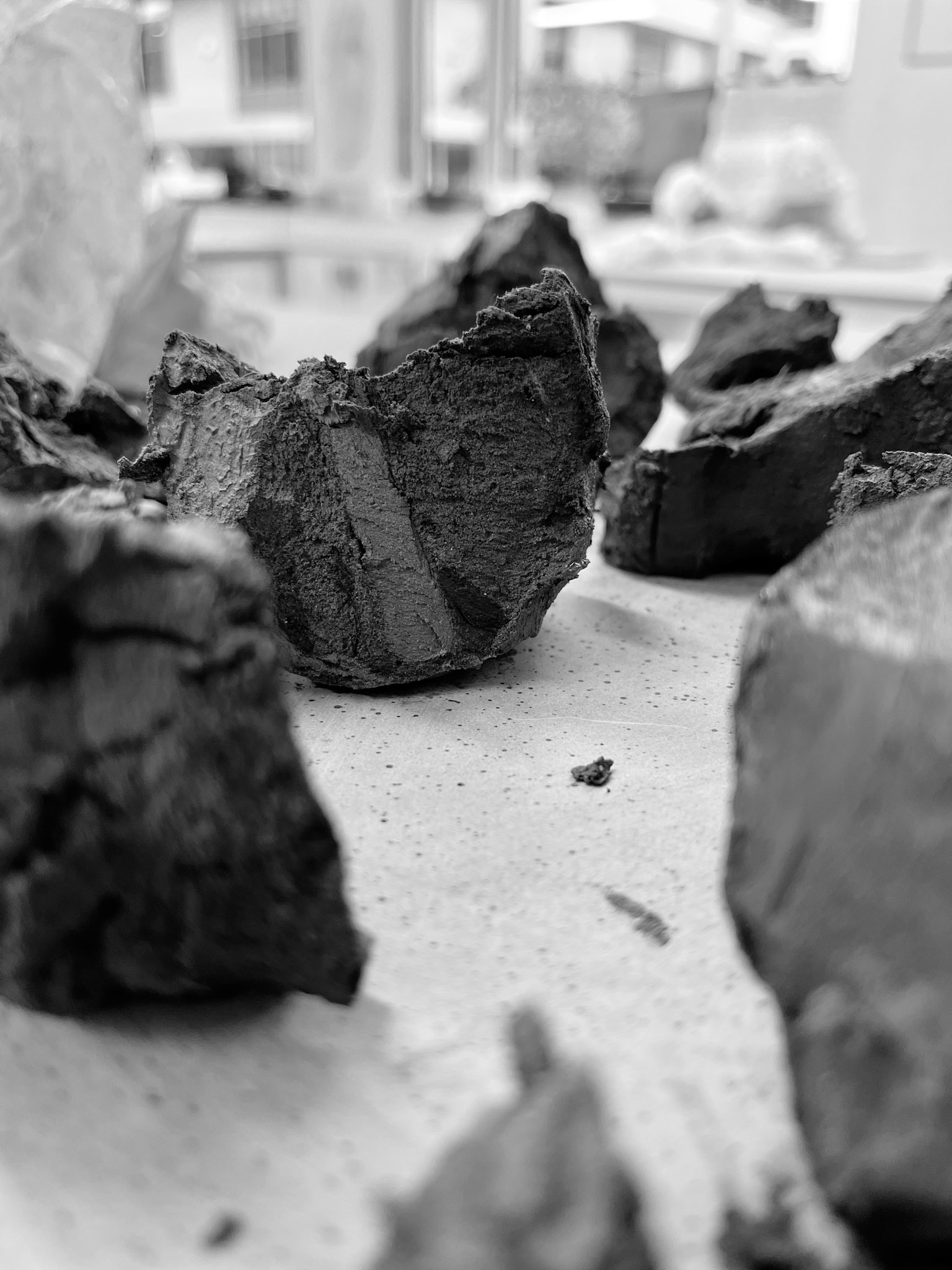
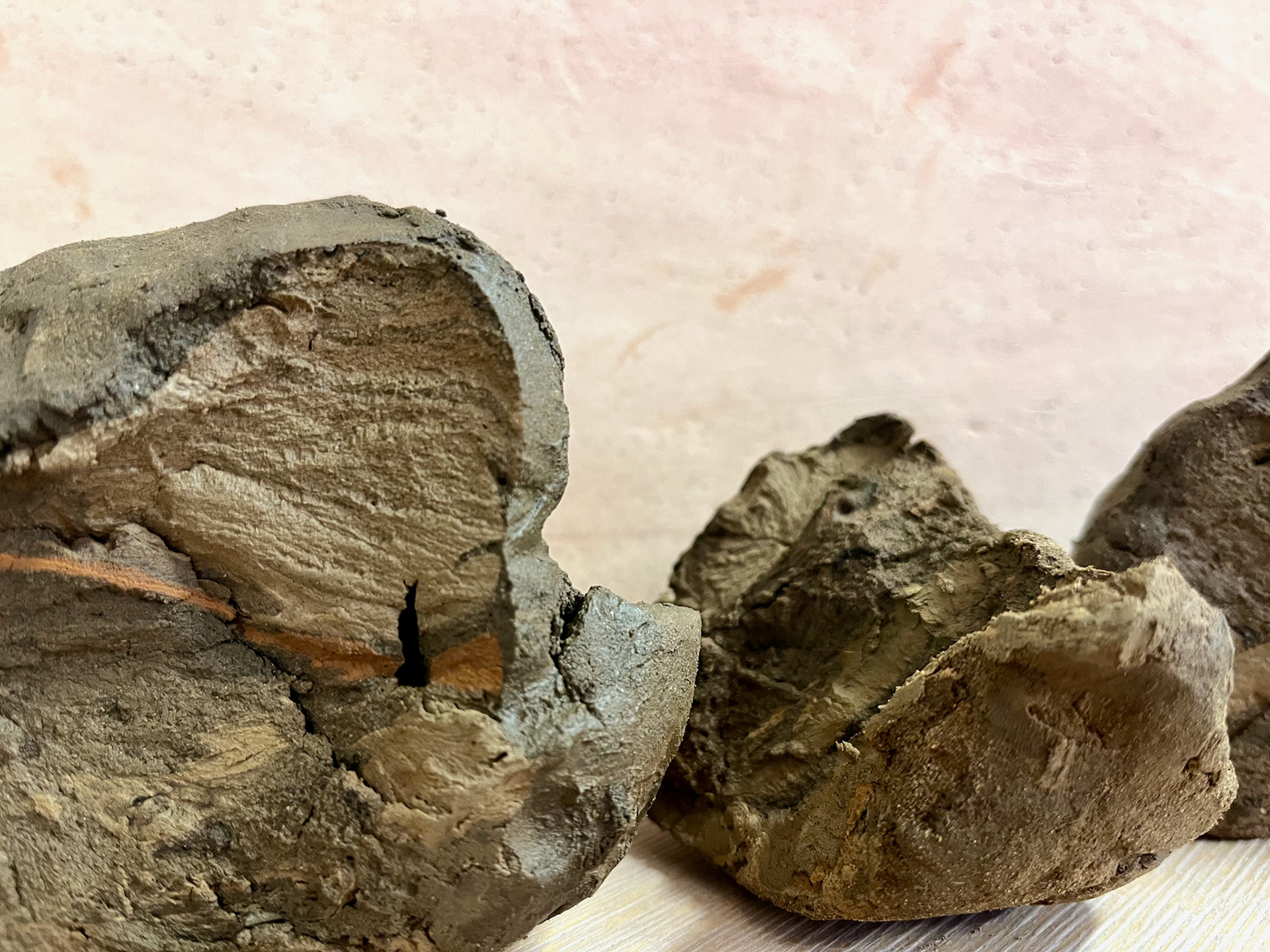

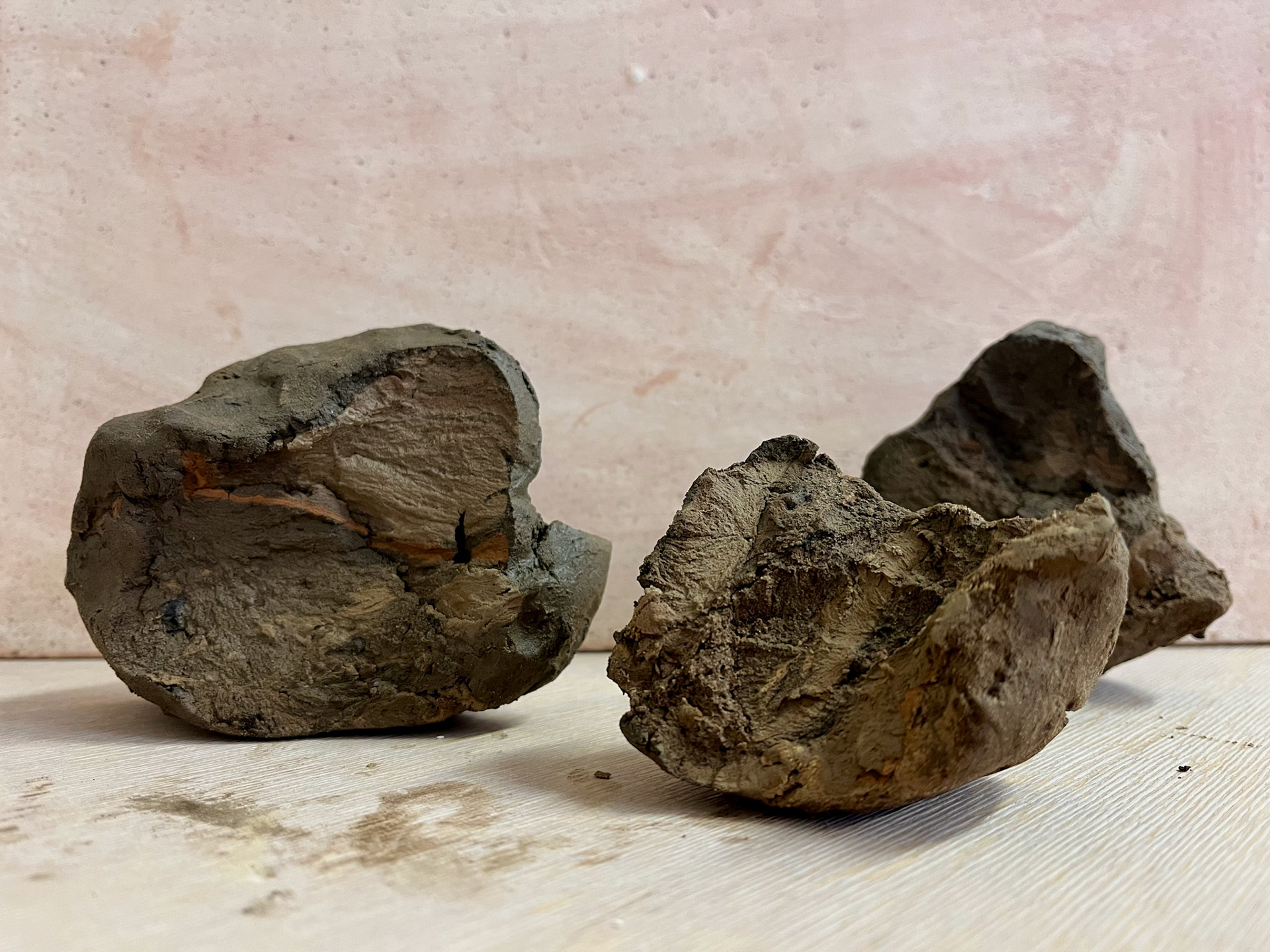

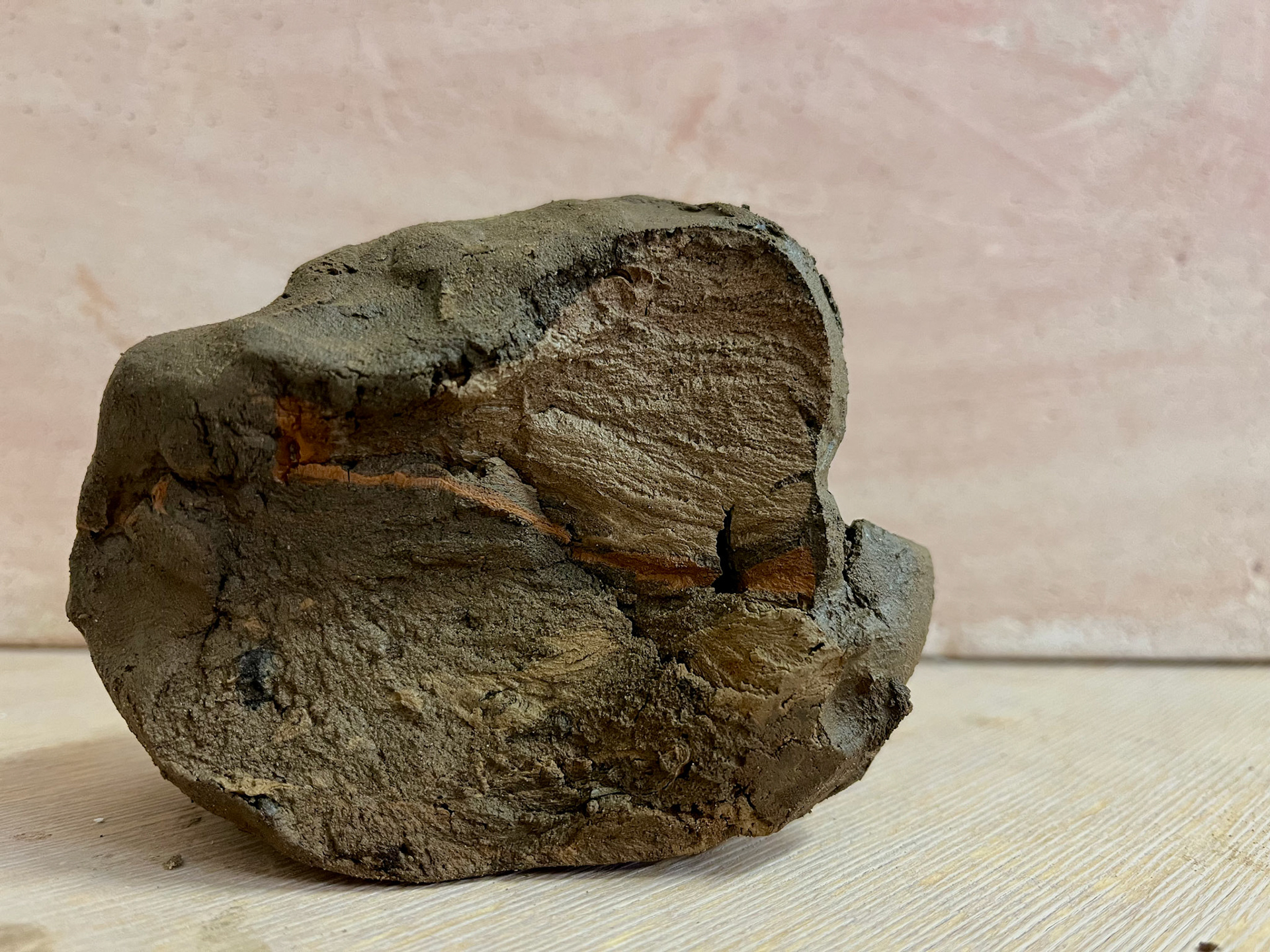
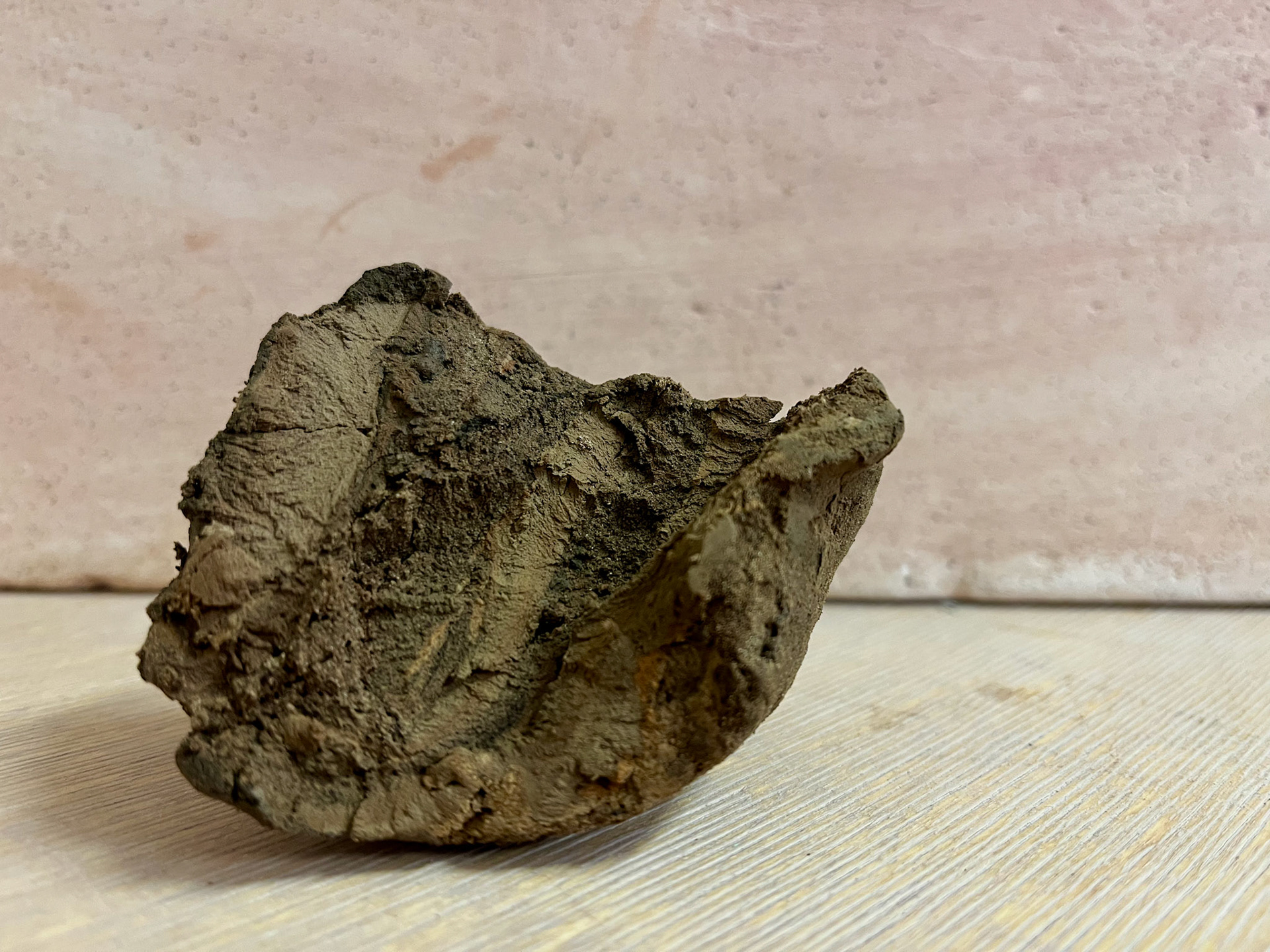
Different stages of the clay process
From the state of the clay at leather hard, I had quite low expectations of if I was to fire it. I tried firing very small segments in a saggar, as because of the high mineral content we did not know how it would fire. I fired two small pieces to Bisque temperature and two to Earthenware to test if it would collapse in the kiln. I was very pleasantly surprised by the results of the firing, as the colours came through stronger than I thought. I will track the pieces progress over the next few days to see its progress, and whether it keeps its shape or starts deconstructing.
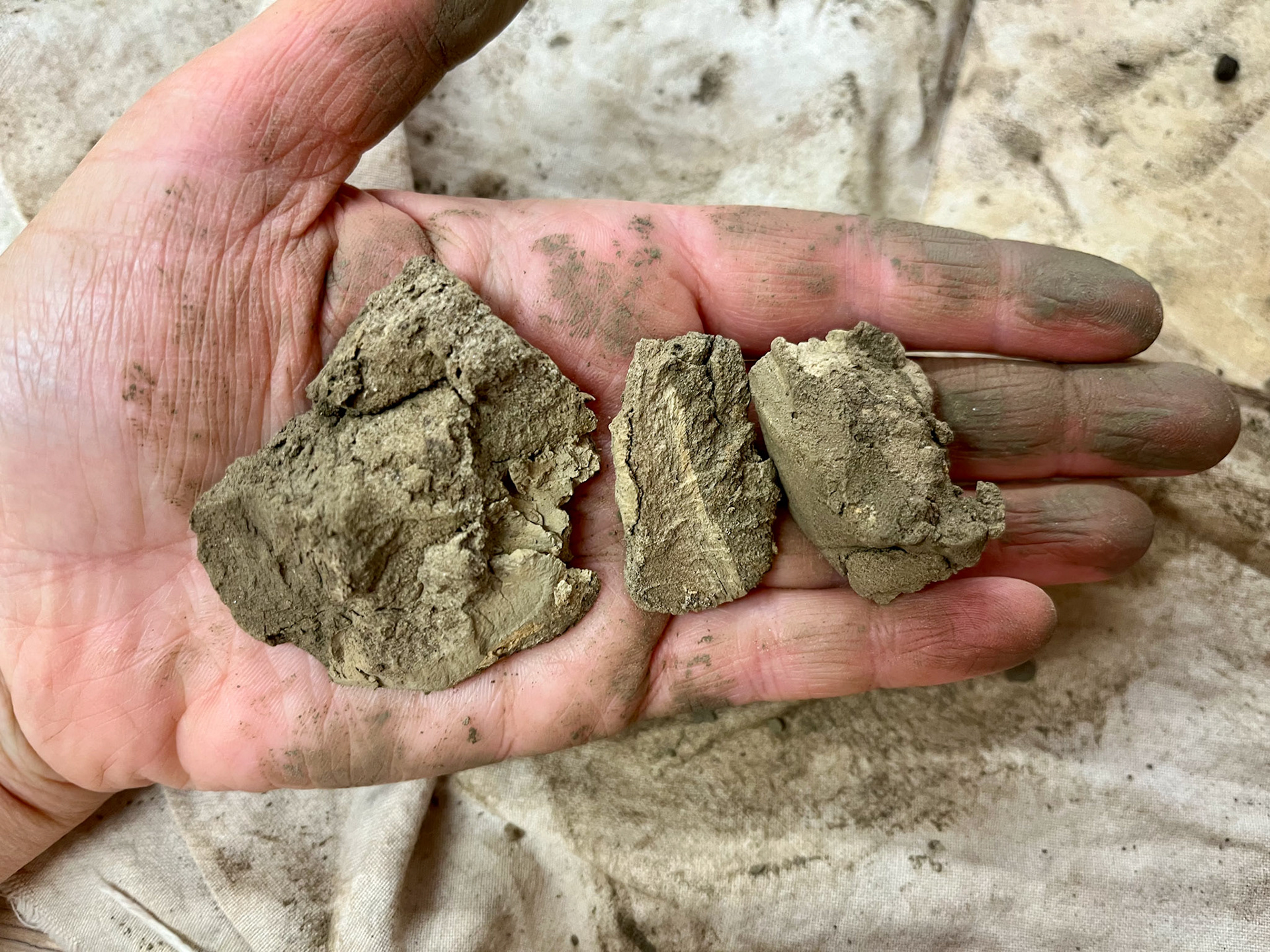
Leather hard state
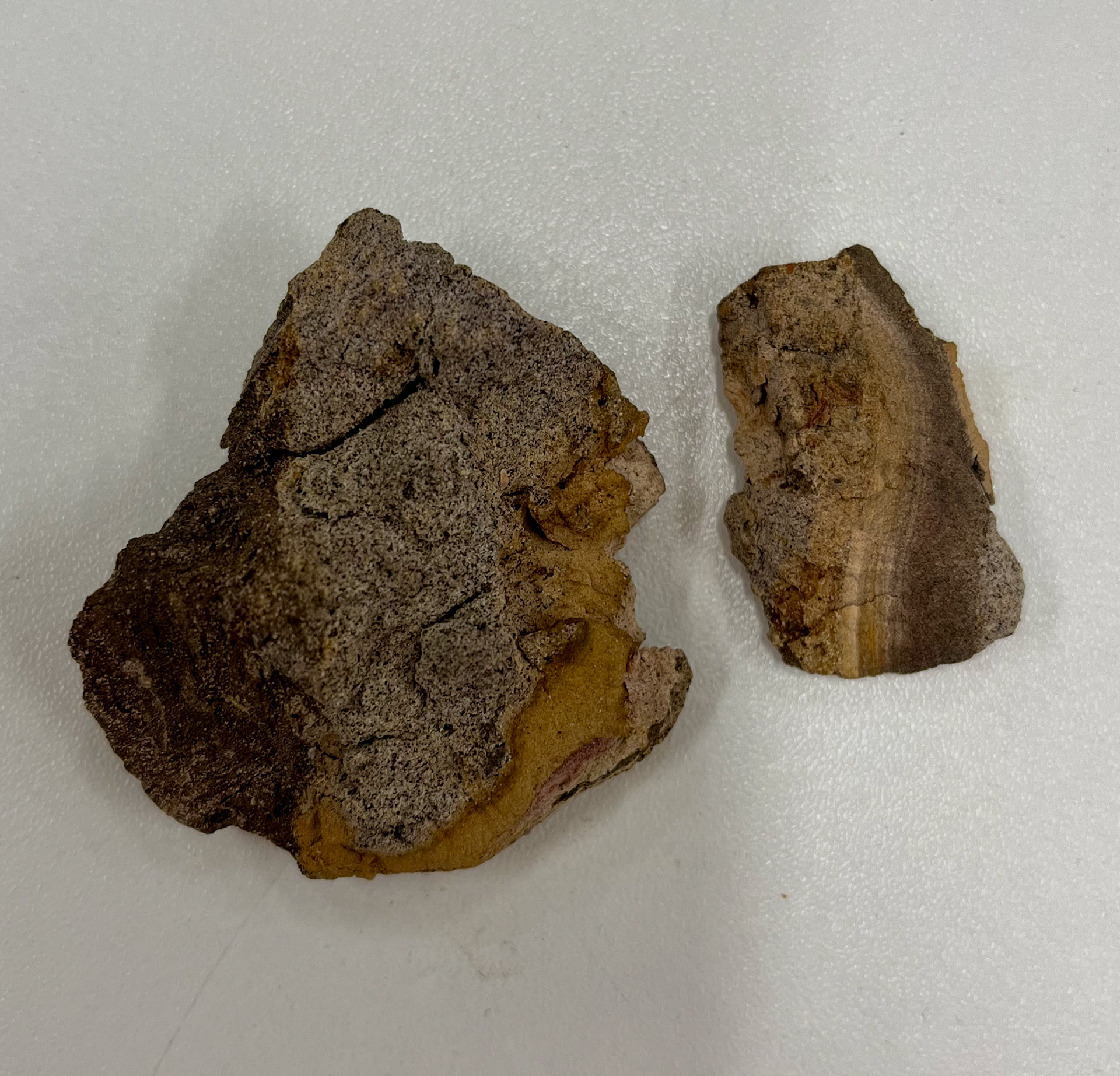
After firing at Bisque
Fired Mineral rock
I decided to fire all the mineral rocks I made, and the outcome was very successful. The different minerals in the clay melted at various points when fired at 1000 degrees bisque. Even though there are many layers and colours in the rocks, each piece stayed intact and there were no major cracks or breakages. I like the organic, rock-like shapes in these forms and going forward, I would like to use natural forms inspired by the nature I am making my work.


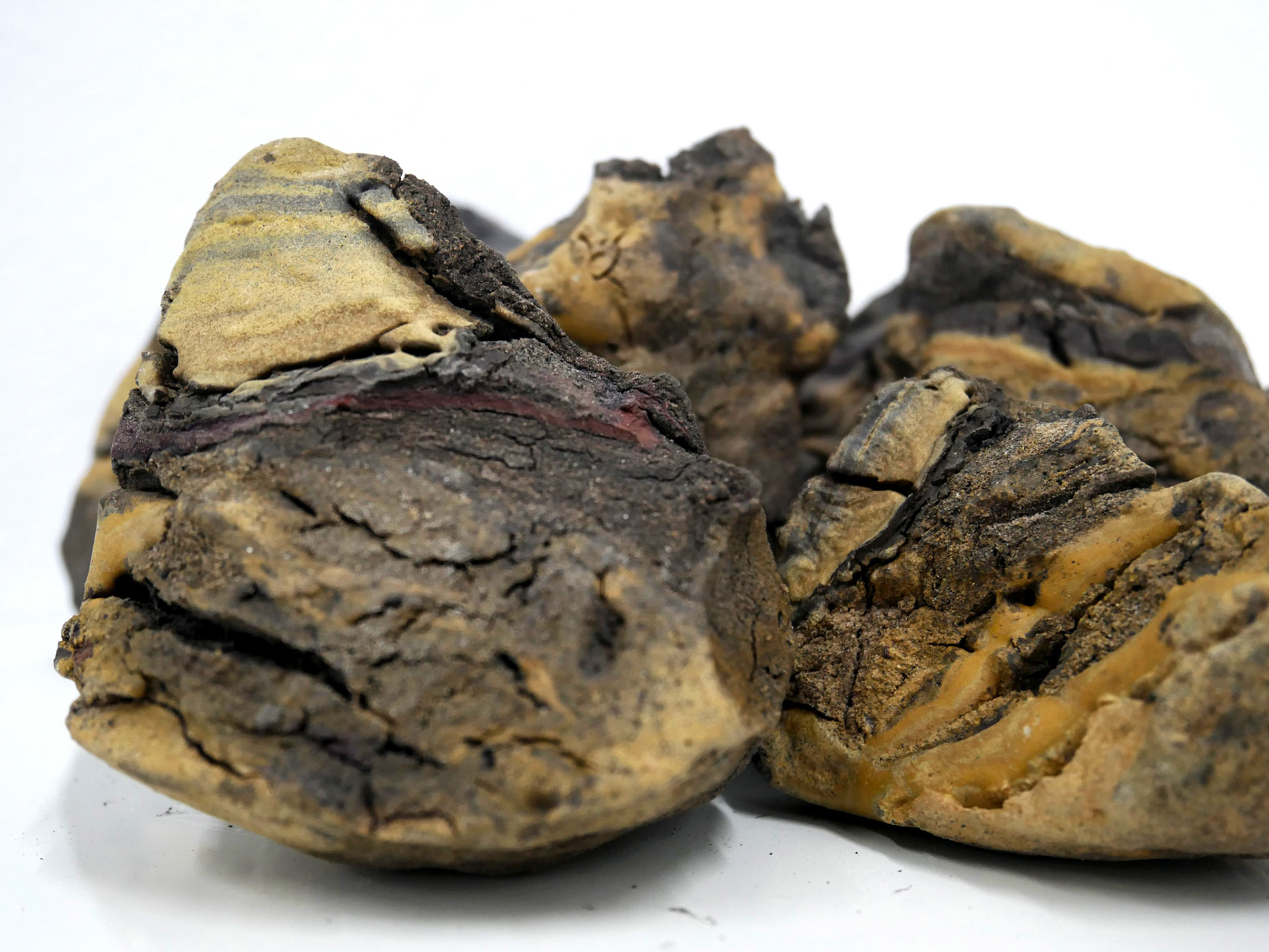
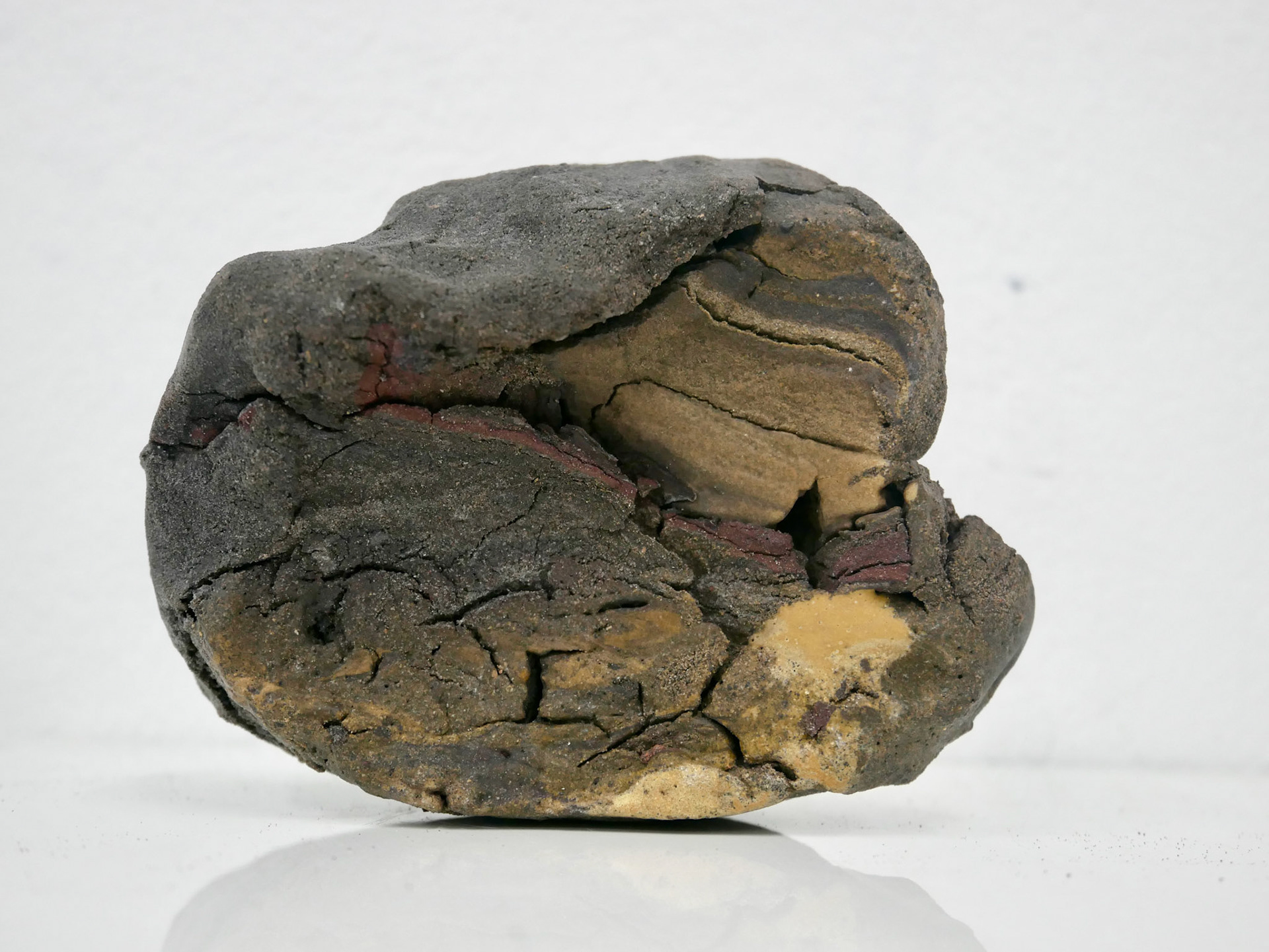
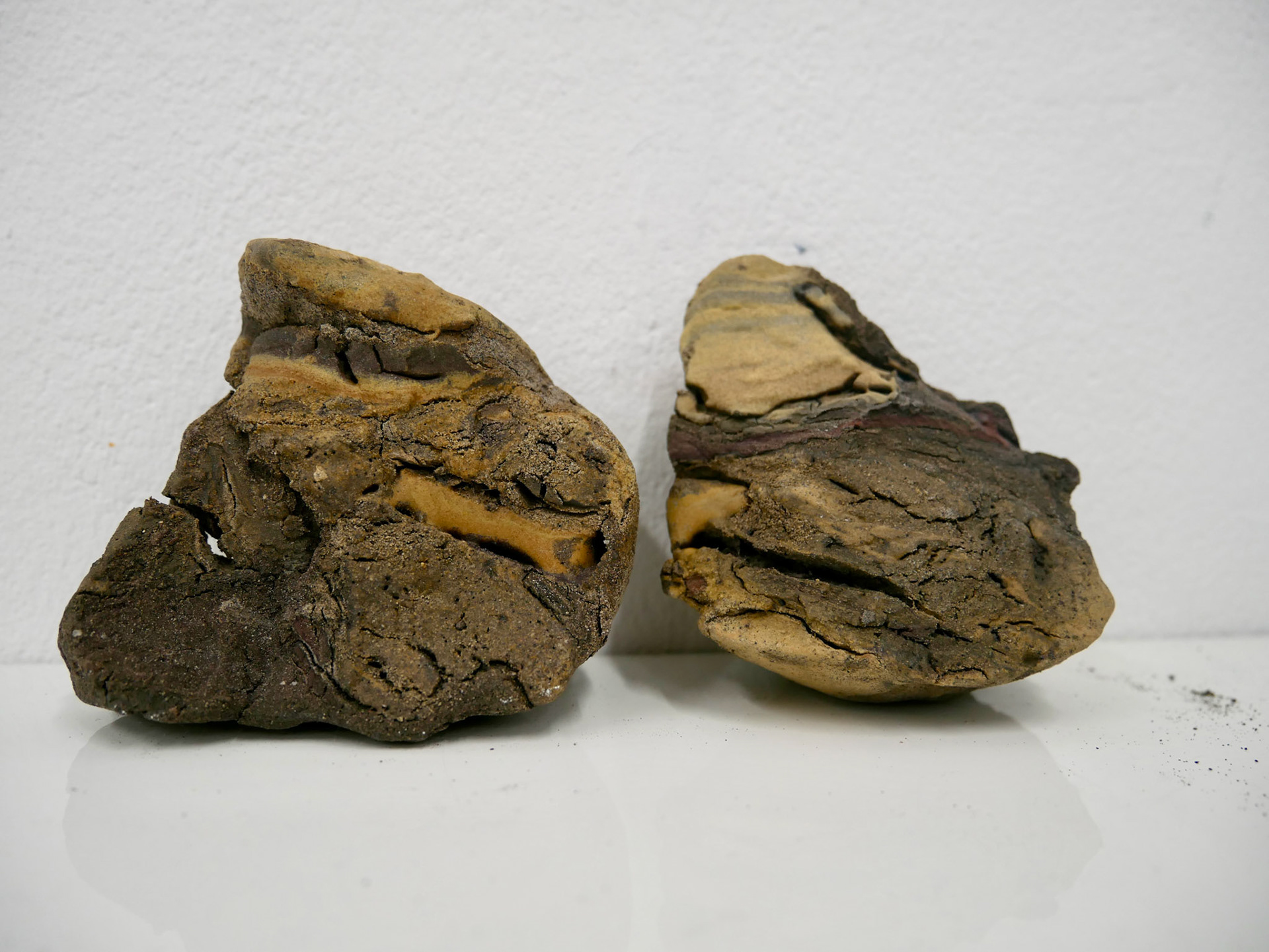
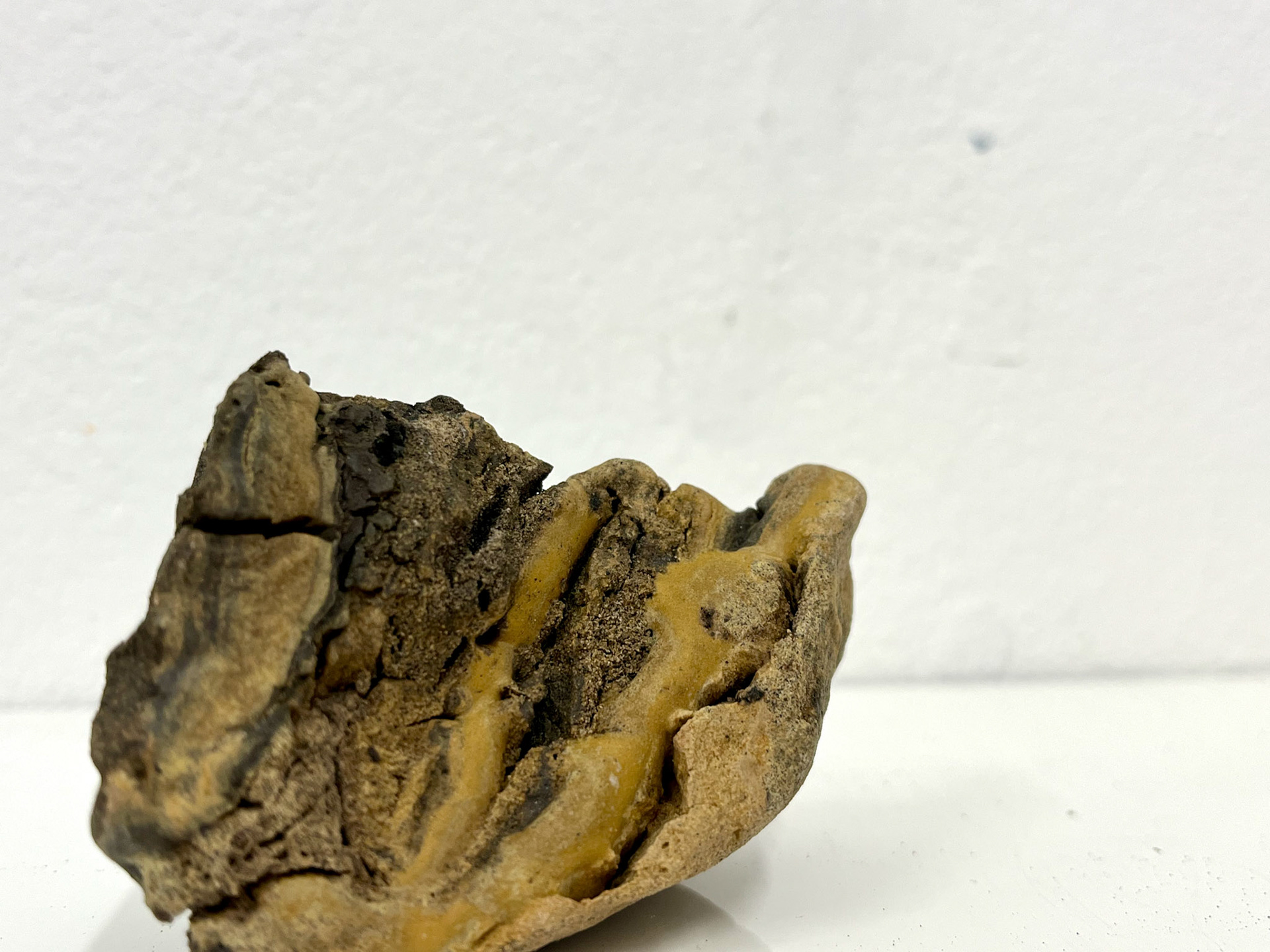
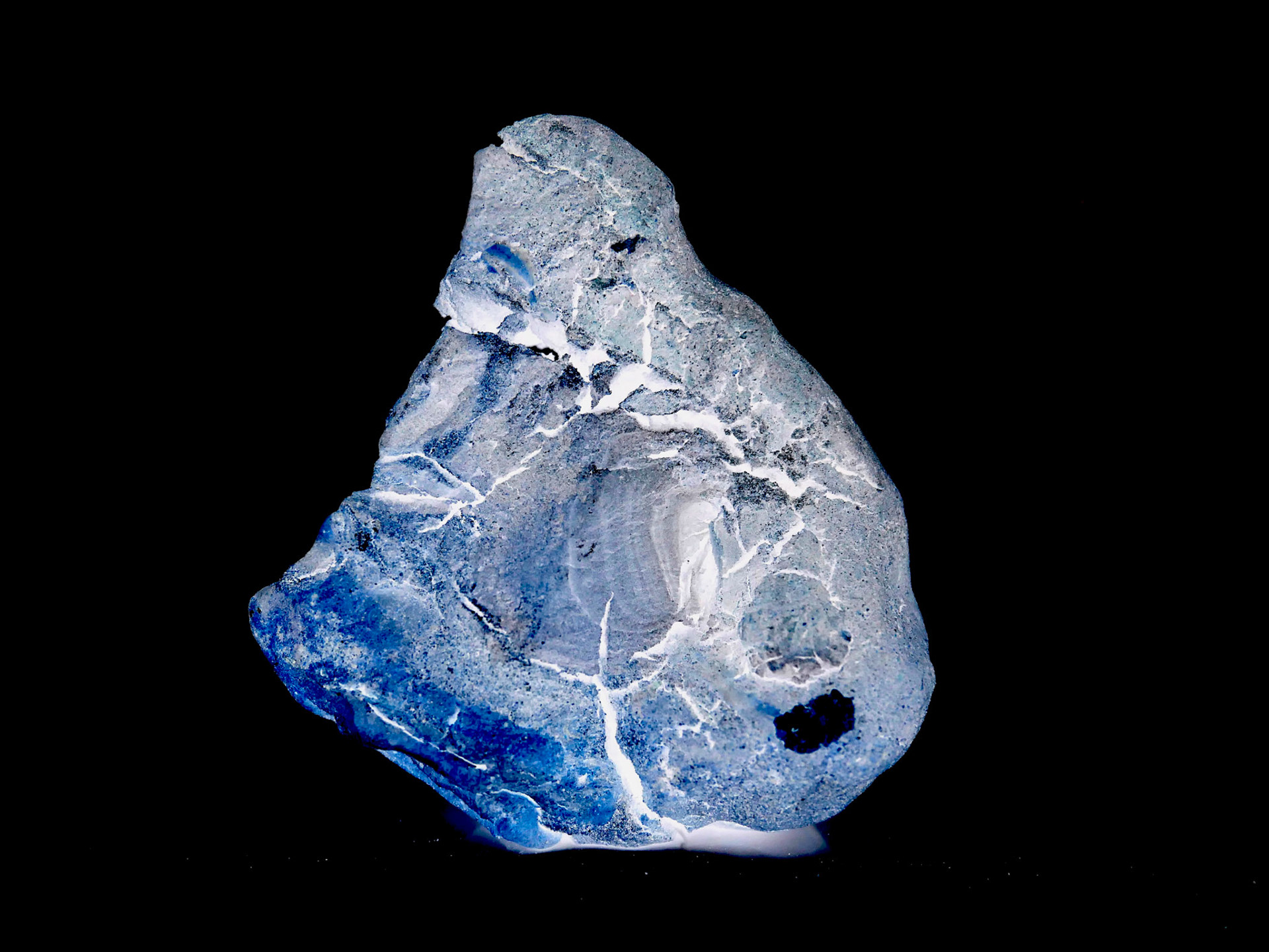
Inverted mineral rich clay
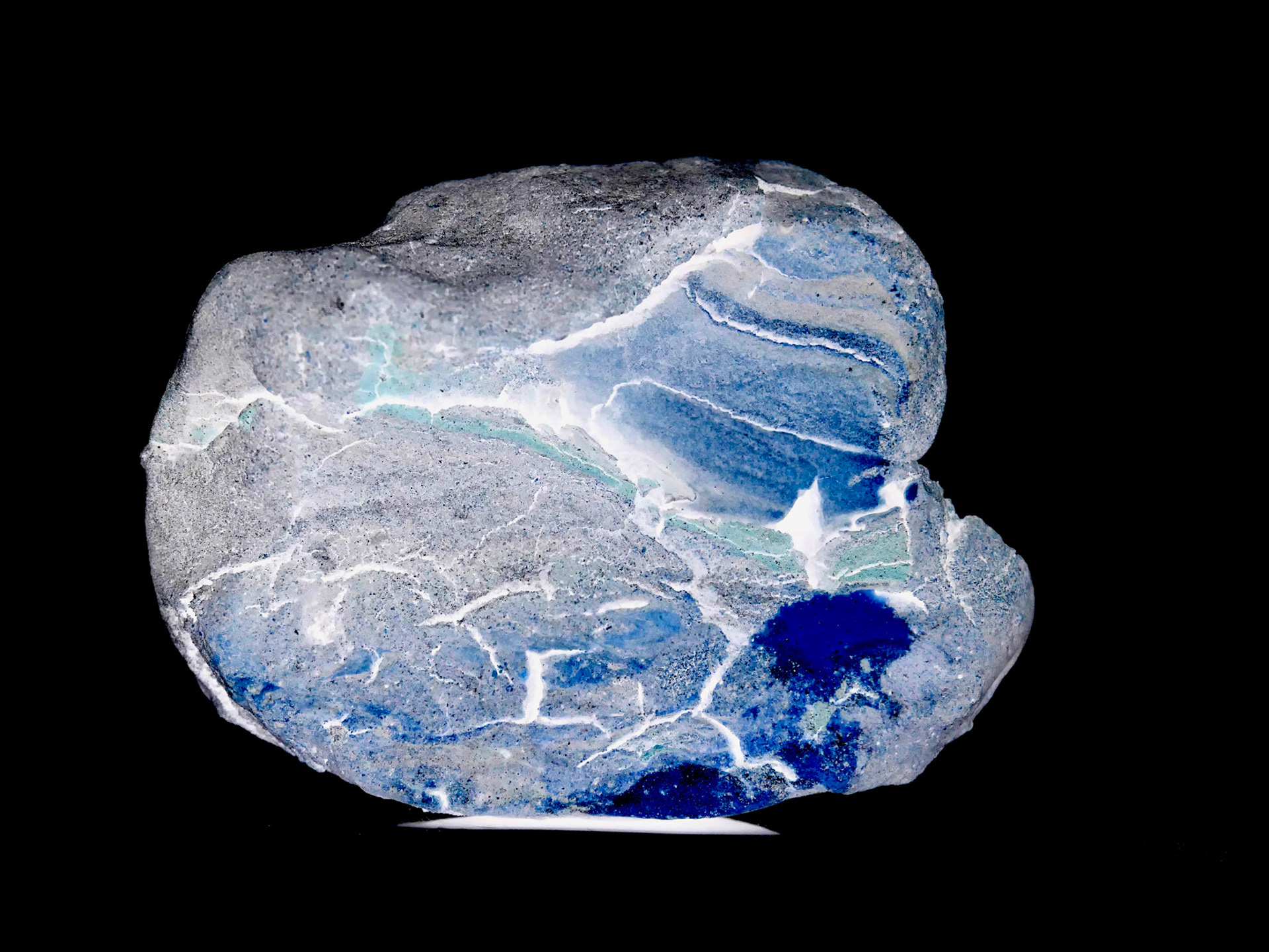
Inverted mineral rich clay
Product as a service
I have been thinking of the meaning of a Product. What this word means to me, and what comes to mind when discussing the outcome of a Product. Through conversations with tutors and fellow makers, I have become more confident in the idea that, to me, a product is not necessarily a physical, permanent thing. Rather, I am much more passionate in the idea that a Product can be ephemeral. It can be something that is a result of a series of conversation, of ideation, of learning.
Going forward, both career wise and proposing for the future unit, I am interested in the concept of community work. Of working as a collective, and a collaboration. Through this unit, I have begun to think about where I see my work going, and because of the nature of my making, and my project, I don't believe that it is right that I force my making and the clay itself, into something that it is not.
Through working in the land itself with my material, I believe that I am having a better connection with both my material, and the materials connection with the Earth. I have tried forcing my material into 'products'; things that are manufactured to be something else, that go through multiple processes, however I believe that this is providing a disconnection from the material itself.
The part of my project so far that I have enjoyed the most has been the making with clay underground. Bringing my clay back where it belongs, back where I sourced it from. Working with the textures and forms of the cave, I was really able to get a sense of the cave, and I felt like I was getting to know the cave better through the clay itself.
Going forward in this project, I will be investigating this feeling of working underground further. I aim to learn what the materiality of craft means to me, and create an archive of work that reflects my understanding of clay in place.
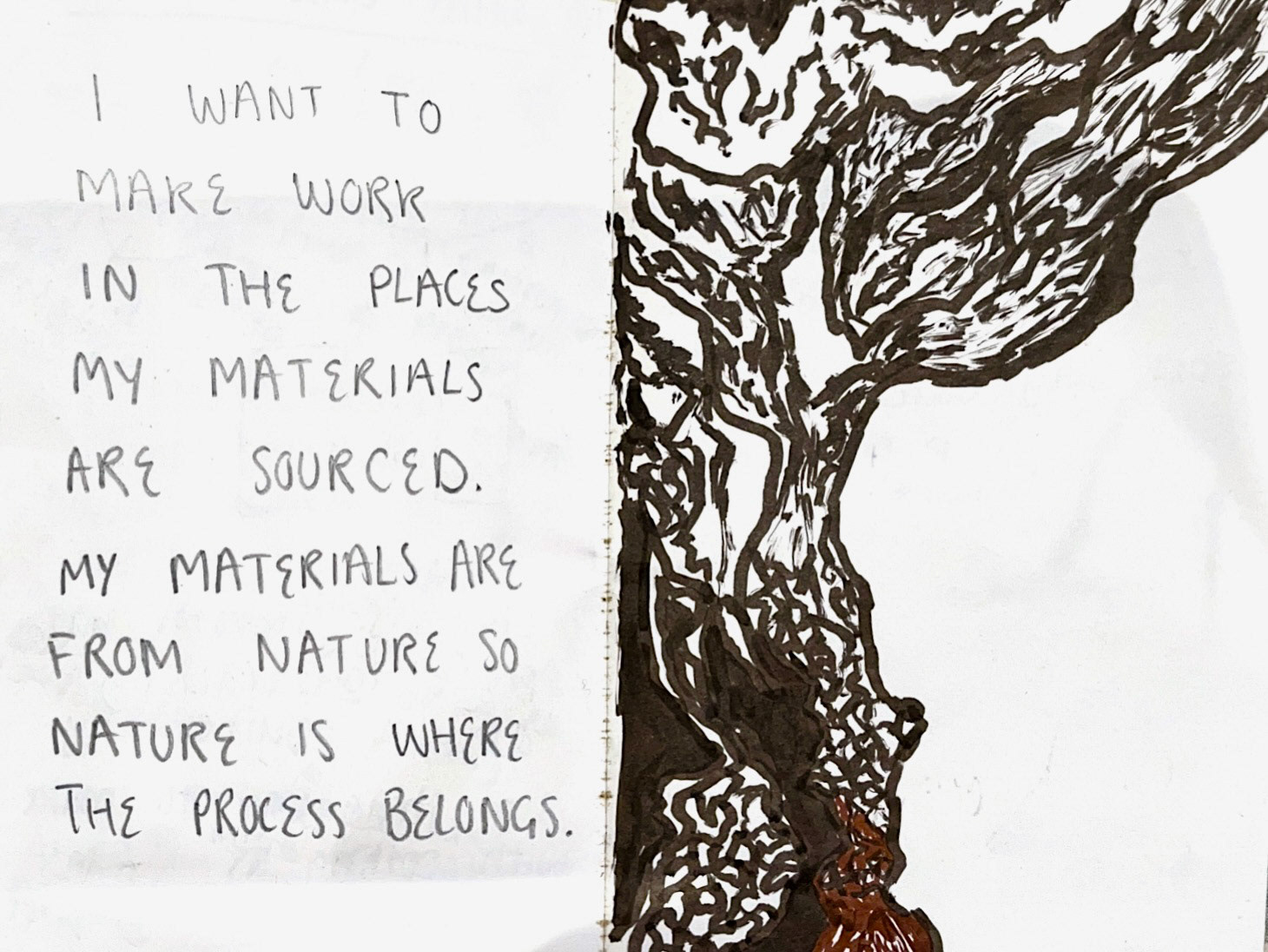
Photos from sketchbook: thought process
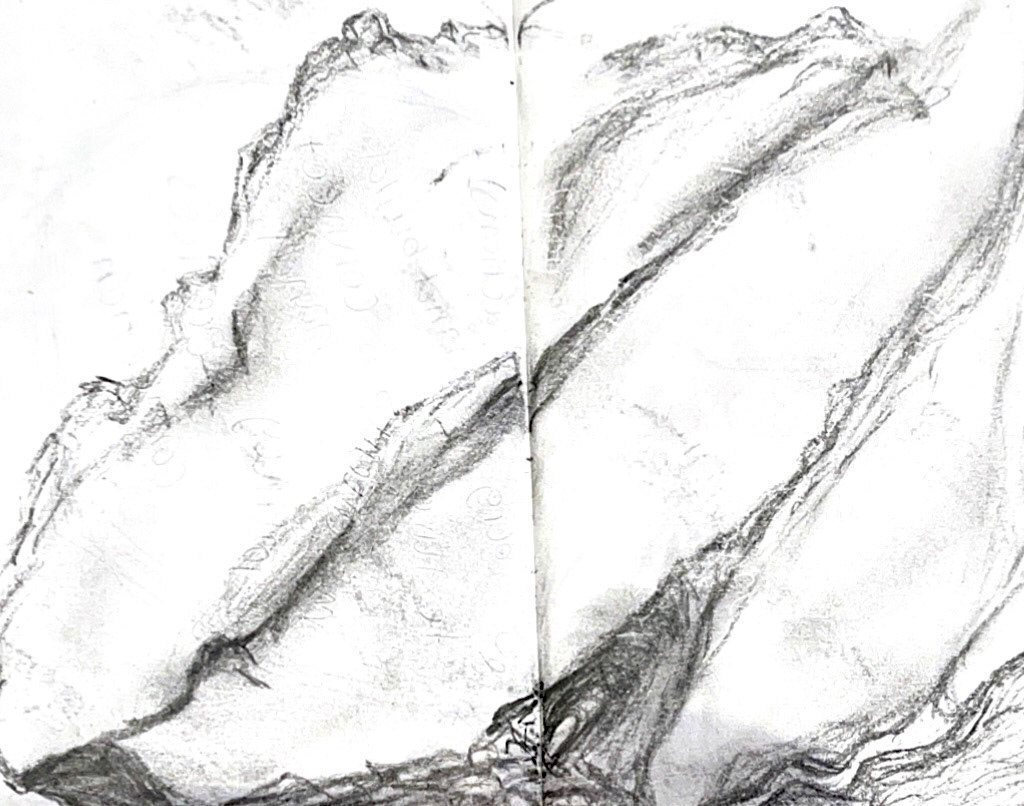
Sketching cave textures
I am keen on the idea of creating a workshop style product. Something that involves other people, not necessarily craftspeople, to get involved with making. My dad is someone that has been involved with this project quite a lot, due to being the person that I have been caving with, and that has taught me a lot about caving and has helped me with getting the clay from the caves. He knows the cave we go caving in very well, however has never, before now, thought anything much about the clay underground, as he is not a craftsperson. He hasn't worked with clay before and when he goes caving normally, he goes in order to discover new routes and to find new land.
With his consent, I have planned an informal, straightforward, making based workshop for the both of us to do, working with the clay that I have gathered from the caves, in the cave itself. The previous time I did this, when I made work underground by myself, was very successful and I enjoyed the process of it, so I believe that going back underground to teach my dad the skills of working with clay will also be successful.
This workshop is a chance to bring my project full circle. By caving with my dad, which is what started the project off, to gather the clay in which to work with down in the cave, I am leading a workshop to gather a collaborative understanding of the material that is formed underground.
Idea generation of workshop
I am planning a series of exercises to do as part of the workshop in the cave. I wanted to pick up on the senses, as it is a very different feeling being underground, and making underground than making in a typical workshop.
I want to convey how the cave is as much of a workshop as any, and that you can get a much better understanding of the clay and where the clay comes from by working in its natural habitat.
Equipment underground
I took my camera equipment underground to film the workshop I did with my dad. I wanted to document the equipment used when caving, as we have to take quite a lot underground, both when filming and reporting working in the caves and for safety reasons. There are lots of ropes and harnesses needed when abseiling down into the caves, and we have to use dry bags for all our equipment to ensure everything stays dry when caving, as there are often when we are crawling in pools of water.
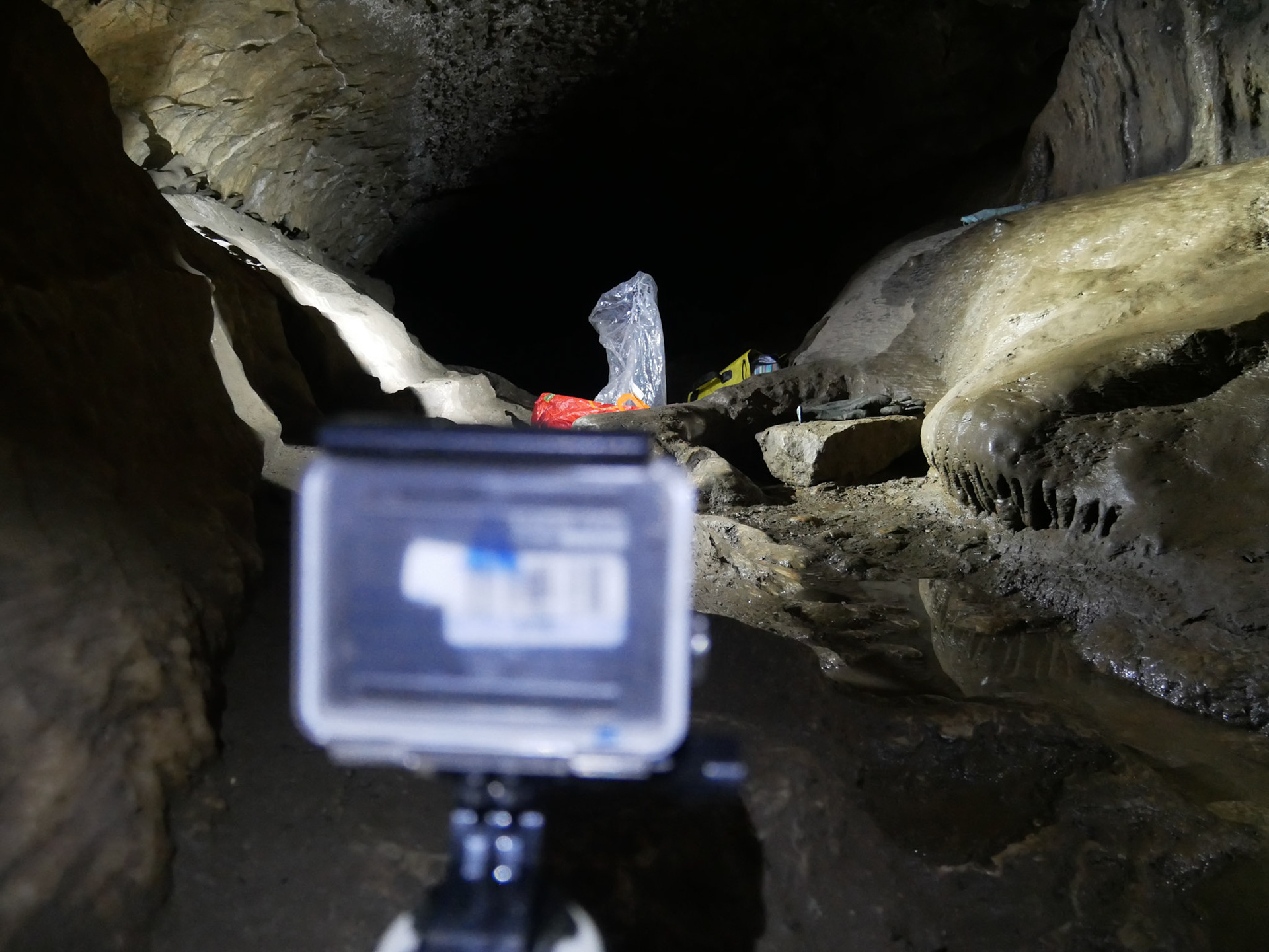
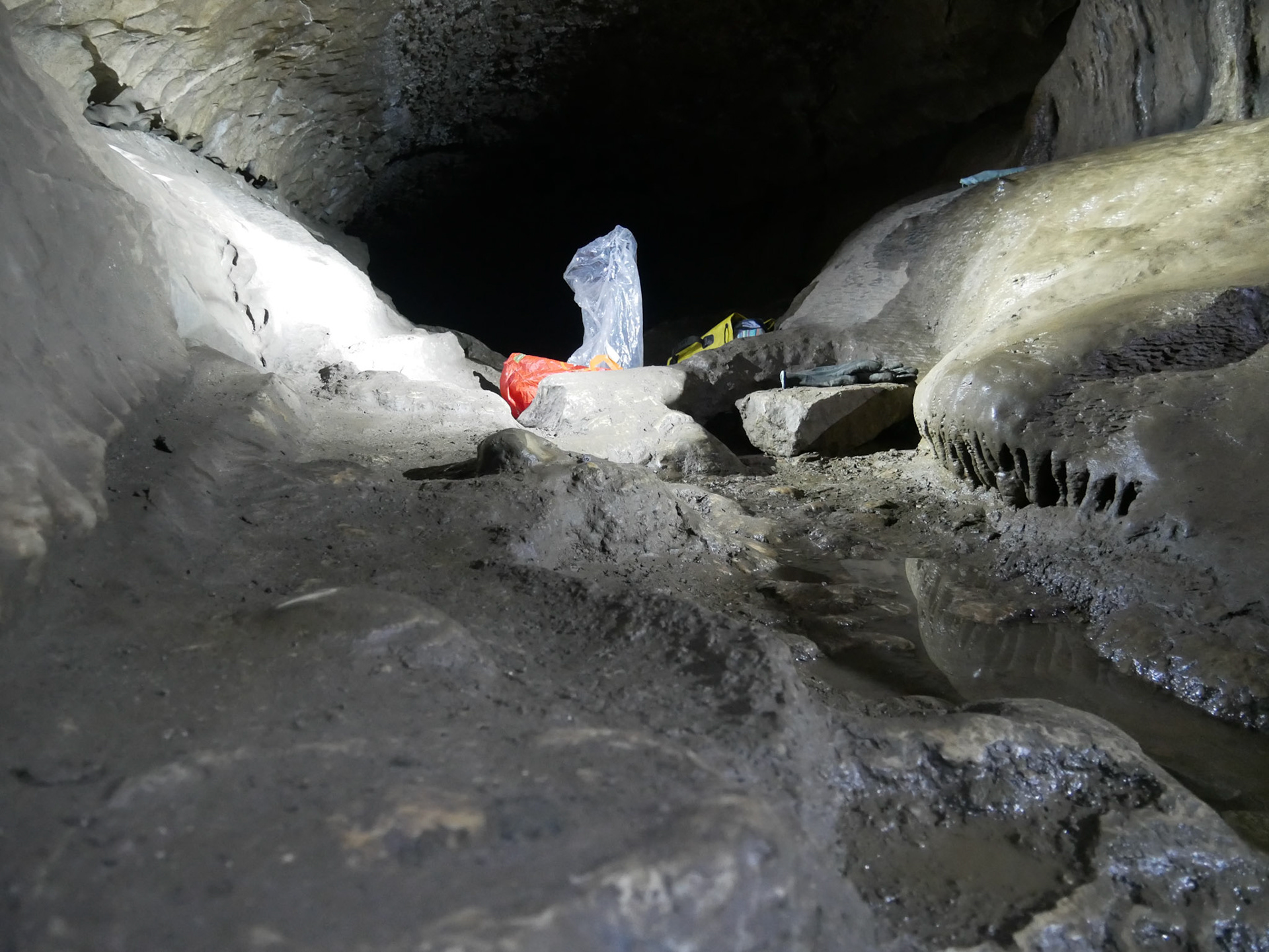

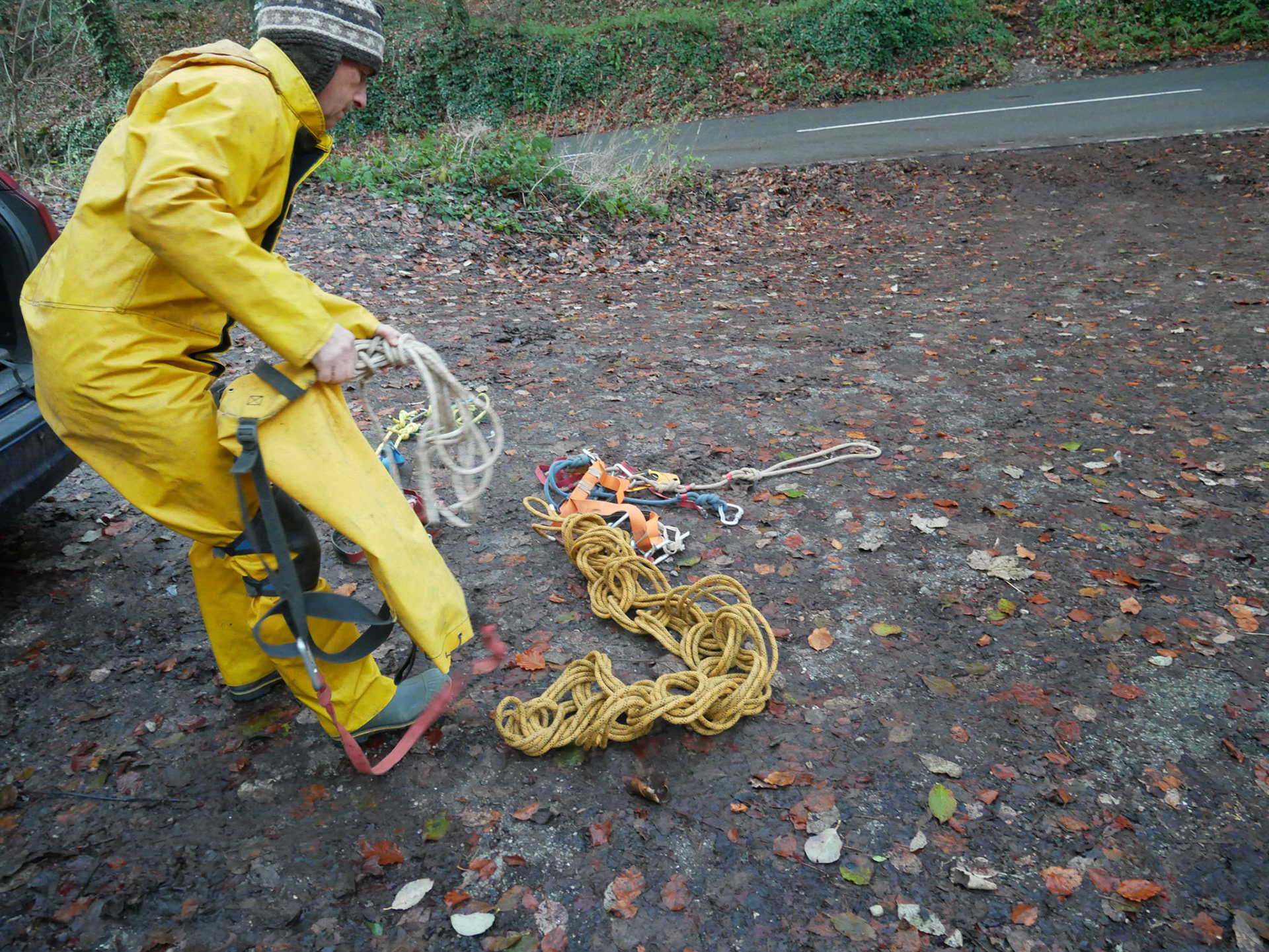
GoPro Timelapse
Video showing my dad and I working with clay underground. We are working with clay from this cave, that I dug up on a previous trip down the cave. This clay is dryer than the clay used straight from the ground, as it has had time to dry out.
We tested out some different techniques using the clay, both with the clay that was from the bag, that had been dried out, and also clay that we had dug from that spot, right then and there. We observed the differences between the two clays, and noticed that even though they are the same clay, because the clay that we were using that had just been dug up, it was much harder to work with as it was still very wet.
Clay through the senses
I wanted us to get to know the clay with using our senses. We listened to the clay in our hands, and because there is no noise in the cave, apart from us as we are the only ones down there, each sound is intensified. We could hear the clays air bubbles and the squelches of the clay as we were working with it in our hands.
My dad had never properly worked with clay before. So, to begin with, I wanted him to get a feel of the clay, and notice how it felt in his hands, rather than just walking on it, which is what he normally does when caving. We started by making small pinch pots, using the cave's rock as our surface. The rock was wet, from the condensation in the cave, which meant that it was harder to build with, as the clay was getting even more moisture in it.
I taught my dad skills such as coiling to make a pot, and showed him how to use traditional ceramics tools, which I use in the 'typical' workshop at university. It felt quite strange to bring my toolkit down underground to work with, as that is not its natural habitat, however it solidified the fact that a workshop really can be based anywhere.
Cave plans via Peak District caving
The website Peak District Caving has access to 3d models of the majority of caves in the Peak District. It is a great site which shows the plans and maps of each cave in the area. The different settings can show different levels of depth of the cave. I have taken screen grabs of these as I am going to be using the lines of the depths and recreating them with clay.
Slab of cave plans
I have created a textured slab, taking inspiration from the cave plans above. I wanted to get across the different levels of the depths of the cave, representing them through the clay. This is an abstract approach to the plans, and it is a sample test of what I am aiming to make in the caves.
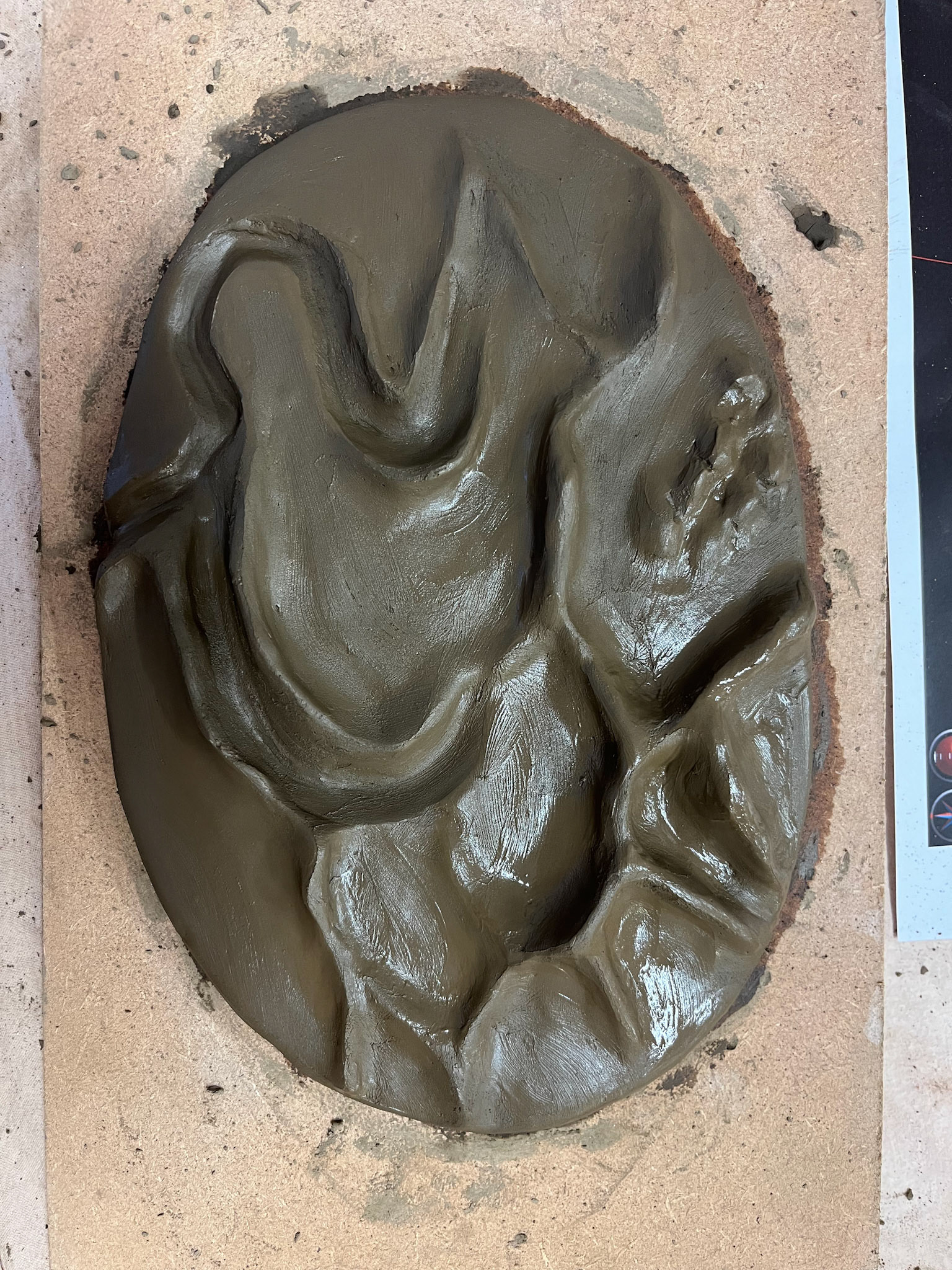
Making process
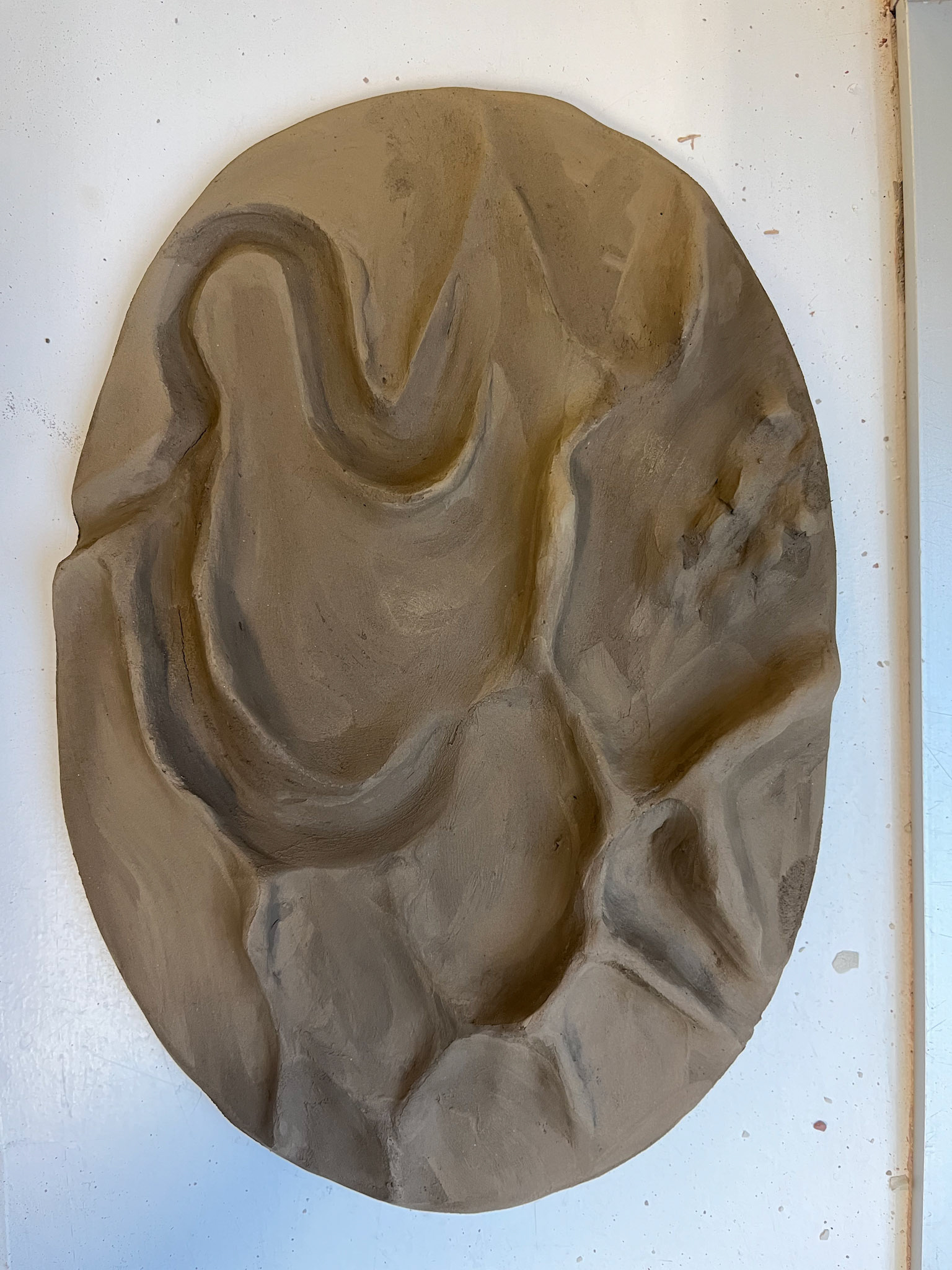
Leather hard stage
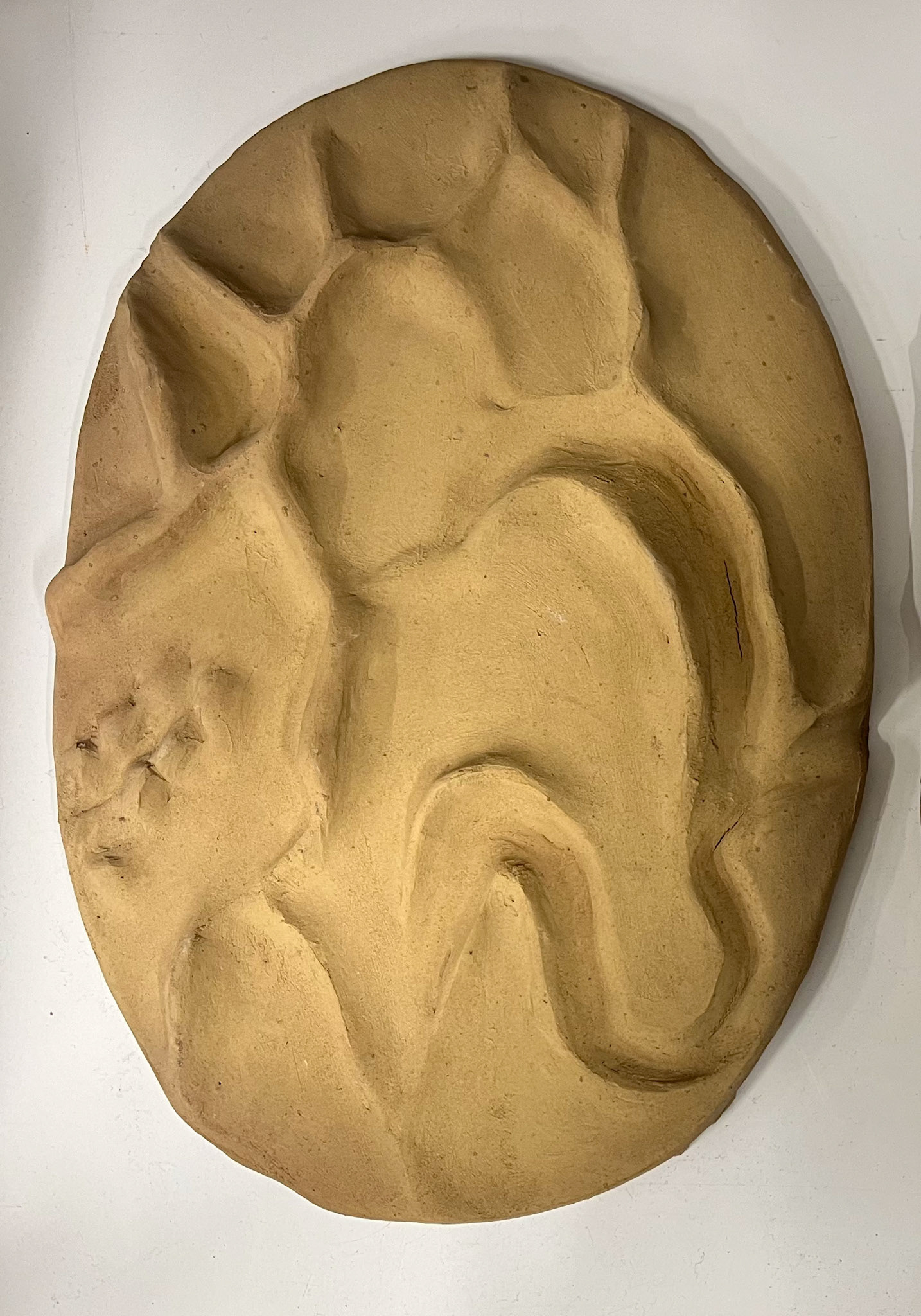
After firing
Final submission work
My final trip underground for this project was on the 4th of December, again guided by my dad. I drew on all the skills and techniques I had developed over the weeks to make three pieces of work in situ.
For my first piece, I wanted to explore how I got over my claustrophobia by purposefully working in a small, constricted passage of the cave. During all my underground trips, I had become fascinated by the play of light from my headtorch on the cave formations and wanted to use wild cave clay to partially block an opening between a rock formation, thereby creating a gap for a sliver of light to shine through. This piece was physically demanding to make as I was building with the clay whilst squeezed in a narrow space not much more than head height.
My second piece was created in a larger opening of the cave, so it enabled me to appreciate the larger caverns and shelves of the cave system. I wanted to give my dad the opportunity to play with clay in a free, uncontrolled manner, and together, we created three organic forms which reflect the tunnels and passageways between the solid rock.
The third piece was made in a wider passage of the cave. The intention was to focus on the contrasting textures visible in the cave, where there are smooth walls on one side and another side rippled flowstone. There may be jagged, sharp rocks and above our heads, there is a roof of fossils.
My work is inspired by the formations of the caves and their passageways, tunnels and textures. It is a reflection of what the caves look like and means to me and the experiences I have learnt from them throughout this project.
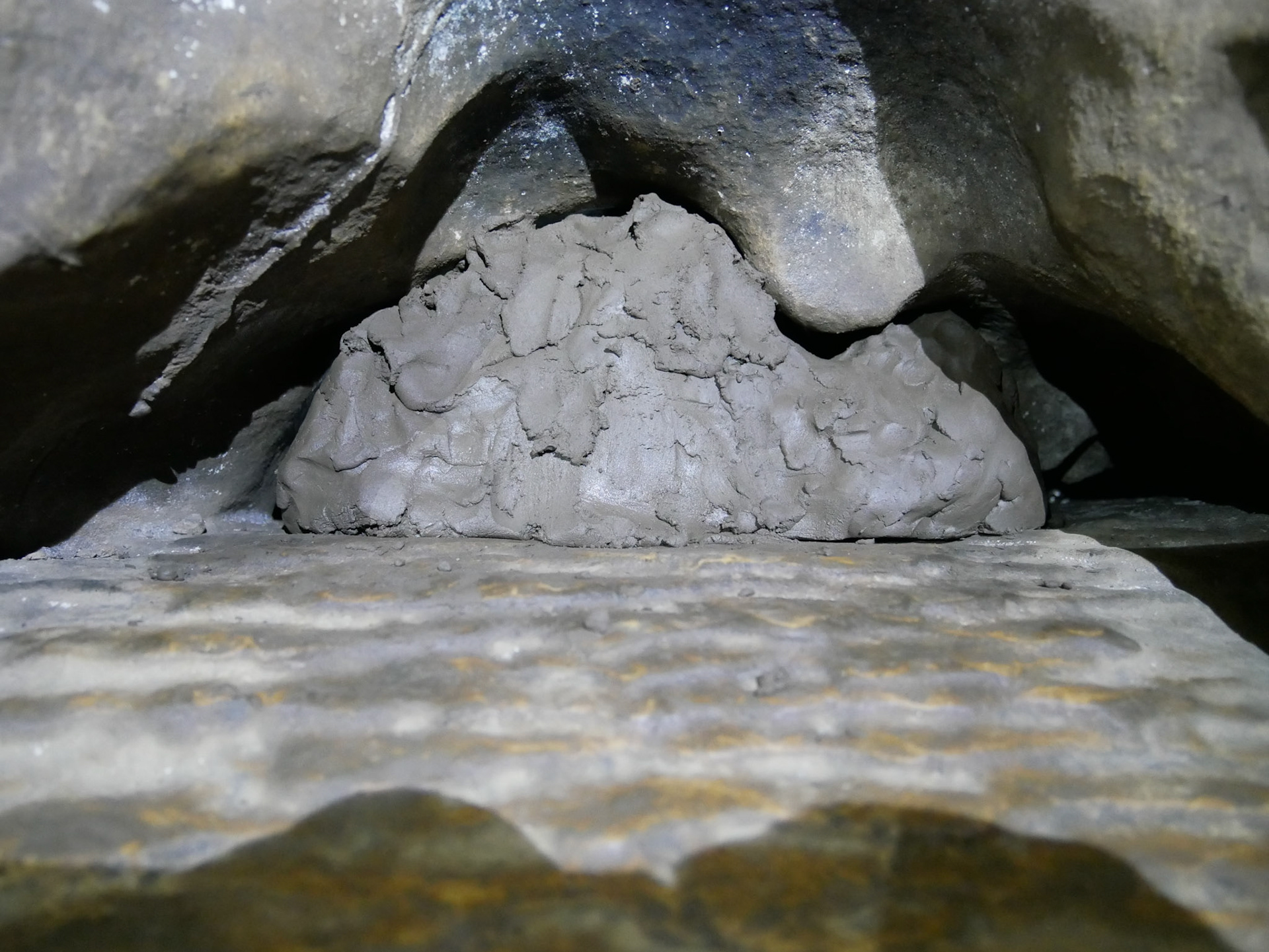
First piece
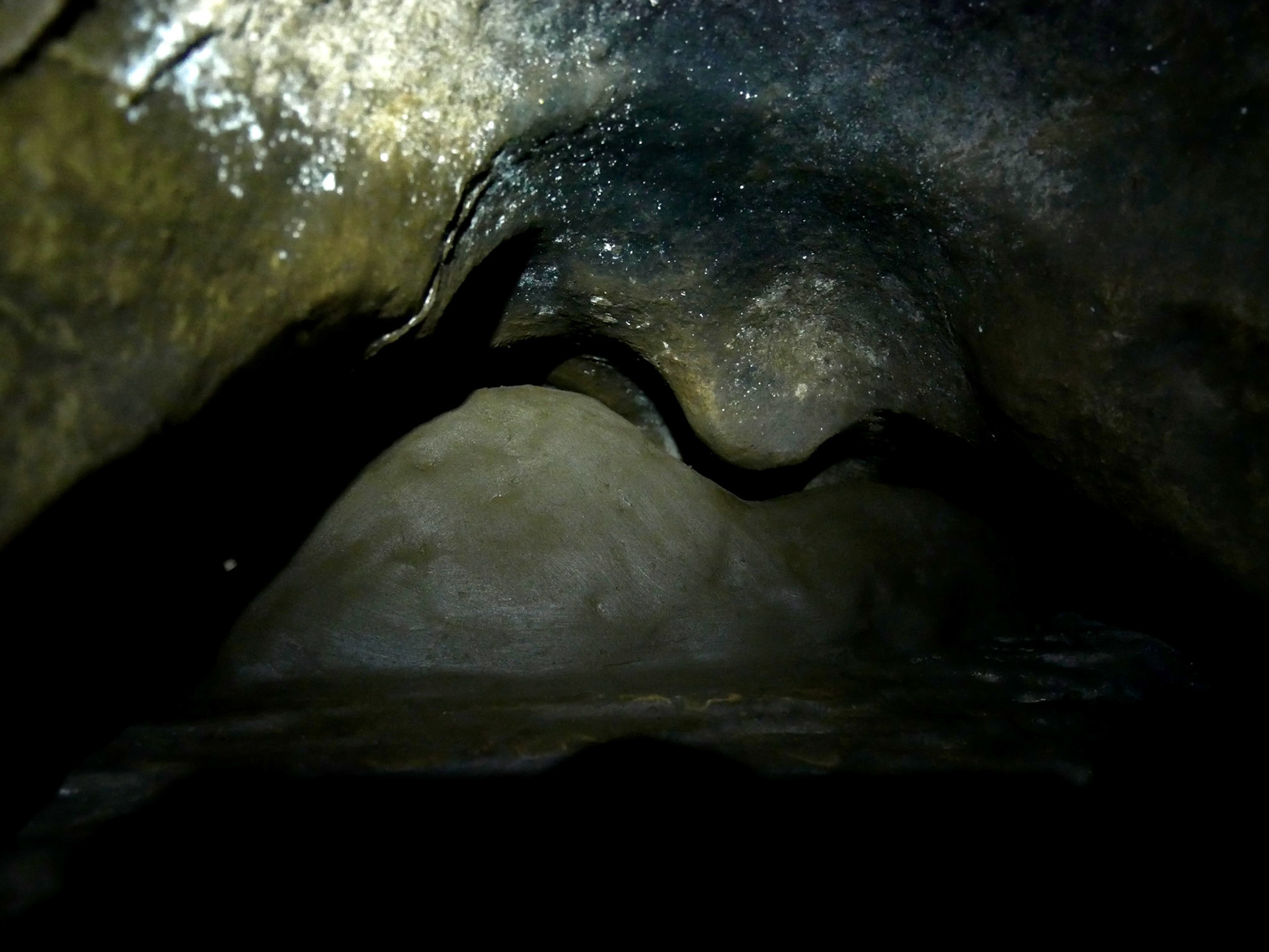
First piece
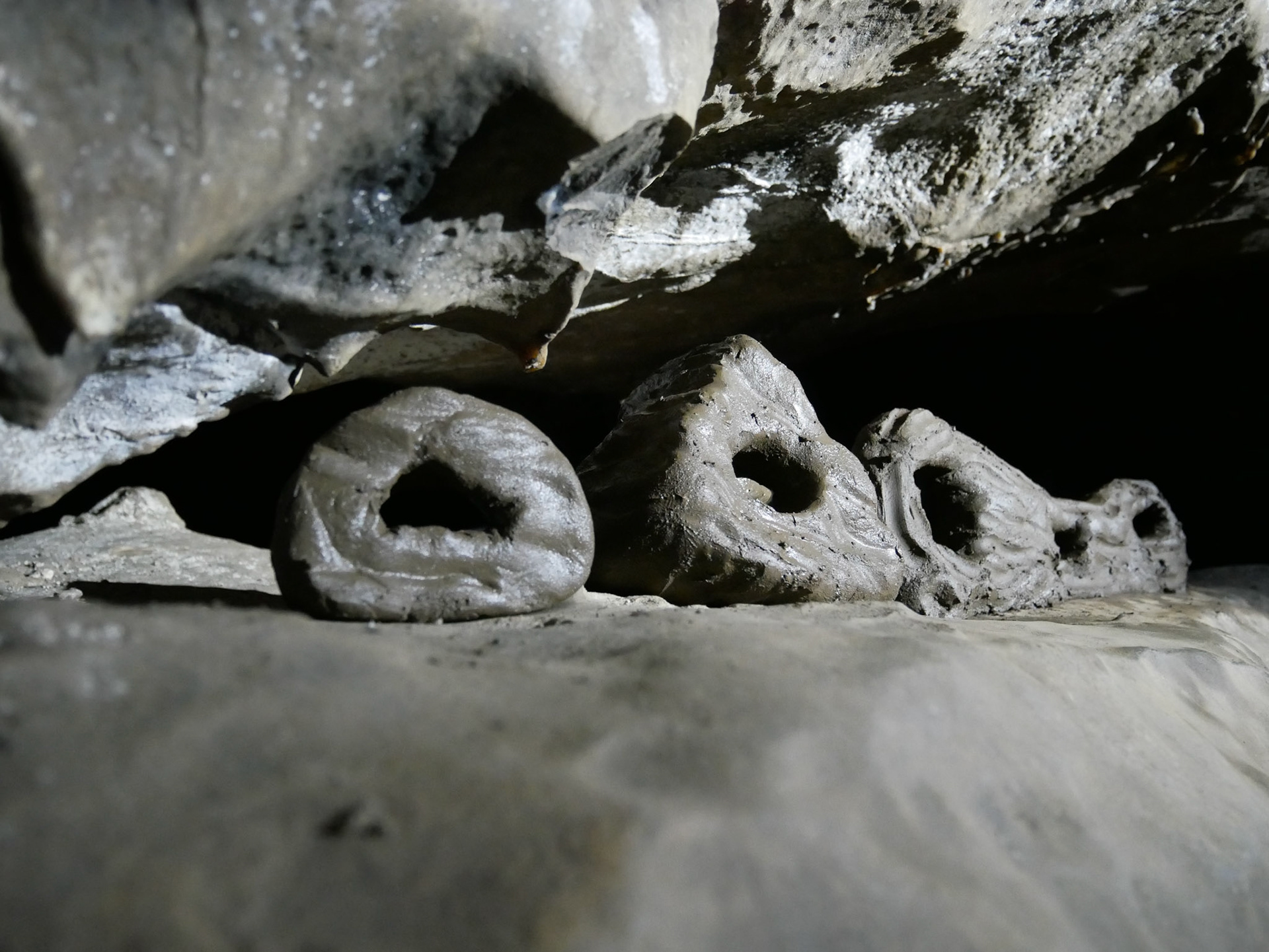
Second piece
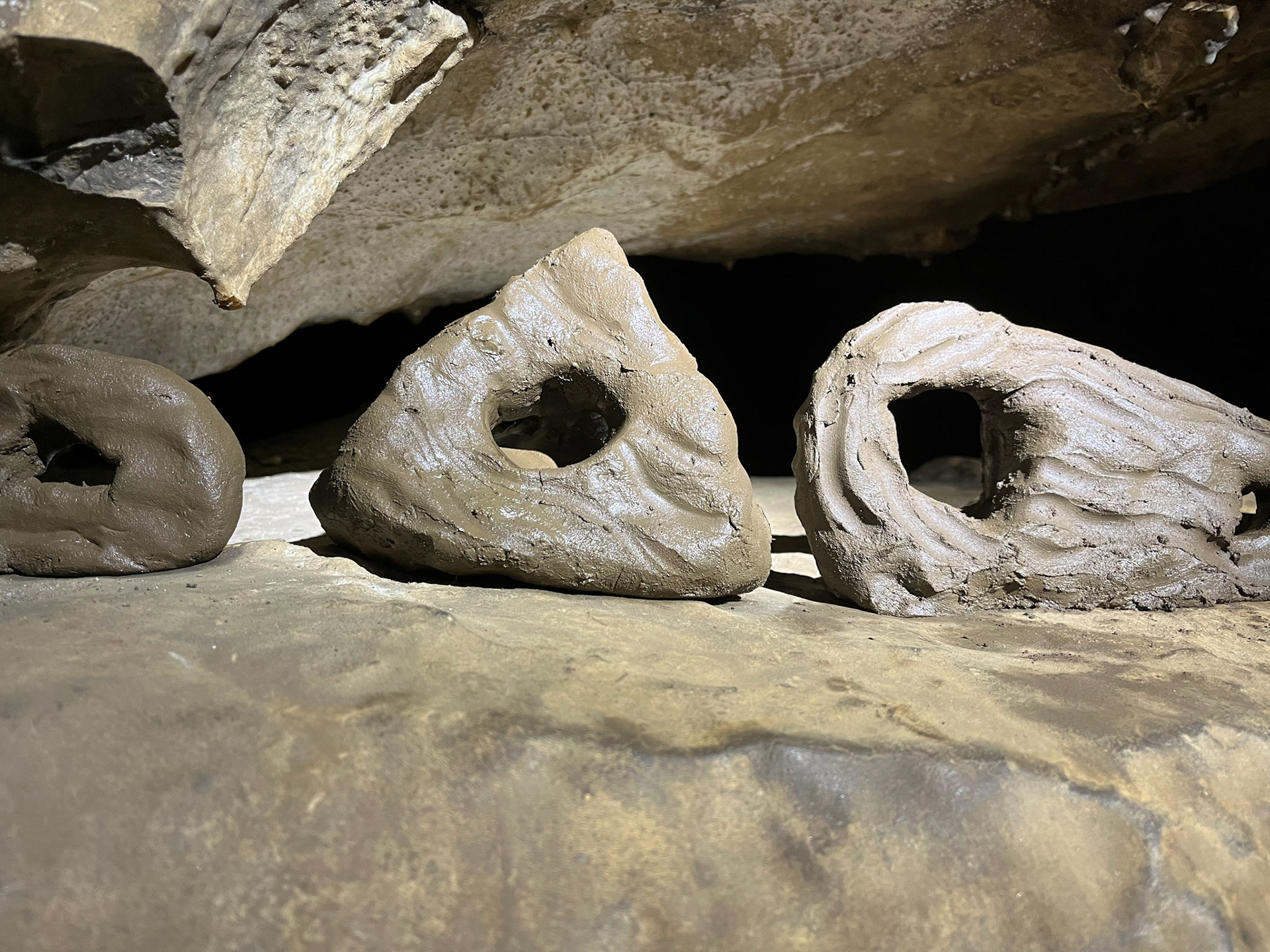
Second piece

Third piece

Third piece
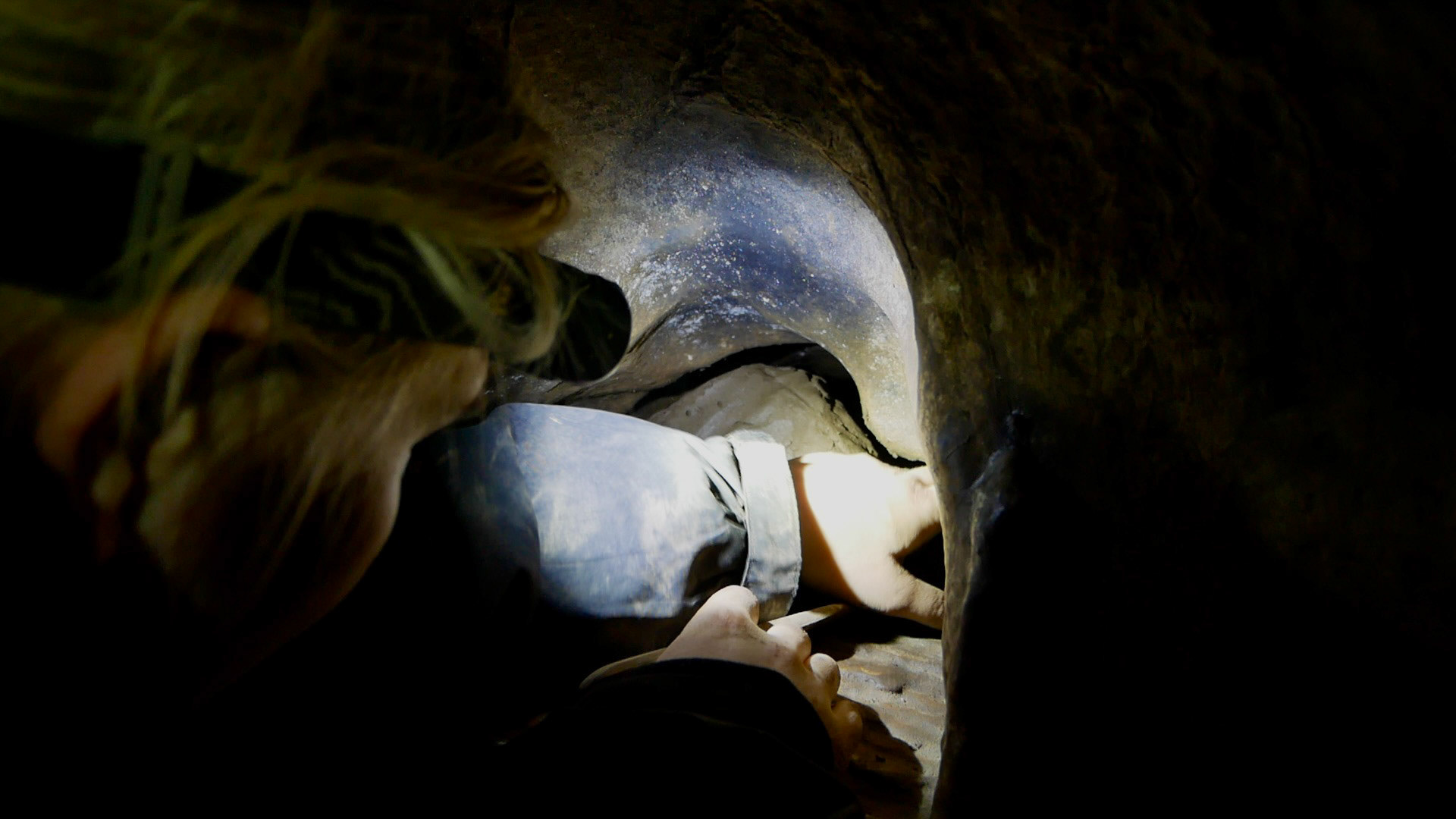
Making of first piece
To see the finalised photos for this body of work and also my short film to honour this project, please go to the page Down to Earth.

